



Curated by Rosa Menkman & Furtherfield.
Opening Event: Saturday 8 June 2013, 2-5pm
with Glitch Performance by Antonio Roberts at 3pm
Open Friday to Sunday 11-5pmContact: info@furtherfield.org
DOWNLOAD PRESS RELEASE
IMAGES OF THE OPENING ON FLICKR
READ Glitch as a Symbolic Art Form BY ROB MYERS
WATCH VIDEO OF THE OPENING
“The glitch makes the computer itself suddenly appear unconventionally deep, in contrast to the more banal, predictable surface-level behaviours of ‘normal’ machines and systems. In this way, glitches announce a crazy and dangerous kind of moment(um) instantiated and dictated by the machine itself.” Rosa Menkman [1]
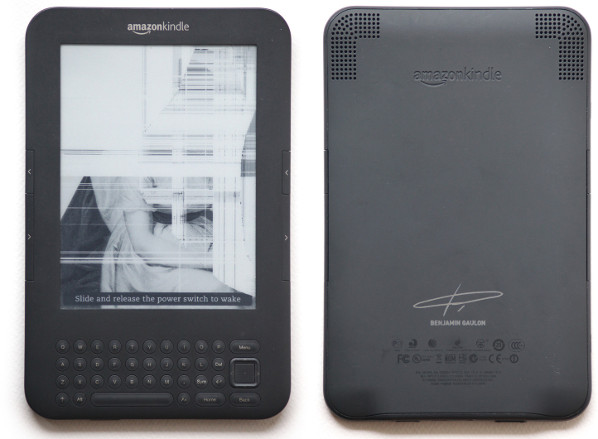
Glitches are commonly understood as malfunctions, bugs or sudden disruptions to the normal running of machine hardware and computer networks. Artists have been tweaking these technologies to deliberately produce glitches that generate new meanings and forms. The high-speed networks of creation and distribution across the Internet have provided the perfect compost to feed this international craze. The exhibition shows various approaches by artists hacking familiar hardware and their devices which include mobile phones, and kindles. They disrupt both the softwares and the digital artefacts produced by these softwares, whether it be in the form of video, sound and woven glitch textiles.
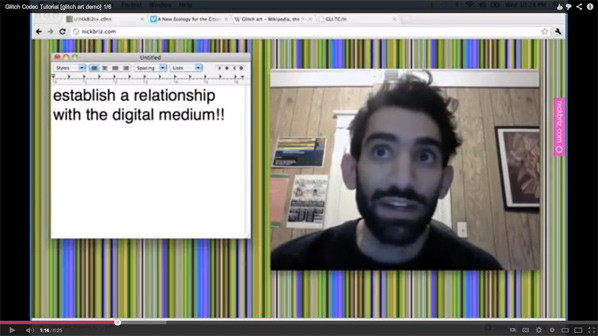
Glitch art subverts the way in which we are supposed to relate to technology, causing playful, imaginative disruptions. It is a low-tech and dirty media approach with a punk attitude. These artists appropriate the medium and forge expressions that go beyond what the mainstream art world expects artists to do, it is unstoppable – it is Glitch Moment/ums.
Copies of Rosa Menkman’s groundbreaking Glitch Art critique The Glitch Moment(um) will be available for purchase during the exhibition.
![numbermunchers from the untitled [screencaptures] series by Melissa Barron](http://www.furtherfield.org/wp-content/uploads/2013/04/melissabarton.jpg)
Empty Spinning Circle become Full (part b) (2012) from the Further Abstract series by Alma Alloro
One Square in colors (2012) from the Further Abstract series by Alma Alloro
untitled [screencaptures] (2010) by Melissa Barron
The Glitch Codec Tutorial by Nick Briz
KindleGlitched (2012) by Benjamin Gaulon
Thoreau Glitch Portrait (2011) by José Irion Neto
Copyright Atrophy (2013) by Antonio Roberts
What Revolution? (2011) by Antonio Roberts
Beyond Yes and No (2013) by Ant Scott
Glitch artists and enthusiasts are invited to add their work to GLI.TC/H 0p3nr3p0.net, a Glitch Art repository coded by and developed by Joseph ‘Yølk’ Chiocchi & Nick Briz. The submissions will be showcased during Glitch Moment/ums at Furtherfield Gallery. To include your work in the 0P3NR3P0 component of Glitch Moment/ums submit a link to any visually wwweb based file (html, jpg, gif, youtube, vimeo, etc.) and your piece will automatically be included in the line-up (one work per artist).
This new IRL exhibition has been organised in collaboration with Nick Briz and Joseph ‘Yølk’ Chiocchi.
SUBMIT && SHOW on 0P3NR3P0.NET.
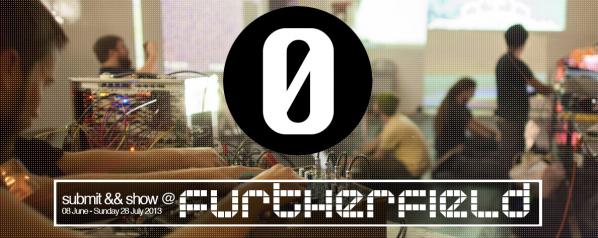
Alma Alloro
Alma Alloro (IL) is an artist, musician and performer from Tel Aviv. She is rooted in the backyard of popular culture using diversified media from drawing, installation, music, and animation to internet; her recent works focus on the correlation between old media and new media.
Melissa Barron
Melissa Barron is an artist living and working in Minneapolis, Minnesota. She studied at the School of the Art Institute of Chicago where she focused on new media and fiber. In her work she combines these two fields by reinterpreting hacked Apple 2 software through different fiber techniques. Her work has been shown at various international events, including the Notacon hack festival in Cleveland, Ohio, GLI.TC/H in Chicago and ISEA 2011 in Instabul.
Nick Briz
Nick Briz is a newmedia artist, educator and organiser based in Chicago IL. His work has been shown internationally at festivals and institutions, including the FILE Media Arts Festival (Rio de Janeiro, BR); Miami Art Basel; the Images Festival (Toronto, CA) and the Museum of Moving Image (NYC). He has lectured and organized events at numerous institutions including STEIM (Amsterdam, NL), the Museum of Contemporary Art Chicago, Marwen Foundation and the School of the Art Institute of Chicago. His work is distributed through Video Out Distribution (Vancouver, CA) as well as openly and freely on the web.
Benjamin Gaulon
Benjamin Gaulon is an artist, researcher and art college lecturer. He has previously released work under the name “Recyclism”. His research focuses on the limits and failures of information and communication technologies; planned obsolescence, consumerism and disposable society; ownership and privacy; through the exploration of détournement, hacking and recycling. His projects can be softwares, installations, pieces of hardware, web based projects, interactive works and are, when applicable, open source.
José Irion Neto
José Irion Neto is native of Santa Maria, in southern Brazil. His first contact with computers was in 1982 using a machine equivalent to Sinclair ZX Spectrum. He has an academic background in Media Advertising and worked for some years as a Graphic Designer. Today, he has been working with advertising only occasionally, focusing on creating posters, dedicating most of his time on developing Glitch Art. He has worked and researched Glitch since 2008.
Antonio Roberts
Antonio Roberts is a British digital artist whose artwork focuses on the errors and glitches generated by digital technology. Many people would simply discard such artefacts but Antonio preserves these errors and displays them as art. With his roots in free culture he develops his techniques using open source and freely available software and shares his knowledge through the development of software.
Ant Scott
Ant Scott (UK) is a glitch artist and co-author of the first glitch aesthetics coffee table book Glitch: Designing Imperfection (New York: MBP, 2009). His work is informed by cognitive distortions.
Rosa Menkman
Rosa Menkman is a Dutch visualist who focuses on visual artifacts created by accidents in digital media. The visuals she makes are the result of glitches, compressions, feedback and other forms of noise. By combining both her practical as well as an academic background, she merges her abstract pieces within a grand theory artifacts (a glitch studies), in which she strives for new forms of conceptual synthesis of the two. In 2011 Rosa wrote Glitch Moment/um, a notebook on the exploitation and popularization of glitch artifacts (published by the Institute of Network Cultures), organized the GLI.TC/H festivals in both Chicago and Amsterdam and co-curated the Aesthetics Symposium of Transmediale 2012.
Furtherfield Gallery
McKenzie Pavilion, Finsbury Park
London N4 2NQ
T: +44 (0)20 8802 2827
E: info@furtherfield.org
Furtherfield Gallery is supported by Haringey Council and Arts Council England
MOVABLE BORDERS: THE REPOSITION MATRIX workshop
organised by Dave Young
Saturday 18 May 2013, 1-5pm
BOOKING ESSENTIAL. Please register with Alessandra.
The devices that once populated the creepy dystopian futures of science fiction have broken through into our daily reality.
Drones of dozens of different types are becoming a part of everyday life. They scout our public (and private) spaces, carrying out surveillance or reconnaissance in the service of nation states and as unmanned robotic tools, armed with missiles and bombs, acting in defence of “national security”.
According to a European commission document drones will be commonplace in the skies within a decade. There are already many companies building these airborne, robotic spies for military and police use and this has “prompted concerns from civil liberties groups, who fear that the unmanned aircraft will result in more forms of surveillance.” [1]
During the three weeks of Movable Borders: Here Come the Drones! people are invited to view artworks and join a workshop by artists who are contemplating how drones are changing the way we see and relate to each other and the world around us.
Artworks and projects by Bureau of Inverse Technology (US & AU), Lawrence Bird (US), Patrick Lichty (US), Dave Miller & Gavin Stewart (UK), The Force of Freedom (NL) and Dave Young (NL).
Bit Plane by Bureau of Inverse Technology (Natalie Jeremijenko and Kate Rich) is an early artistic reflection on the relation between technology and surveillance and, as such it can be seen as a precursor to the emerging DIY surveillance video enabled by the new availability of drones. The bit plane is a radio-controlled model airplane, designed by the Bureau and equipped with a micro-video camera and transmitter. In 1997 it was launched on a series of sorties over the Silicon Valley to capture an aerial rendering. Guided by the live control-view video feed from
the plane, the pilot on the ground was able to steer the unit deep into the glittering heartlands of the Information Age.
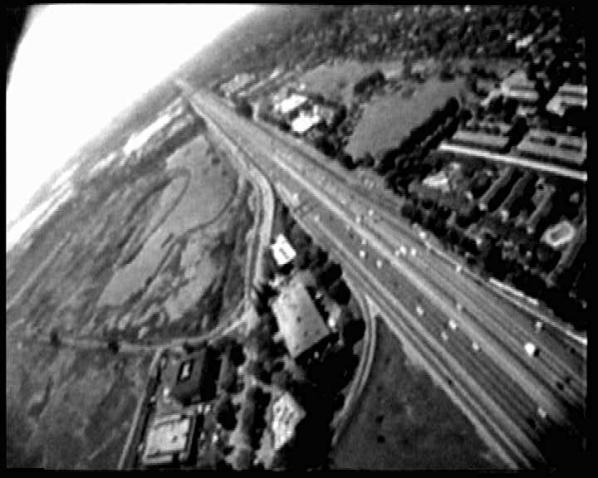
Parallel by Lawrence Bird uses Google Earth to track the 49th parallel, i.e. the prairie border between Canada and the United States. The digital projection invites open interpretations: it is a film about parallel countries; parallel modes of imaging and imagining; parallels between political, technical and visual territories. Obvious digital anomalies in the video, caused by satellite interference, allow for further speculation and imaginative readings.
The Private Life of a Drone by Patrick Lichty is a video travelogue recorded by flying video drones, exploring the area surrounding the Virginia Center for the Creative Arts in Amherst, Virginia (US).
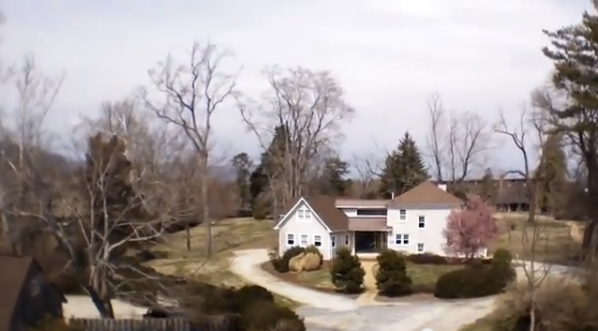
Lines by Dave Miller and Gavin Stewart draws on an emergent cultural interest in drones to explore related issues around privacy, mediation, power, security, morality, legality and others in all aspects of contemporary life. Lines aims to encourage and affect public debate.
TELEWAR is a book and video collaboration between Dave Young and The Force Of Freedom collective. The project tries to make some sense of the uses, effects and developments of the new warfare technologies, like military drones, through the analysis of news reports, military drone culture, drone speak and network theory.
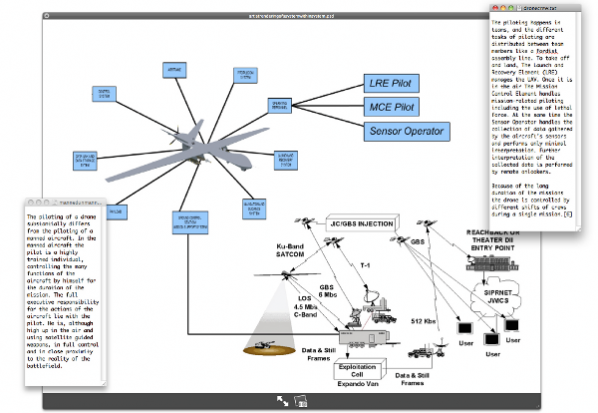
Movable Borders – The Reposition Matrix by Dave Young provides the central installation and information resource of the exhibition.
In a post-national age, where “territorial and political boundaries are increasingly permeable”[2], what has become of the borderline? How is it defined, and what technologies are used to control it?
Movable Borders is an ongoing research project that begins to explore possible answers to these questions through facilitating discussions around the ‘reterritorialisation’ of the borderline in the information age.
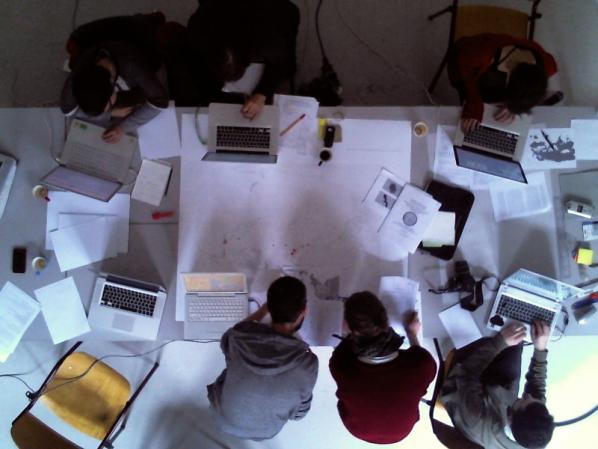
The Reposition Matrix aims to reterritorialise the drone as a physical, industrially-produced technology of war through the creation of an open-access database: a ‘reposition matrix’ that geopolitically situates the organisations, locations, and trading networks that play a role in the production of military drone technologies.
Alongside the installation Dave Young will be holding a workshop on the subject of drones on Saturday 18 May, 1-5pm – BOOKING ESSENTIAL. More info here.
Lawrence Bird
Lawrence Bird is a designer, instructor and writer with an interest in cities and their image. He has trained in architecture (B.Arch), social sciences and urban design (MSc), and history and theory of architecture (PhD). He has recently completed the SSHRC-funded postdoctoral project Beyond the Desert of the Real, based in Winnipeg, Canada. The project focused on desolate urban sites, elicited visual narratives from city residents and graduate students of architecture in response to them, experimented with representations of the city based on these narratives, and used these strategies as points of departure for urban design and urban landscape proposals. Lawrence also makes films, and is currently developing a hybrid film and animation project WPG_POV.
Bureau of Inverse Technology
The Bureau of Inverse Technology (aka BIT) is an organisation of artist-engineers whose stated aim is to be an information agency servicing the “Information Age”. Bureau engineers are involved from design to deployment and documentation of radical products based on commercially available electronic entertainment components such as cameras, radios, networks, robots, sensors, etc. Though its work has long been publicly available, the composition of the Bureau itself is shrouded in some mystery, for some years cloaking its identity in anonymity. In 2004 the Bureau initiated a “retreat from anonymity” when radio journalist and BIT co-founder Kate Rich took up a three month Research Fellowship at Piet Zwart Institute for Media Design Research, Rotterdam in 2004. Current Bureau products include BIT Radio, Feral Robotic Dogs and the Despondency Index.
Patrick Lichty
is a technologically-based conceptual artist, writer, independent curator, animator for the activist group The Yes Men, and Executive Editor of Intelligent Agent Magazine. He began showing technological media art in 1989, and deals with works and writing that explore the social relations between us and media. Venues in which Lichty has been involved with solo and collaborative works include the Whitney & Turin Biennials, Maribor Triennial, Performa Performance Biennial, Ars Electronica, and the International Symposium on the Electronic Arts (ISEA). Patrick also works extensively with virtual worlds, including Second Life, and his work, both solo and with his performance art group Second Front, has been featured in Flash Art, Eikon Milan and ArtNews. He is also an Assistant Professor of Interactive Arts & Media at Columbia College Chicago, and resides in Baton Rouge, LA.
Dave Miller
Dave Miller is a South London based artist and currently a Research Fellow in Augmented Reality at the University of Bedfordshire. Through his art practice Dave draws out the invisible forces that make life difficult. His work is about caring and being angry as an artist. His art enables him to express feelings about the world, to attempt to explain things in a meaningful, yet subjective way, and make complex information accessible. Recurrent themes in his work are: human stories, injustices, contentious issues and campaigning. Recently he has been very bothered by the financial crisis.
Gavin Stewart
Gavin Stewart is Lecturer in Digital Media at the University of Bedfordshire, poet and writer. He is the current convener of the Interactive Media Group. His research interests are the aesthetics of digital texts and the impact of corporate digital media on our understanding of community. Gavin is course leader in BA Media Production and currently teaches units in Media and Cyberculture and Print, Culture and Technology at MA Level. Gavin is is also the co-organiser of the Playful Paradox mini-festival, the End of Journalism conference and the Under the Mask: Perspective on the Gamer conference series.
The Force Of Freedom
The Force Of Freedom is a Rotterdam based collective founded by Micha Prinsen and Roel Roscam Abbing in 2009. In their work they react critically but playfully to new emerging technologies and developments on the internet.
Dave Young
Dave Young is an artist, musician and researcher currently studying the Networked Media course at the Piet Zwart Institute in Rotterdam (NL). His research deals with the Cold War history of networked culture, exploring the emergence of cybernetic theory as an ideology of the information age and the influence of military technologies on popular culture.
Furtherfield Gallery
McKenzie Pavilion, Finsbury Park
London N4 2NQ
T: +44 (0)20 8802 2827
E: info@furtherfield.org
Furtherfield Gallery is supported by Haringey Council and Arts Council England.
Featured image: Five Thousand Feet is the Best by Omer Fast.
In perusing Honor Harger’s recent missive on drone aesthetics and James Bridle’s ongoing posts of drone images at Dronestagram, taken in context with the Glitch un-conference in Chicago, some new questions have come to mind. These questions have to do with conceptions of New Aesthetics in its various forms in terms of interaction with the program/device and its level of autonomy from the user. In my mind, there seems to be a NA continuum from generative programs that operate under the strict criteria of the programmer to the often-autonomous actions of drones and planetary rovers. As you can see, I am still chewing on the idea that The New Aesthetic as it seems to be defined, as encompassing all semi-autonomous aspects of ‘computer vision’. This includes Glitch, Algorism, Drone imagery, satellite photography and face recognition, and it’s sometimes a tough nugget to swallow that resonates with me on a number of levels.
First, image-creating technological agents are far from new, as Darko Fritz recently stated in a talk that algorithms have been creating images, in my opinion, within criteria of NA since the 60’s, and pioneers like Frieder Nake, A. Michael Noll, and Roman Verostko have been exploring algorithmic agency for decades. If we take these computer art pioneers into account, one can argue that NA has existed since the 60’s if one lumps in genres like Verostko’s ‘style’ of Algorism or the use of algorithms as aesthetic choice. A notch along the continuum toward the ‘fire and forget’ imaging (e.g. drones) is the Glitch contingent, which is less deterministic about their methodologies of data corruption aesthetics by either running a program that corrupts the media or they perform digital vivisection and watch what little monster they’ve created. Glitchers exhibit less control over their processes, and are much more akin to John Cage, Dada or Fluxus artists in their allowance of whimsical or chance elements in their media.

However, as we slide along the spectrum of control/autonomy from the lockstep control of code to the less deterministic aesthetics of face recognition, drone imaging, robotic cameras, Google Street View cams, Mars Rovers and satellite imaging, things get murkier. Autonomic aesthetics remind me of the ruby-hued Terminator T500 vision generated by intelligent agents running the ‘housekeeping’ on the machine platform. I consider this continuum from Algorism to Glitch to autonomous robotic agents under an NA continuum of aesthetics is important insofar as it defines a balance of agency between the operator and the ‘tool’. For me this is the difference between the high degree of control of the Algorist, the ‘twiddle and tweak’ sensibility of the Glitcher, and the gleaning from the database of pseudo-autonomous images created by Big Imaging created by drones and automatic imaging. Notice I use the term ‘pseudo’ in that there are operators flying the platforms or driving the car, while the on-board agents take care of issues like pattern/face recognition and target acquisition. We also see this in Facebook, as recent technological changes as of 2012 have introduced face recognition in the tagging of images. From this, a key issue for me in this discussion of what began as a nebulous set of terms (the criteria of NA as defined by the global conversation) is that of agency and autonomy, and how much control the New Aestheticist gets in the execution of their process. Another important point is that I am not calling the ‘New Aestheticist’ an artist or curator, but something in between, but I’ll get to that later as this is also an issue of control of intent.
Back to this idea of autonomy between the subject, the ‘curator’ and the viewer, what interests me is the degree of control or not that the person creating, tweaking, or gleaning the image has over the creation or contextualization of that image. In the case of the Algorist, this is the Control end of the spectrum, where the artist takes nearly full control of the process of creation of the image, unless there is a randomization function involved in the process, and that it itself is a form of control – very Cybernetic in nature. Agency is at a maximum here, as the artist and machine are in partnership. Roman Verostko is a prime example of this, as he explores intricate recursive images created by ink pen plotters using paints in the pens. What he, and the AI-driven AARON, by Harold Cohen, for that matter, are machine painting.
The next step down the autonomy spectrum would involve the use of ‘glitch’ tools and processes that distort, disturb, and warp digital media. The process involves executing a given intervention upon the medium, such as saving it improperly, hex editing its code to corrupt it, or as Caleb Kelly writes, ‘crack’ the media. There are differing degrees of disturbance of the media to inject chance processes into it, from a more ‘algoristic’/programmatic application of programs upon the media to directly changing the internal data structure through manipulating the information through hex code and text editors. The resultant process is an iterative ‘tweak and test’ methodology that still involves the user in the process to varying degrees. Of course, the direct manipulation of the data with a hex editor is the most intimate of the processes, but there is still one factor to account for. The factor in question is that there is the set of causes and effects that are set in motion when the artist/operator opens the media and the codec (Compressor/DECompressor) mis/interprets the media, as is intended by the artist.
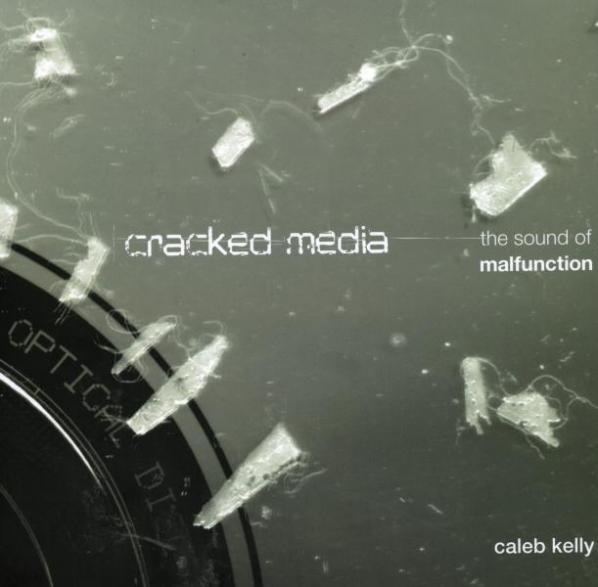
If we are to look at the glitch process, we can say that there is a point of intervention/disturbance upon the media, which is entirely a function of control on the part of the user. Afterwards, it is set loose into the system to allow the corruptions within the media to trigger chance/autonomous operations in its interpretation in the browser, etc. This is where the glitcher straddles the line between control and autonomy, as they manually insert noise into their media (control), then the codecs struggle with the ‘cracked’ media (autonomy). The glitcher, then, has the option to try a new iteration, thereby making the process cybernetic in nature. In Glitch, there is a conversation between the operator, the media and the codec. With the aesthetics created by drones, algorithmic recognition software, and satellite reconstructions, the process is far more autonomous/disjoint, and the New Aestheticist has to deal with this in the construction of their practice.
In the genre that I will call ‘mobEYEle’ imaging, the robot, satellite, or parabolic street eye abstracts from the ‘artist’, aptly turning them into an ‘aestheticist’, as their level of control is defined as that of a gleaner/pattern recognizer from the image bank of Big Data. Rhetorically speaking, we could say that a connection between the aestheticist and the generator of the image would be less abstract if, say, a New Aestheticist were to be in the room with a drone pilot, conversing about points of interest. It is likely that a military remote pilot and a graphic designer would have sharply differing views as to what constitutes a ‘target of interest’. Like that’s going to happen…
Therefore, let us just say that the collaboration of a New Aestheticist and a drone pilot is nightly unlikely, and that the New Aestheticist is therefore abstracted from the decisions of command and control involved in acquiring the image that eventually gets in their hands. This, however, presents us with two levels of autonomous agency, one human and one algotrithmic. But before I expand on this, I would like to discuss my decision to call the practitioner an ‘aestheticist’ as opposed to an artist or curator.
This decision rests on what I feel is the function of the aestheticist, that is, to glean value from an image and ‘ascribe’ an aesthetic to it. This position puts them in a murky locus between artist and curator, as they have elements of neither and both. For example, does the drone-image NA practitioner create the image; are they the artist per se, of the image? No. Although they are more closely aligned to curatorial practice as they collect, filter (to paraphrase Anne-Marie Schleiner), and post on tumblrs and Pinterests? From my perspective, the role of a curator is the suggestion of taste through and informed subjectivity through ecologies of trust and legitimacy, but the social image aggregator, although they might want to perform the same function, has no guarantee of accomplishing this unless they develop a following. Therefore, under my definition, they are neither creators nor taste-makers in the traditional sense, so what makes sense is to call them ‘aggregators’ of aesthetic material and thus my term ‘Aestheticist’.
Returning to our conversation, the drone aestheticist, then, is subject to one of two degrees of completely abstracted autonomy of the creation of the image; that of the operator or that of the algorithms operating the drone. The abstraction surrounding the human operator is easiest to resolve, as the images of interest are either the preference of the drone operator or those created by the operator under the parameters of the mission, and not the results of a New Aestheticist’s joyride on a Global Hawk. It is merely someone else’s volition selecting the image, and a confluence of personal interest deciding as to whether the image deserves to be on the New Aestheticist’s social imaging organ. However, it is the drone’s algorithmic image acquisition system that creates a more alien perspective in regards to aesthetics and autonomy of the image.
Compared to the Algorist or the Glitcher, all loosely placed under the banner of New Aesthetics, the Drone/Big Data Aestheticist is most problematic, as they are a fetishizer of sheer command and control operations that are potentially utterly abstracted from the pilot/driver’s volition. This creates a double abstraction through first the pilot, and then the algorithmic recognition system. There is no cybernetic loop here at all, as the gleaning of the item of interest from the beach of Big Data is twice removed from any feedback potential. Secondly, as I have written before, the Drone Aestheticist is exactly that, a gleaner of interesting images for use on their social image site, which in itself is a bit of an abject exercise.
Or is it? For example, if one is to say that the Aestheticist gleaning the images does so without intent or politics, and is merely operating on fetish/interest value, then this is perhaps one of the least interesting practices in New Aesthetic practice. But on the other hand, if one looks at the work of practitioners like Jordan Crandall, Trevor Paglen, or Ricardo Dominguez, who examine the acquired image as instrument of aggression, control, and oppression, this puts a new lease on the life of the Drone Aesthetic. In a way, though inquiry, there is an indirect feedback loop established in questioning the gaze of the device, its presence, and its function in its theater of operations. The politics of the New Aesthetic emerges here, in asking what mechanisms of command and control guide the machine eye and determine its targets of interest. This is of utmost importance, as the abstracted eye is guided without subjectivity or ethics and is determined solely by the parameters of its algorithms and the stated goals of its functions.
Is the aesthetic of the machine image merely a function of examining its processes, fetishizing its errors, or something else? The criteria of the New Aesthetic attempts to talk about a spectrum of digital imaging that stretches back into time far longer than 2010, and has a problematically broad sense of definition. Once these problems are set aside as a given, one of the key criteria for the evaluation of NA practice and the function of its images depends upon the degree of control and autonomy inherent in the process within the creation of the image. This is formed in a continuum of control and abstraction from Algorism and Generative Art to autonomous eyes like drones and satellites. Algorism is one of the oldest NA practices, and exhibits the closest relationship between artist, machine and determinacy of digital process. A greater degree of indeterminacy is evident in the Glitch, but the iterative process of tweaking the media and then setting it forth into the process of interpretation by the codec, foregrounds the issue of digital autonomy.
The eye of the unmanned platform abstracts creation from the human organism at least once if a human does not operate it remotely, and twice if it is. There is the Terminator-like fear of the autonomous robot, but at this time, perhaps the more salient questions regarding what I have qualified as drone/autonomous aestheticism under NA of what the function of the image is, and is it really that interesting? Are the practices of NA blurring artistic and curatorial practice into a conceptual aestheticism, creating a cool detachment from the image despite its source or method of creation? Is the bottom line to the genres of NA the degree of control that the artist or aestheticist has over the image’s creation or its modality/intent? It seems that NA is an ongoing reflection upon the continuum of control over the generation of the image, our beliefs regarding its aesthetics, and what the intentions or politics are behind the creation of the New Aesthetic image. Or, as I have written before, are we just pinning images from Big Data and saying, “Isn’t that kinda cool?”
Maybe it’s somewhere in the middle of intention and cool.
Featured image: Journey to Ard al Amal (The Land of Hope). Screenshot box & video installation. Impakt festival & exhibition. Image Pieter Kers
Foundland, Ghalia Elsrakbi (SY) and Lauren Alexander (SA), is a multi-disciplinary art and design practice based in Amsterdam. With backgrounds in graphic design, art and writing Foundland’s approach focuses on research based, critical responses to current issues. While moving around in advertising, printed matter, the Internet, and off line art spaces they dig up interesting stories about Disney, SpongeBob and defected soldiers.
Annet Dekker: Where does the name Foundland come from, or what does it mean?
Lauren Alexander: We started working together in 2009 and at the time we had worked on a project about being stateless, so Foundland seemed fitting. It is quite literally a way of thinking about how to found a land and to create a space that we could use as a platform for thinking about ideas with some kind of visual output. For us, space is related to political scenarios, and also to something virtual, online, all these different places that we inhabit.
Ghalia Elsrakbi: Foundland relates also to finding and discovering something new, looking behind something. We are very interested in speculation, we speculate about images and their meaning, in order to find something unexpected.
AD: What is your focus, what are you trying to find and tell?
LA: We want to tell stories in new ways, because by telling a story in a different way, especially related to subjects which are often seen in the media, you are offering an alternative perspective.
GE: The exhibition we just did for Impakt festival is a good example. With the installation Journey to Ard al Amal (The Land of Hope) we speculated how popular characters and animations, dubbed from Japanese to Arabic, or adapted from Walt Disney, play a valuable role in imagining heroes and villains. We were looking at a history of cartoons. This isn’t obviously political, but when seeing how cartoons are used in Syria and other places, interesting issues came up and we constructed a story that reflected on the current situation. We looked for connections between the way people see cartoon characters now and how they are embedded in childhood memories. In the end what we present is a kind of imagined picture of how things could be, maybe as an alternative to watching the news.
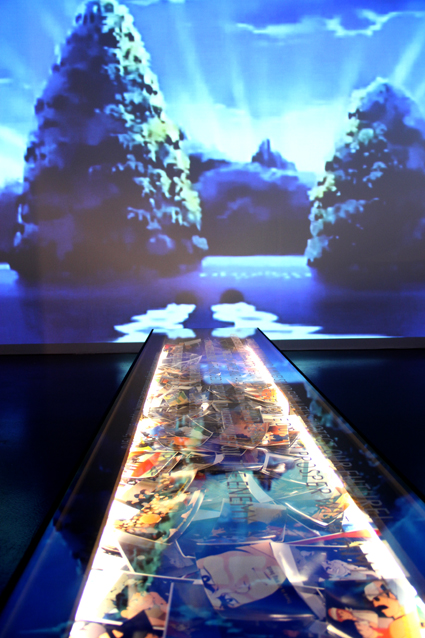
AD: Can you elaborate a bit, what images did you see and how did you (re)use them?
LA: In the installation we focused on this specific case study of the apocalypse scenario which is sketched in a cartoon series called Adnan and Leena in Arabic. In an earlier research essay Simba, the last Prince of Ba’ath country, we extracted images and characters from Arabic websites and speculate on appropriation by showing original images, before they were photoshopped. In a talk we did, we were also drawing connections to the way that Western cartoon characters are suddenly popping up in news footage, and how activists use cartoon identities on the Internet.
GE: Currently there is a full swing of the way Western stories are adapted. For example images of Mickey Mouse or SpongeBob are painted on walls in Syria. In the talk we question whether it is still Mickey Mouse that we see, the one that we remember from our children books, or if it means something else? We compared and related these images to the way such iconography is appropriated and used by both activists and ruling parties. The reuse of symbols and images and how sometimes historical moments are turned into something completely different is very interesting. Such findings are what we are really focusing on.
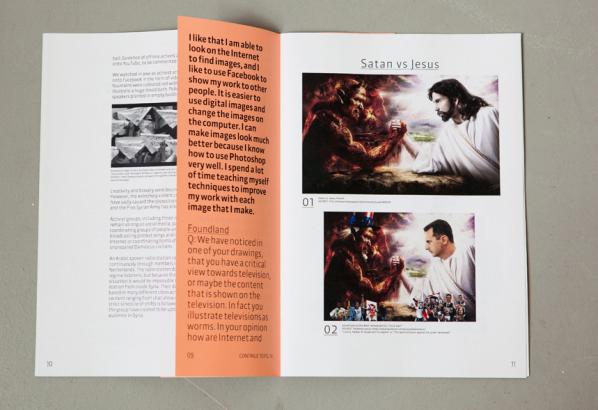
AD: There is also a long and popular tradition of autonomous animation in middle east, how does that relate to what you’ve been researching?
LA: Cartoons are very differently perceived in Syria, and also in South Africa, unlike in the Netherlands, they pose a huge threat to those in charge. For example the government is continuously suing political cartoonists like Ali Farzat in Syria and Zapiro in South Africa because their cartoons undermine existing power structures.
GE: There are indeed many artists who create political cartoons or satirical statements but with these Disney cartoons it was about finding the hidden story of an image. We recognise the cartoons from a Western perspective and the local one. By making connections and telling a different story we want to give a different perspective and a better understanding of what is really happening. Actually I grew up with Japanese Manga, but today Disney is everywhere. This is also political because in the time that Hafez Al-Assad was running Syria there was no American culture at all, when he died his son opened the country a bit for the Western market and you started to see American programmes. Nevertheless, everything is dubbed to Arabic so children don’t necessarily view it as an American production because it speaks their own language and sometimes stories and words are changed in order to better relate to Arabic countries.
LA: The connection to America is not obvious, what we found is that characters like SpongeBob and Mickey Mouse are simply friendly characters. They are your buddy, they help and like you.
GE: That is why they are used in this process of freedom fighting. ‘Your friends’ carrying the freedom flag and are used to create a kind of identification with the message that they want you to see. I mean, it is difficult to hate or not to trust these images because they are icons of friendliness. Whereas the image of a politician or some other hero who is telling a personal story can easily be damaged, a cartoon image is unbreakable. It appeals to children involved in the revolution. So, these images consist of many layers and bring up interesting questions. We aren’t looking for the true answer, because in the end we create our own story.
AD: Could you speak of a sort of universal populism or at least a continuing iconography?
GE: There are many different images, from the Lion and the Father and the Son, to things you see in public space, or images that people grew up with. These are all reused in a digital form and become part of the revolution. People tend to think of them as new images, but when you compare them to older ones, the original, it reflects very much the ideology of the regime. By putting them in a different context we try to force people to question the images and the stories.
LA: I remember that I was in South Africa when we were working on the fiction interview with a propaganda makers text and I had asked my mother to read it. She commented that ‘This is what the government used to say during apartheid, I recognize this’. I guess this shows quite a universal context. We are so used to advertisement and iconography that we don’t question it and tend to ignore the meaning.
GE: Yes, it’s not so different at all, propaganda still uses the same techniques, they have not changed and people fall for it. I think it’s very good to expose propaganda makers.
AD: What new context are you giving it?
LA: Up till now our work has been presented in a western context within the framework of festivals or art spaces.
GE: We wanted to show it to a Western audience, but now we also want to see how it will work when we go to Syria or the Middle East. This will be a challenge because we need to find a way to make that translation back again. We tried already a few times to publish texts for example, but the expectation is very different, stories are more direct and literal, you say exactly what you mean, not the way that we do it here which is reading between the lines.
AD: Is that also why you work in so many ways, from installations, to print, to presentation, to video?
LA: Yes, a lot of this is about experimentation with how things work. We often start from something that we have found online. We find a lot of information, which can be confusing, and then it is about finding the right moment, time and place to present it. Giving it all your attention to dig into an issue, know more and tell more.
GE: Each time we try to define the best way to present what we want to say. It is interesting to open and use the whole research process, it is not just about an end result that is presented. For example, now we are collecting a lot of defection movies from soldiers who are leaving the official army Syrian and joining the free army. What we notice is that the visibility of this free army is that it is only online, on YouTube. We are interested in how an identity of an army that exists on the ground and performs all kinds of operations, primarily takes place on YouTube. The videos of the defectors are almost like a physical performance of defection. We want to collect the story of it, to help people appreciate this image, why it was made, and think about what this means for us.
AD: Digging up memories and confronting people?
GE: When we started the cartoon project we noticed that people were hiding their identity online behind popular cartoon masks. It was really about how people used the Internet.
LA: We discovered that using the Internet is not always about the technical functions of connectivity, distribution, uploading and liking.
GE: If you look for example at how Syrians use the Internet, it’s really for emotional support. A few months ago there was no Internet in the whole of Syria, which was emotionally a big thing because people abroad couldn’t connect to people online and read their contributions. The revolution is nothing without these contacts. All of a sudden a Facebook campaign started called ‘Here is Damascus’. At first I didn’t understand it, but it turned out to be a reference to an event that happened in the 60’s in Cairo, while at war with Israel, the radios were cut off and there was no communication in the city. At that point the city of Damascus changed the name of their radio to ‘Cairo radio’. A political statement, like a re-enactment, happened now on Facebook. The Internet has all these different kinds of layers, of reflecting on history and bringing events to life.
See more Foundland work and updates at www.foundland.info
Featured image: Image from Fab Lab (fabrication laboratory), small-scale workshop offering digital fabrication
There is currently a significant amount of interest in the relationship between free and Open Source practices in art and the aim of this report is to map out some of these shifting relationships in contemporary models of education both online and offline. The recent expansion of so-called ‘free culture’ has contributed to placing the debate over authorship, ownership and licensing of the artwork at the centre of artistic production. Crucially, the transformation of art in the age of global culture and the consequent move from autonomous art objects into cultural artworks and services, has resulted in the emergence of three visible tendencies: 1) free/Open/Source software as artistic-pedagogical method, 2) the critical emancipation of the self-education movement and 3) the digitisation of art education practices into Open Source packages of cognitive labour.
One possible way to navigate this complex ideological terrain is the conciliatory term free/libre/Open Source software (floss), seeing it as “part of an emerging transdisciplinary field that deals with different forms of openness.” [1] At the heart of the debate is the political distinction between the Free Software Foundation[2] and the Open Source Initiative.[3] The ‘copyleft’ attitude (free software movement) asserts four freedoms for software: free from restriction, free to share and copy, free to learn and adapt, free to work with others.[4] The Open Source definition,[5] on the other hand, in spite of apparent similarities, has developed into flexible arrangements such as the Creative Commons licenses[vi][6], some of which restrict these freedoms when applied to media/cultural works and publications, not allowing for derivative artwork or its commercial use under specific license combinations.[7]
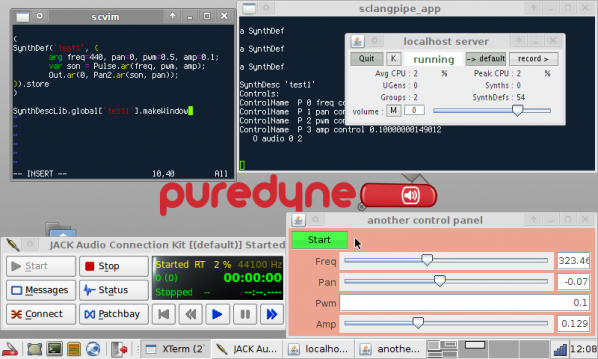
A number of projects, such as the pure:dyne[8] – GNU/Linux operating system for live audio visual processing and teaching – are, however, fully identified with the principles of free software. They have emerged from artists’ collectives whose relationship to art education is informally associated with sharing spaces, the hacklabs and free media labs where they run workshops and introduce participants to the use of free digital art tools. [9] Their mode of production is centred on ‘live code’ and feature two essential characteristics: 1) collaborative- relying on large-scale public participation and 2) distributive- offering the tools and the process notes (notation) to empower the others to carry on the work on their own.[10] This philosophy implies that the artistic performance of the work is complemented by a set of pedagogical approaches associated with the enabling of production by others. [11]

The movement for free education has gained greater relevance as a result of the global financial crisis and the battle for control of university fees.[12] In this context, art education has been developing into an artistic project while also providing an emancipatory movement reacting against dominant forms of institutionalised knowledge production. Within this movement, the role of free/open technology has been central in the mediation of self-education as a social movement.
On the one hand, artists –freelancers, sometimes temporarily/precariously plugged into educational institutions whilst working as teachers, others times as workshop facilitators in free access spaces– have opened up their classrooms to the environment of the read/write web, and with their students-collaborators, have produced and shared in wikis, blogs and Second Life, art and education resources that make an increasingly significant contribution to a larger body of knowledge that is the web. [13] Wikiversity is a model of this confluence of self-education movements and open online education.[14]
In parallel with the above-mentioned tendencies of online systems, numerous critical projects have appeared that are associated with the reclamation of space that occurs as artists have found themselves at the forefront of self-organised and self-managed self-education projects.[15] Some have happened side-by-side with the reclamation and occupation of spaces such as the Temporary School of Thought[16] and the Really Free School.[17] Part of these groups activity is the establishment of a free programme of workshops on topics that can range from free software tools to Ivan Illich and Deschooling Society.[18] Others that make opportunistic incursions into the artworld such as the Bruce High Quality Foundation University,[19] the Future Academy[20] or Unitednationsplaza,[21] are platforms for experimental art as research, investigating the production of knowledge that occurs when art education itself becomes artwork or exhibition.[22]
While the debate on free education has been enjoying significant visibility, the Higher Education sector has also joined in. A few recent initiatives have supported universities of the arts developing virtual learning environments and providing access to open education resources (OERs). This is the case with the JISC Practising Open Education Project (2010-2011)[23] with six art, design and media departments in UK universities. A number of these OERs include art work (photographs, drawings and videos), but the majority are art theory, mostly research papers, dissertations and art education research documents produced by artists-teachers-researchers as part of their continuing professional development. These are distributed with Creative Commons licenses with varying degrees of freedom, but rarely have the ‘copyleft’ attitude that has been associated with the free software.
Such an enterprise can be interpreted in the light of current debates in the fields of immaterial labour and cognitive capitalism revealing that whilst (digital) art becomes postproduction, art education is being packaged into open resources that circulate as part of the capitalist system, and become central to the new eLearning/networked economies. In addition to filling a gap in subject-specific open resources, this raises the question: why is the free and the open so popular in contemporary art education? A cynical hypothesis is that art education, by declaring itself as a type of production of knowledge, attempts to gain a new legitimacy, in the bureaucratised global knowledge market. The other possibility is that in the face of such a doomed scenario, art education searches for new possibilities beyond pure commercialism, reclaiming access through “contingencies of opening and mobility of cognitive packages beyond confines of ownership.” [24]
1. Floss as artistic –pedagogical method
The Digital Artists Handbook
The digital handbook, published by the arts organisation folly and artists’ collective GOTO10 in 2008, aims to give artists information about the available tools and the practicalities related to Free/Libre Open Source Software and Content such as collaborative development and licenses.
FLOSS+Art
This book edited by Aymeric Mansoux and Marloes de Valk in 2008 reflects critically on the growing relationship between Free Software ideology, open content and digital art. With contributions by: Fabianne Balvedi, Florian Cramer, Sher Doruff, Nancy Mauro Flude, Olga Goriunova, Dave Griffiths, Ross Harley, Martin Howse, Shahee Ilyas, Ricardo Lafuente, Ivan Monroy Lopez, Thor Magnusson, Alex McLean, Rhea Myers, Alejandra Maria Perez Nuñez, Eleonora Oreggia, oRx-qX, Julien Ottavi, Michael van Schaik, Femke Snelting, Pedro Soler, Hans Christoph Steiner, Prodromos Tsiavos, Simon Yuill. Available both in print and as torrent download
Technology Will Save Us
The project by Daniel Hirschman & Bethany Koby is a haberdashery for technology and alternative education space dedicated to helping people to produce and not just consume technology.
Openlab
Openlab Workshops was started by artist and educator Evan Raskob in mid-2009 to fulfil the need for practical education about digital art and technology. Floss workshops are developed and taught by working artists and media practitioners, giving participants direct access to practical experience.
GOTO10
GOTO10 is an artists’ collective that organises floss workshops on subjects such as Pure Data, Linux audio tools, physical computing, SuperCollider, puredyne, RFID, Audio Signal Processing, and other related areas of practice.
UpStage
UpStage is an Open Source platform for cyberformance and education: remote performers combine images, animations, audio, web cams, text and drawing in real-time for an online audience. Initiated by the globally dispersed performance troupe Avatar Body Collision, it runs the annual Upstage festival, open to proposals.
2. Self-organised and self-managed art education
Really Free School
Free school based in a squatted London pub. “Amidst the rising fees and mounting pressure for ‘success’, we value knowledge in a different currency; one that everyone can afford to trade. In this school, skills are swapped and information shared, culture cannot be bought or sold. Here is an autonomous space to find each other, to gain momentum, to cross-pollinate ideas and actions.” (Communiqué #1)
Bruce High Quality Foundation University
A free university project set up by NY-based artists’ collective The Bruce High Quality Foundation. “We believe in the artistically educational possibilities of collaboration. Collaboration, as we mean it, means a group of concerned people come together to hash out ideas, try to figure out the world around them, and try to take some agency within its future. That’s the why and how of The Bruce High Quality Foundation. BHQFU is an attempt to extend the benefits of this collaborative model to a wider number of people.”
Unitednationsplaza
A temporary, experimental school in Berlin, initiated by Anton Vidokle following the cancellation of Manifesta 6 on Cyprus, in 2006. Developed in collaboration with Boris Groys, Liam Gillick, Hatasha Sadr Haghighian, Nikolaus Hirsch, Martha Rosler, Walid Raad, Jalal Toufic and Tirdad Zolghadr, the project travelled to Mexico City (2008) and, eventually, to New York City under the name Night School (2008-2009) at the New Museum. Its program was organized around a number of public seminars, most of which are now available in their entirety online.
FOSSter creative Learning
Lesson plans that can be used in the art classroom, developed by The FOSSter Creativity Team, a group of students of the University of the Arts (USA)
3. Open Source Repositories
University of the Arts institutional OER repository
University for the Creative Arts institutional OER repository
VADS (Visual Arts Data Service) A collection of over 100,000 art and design images that are freely available and copyright cleared for use in learning, teaching and research in the UK.
OER Commons A repository of materials about teaching, technology, research in the emerging field of Open Education. Art materials at OER commons.
You can find paula’s original article on Collaboration and Freedom – The World of Free and Open Source Art http://p2pfoundation.net/World_of_Free_and_Open_Source_Art
This article is part of the Furtherfield collection commissioned by Arts Council England for Thinking Digital. 2011
Cyposium
an online symposium on cyberformance
Friday 12th October 2012
http://www.cyposium.net/
We all perform on the Internet. The social media profiles that we are contractually obliged to give our real names to are just as much performances as our World Of Warcraft or Minecraft avatars. Yet these impromptu performances of our socialised and fantasy selves lack the literary quality of drama. Not drama in the sense of a Usenet or Tumblr flamewar, but in the sense of theatre.
The 1993 New Yorker cartoon captioned “On the Internet, nobody knows you’re a dog” identifies two important features of the early public Internet. Firstly it’s a place, somewhere you can get onto. Secondly that place has limited bandwidth for establishing identity and communicating affect. This meant that the Cyberspace of the net became a site for identity play and imagined realities.
As the text-based virtual reality of MOOs gave way to the image-based Palace Chat and then three dimensional AlphaWorld the available bandwidth increased and with it the available ambiguity decreased. Describing a character or a scene or an action with a few words leaves the members of the audience much freer to exercise their own imaginations than seeing it in full motion animation with a high polygon count.
The visual, social and even economic order of virtual worlds and social media have become a more fixed and uncritical embodiment of mass media and the established social order. This has reduced their potential for alterity but it has made them useful representations both of shared reality and shared fantasy that can be used as a stage on which to perform critically, reintroducing the literay against the grain of their unreflective consumption of identity and spectacle.
Throughout this history, from the early 1990s to today, the Internet’s affordances have been used to produce dramatic performance in Cyberspace, “cyberformance”. The problem is we don’t remember this, at least not as clearly as we should. Individually, institutionally, and technologically we have lost our memories of artistically groundbreaking and important performances.
This problem is not unique to cyberformance. All digital art suffers from the decay of digital media and the creeping obsolescence of the hardware that it runs on. Internet art suffers from bitrot, software obsolescence, linkrot, the loss of web pages and sites elsewhere on the net that are connected to the work, and netrot, changes in the protocols used to distribute it.
Above and beyond those problems, cyberformance involves live perfomance. Unique events produced by historical communities at a particular moment using media that will rapidly become obsolete need to be recorded in order to be remembered or at least to be critically re-evaluated later. This creates a second layer of conservation and archiving problems.
Take the example (outside of Cyposium) of Judy Malloy’s “Brown House Kitchen”, a narrative environment created in the LambdaMOO text-based virtual reality. Despite being mentioned in surveys of virtual art in the 1990s, despite being produced with institutional support, and despite being stored on one of the longest-running textual virtual world servers the software objects that made up the work were recycled as part of the normal running of LambdaMOO and are now lost. Many other text-based virtual realities, some specifically designed for dramatic works, are not even online any more. And the protocols used to access them are old, with software to connect to them increasingly not installed by default on newer operating systems. Even those created after the Internet Archive started will not appear in it, as they are not web-based.
I mention LambdaMOO as by chance I was researching text based virtual worlds and performance in the months before Cyposium was announced. One work that was described in the literature but untraceable online was Stephen A. Schrum’s “NetSeduction”. Which Schrum presented and discussed at Cyposium. And the script of the original performance was made available through the Cyposium website. Without Cyposium, these resources would not have been made available.
These contrasting examples drive home just how badly needed Cyposium was. The Internet does enable us to digitise and experience more culture than ever before, but it also erases our memories of the culture that is native to it. And the often highly experimental nature of cyberformance makes it harder to record and remember than almost any other kind of technologically enabled art.
As well as addressing a specific need to recover the history of net performance, Cyposium is an exemplary model for a new kind of online event in the era of Massively Online Open College courses. It performs the function of a symposium or convention online, reducing barriers to access and increasing reach for institutions, speakers and audience members. The Waterwheel Tap software used for most of Cyposium allows side-channels of audience communication, which help to build a sense of place and community and allow the audience to ask (and answer) questions and share knowledge among themselves and with the speakers.
The panel discussions that Waterwheel enabled meant that old and new net performers could discuss each others work in the light of new developments or freshly reconsidered history. And we, the audience, wheoever we were and wherever we were, could watch and learn from this discussion and join in. I am often wary of the word “open”, but there was an intellectual and social generosity and inclusiveness to Cyposium that made it feel like a very open event.
A ripple of excitement went through the mailing lists I subscribe to when Cyposium was announced. Its organizers and line up promised something special, and the event itself didn’t disappoint. To be part of the audience, chatting in text alongside the live streaming video presentations, was to be part of both a welcoming ad hoc conversational community of interest and participating in a key moment in a larger historical conversation.
Cyposium went beyond recovering and presenting the history of online performance. It brought together net performers old and new in productive dialogue in front of an engaged audience and served as an example of a new kind of net native event. Now that the event itself has finished the Cyposium web site serves as an important record of an important aspect of online creativity.
This essay will appear in the forthcoming Cyposium book.
The text of this review is licenced under the Creative Commons BY-SA 3.0 Licence.
First off, some claims, some general, some particular. I’m going to use these to speak about the work under consideration and in turn call upon that work to support the claims. A kind of virtuous critical circle.
General: works of art are not messages but objects. They don’t say things nor ask questions, nor assert, nor investigate. Neither do they as objects have messages somehow encoded or embedded within them. To assert otherwise is a massive category error.
As objects they may of course be brought in evidence, copied, become conversation pieces, be described well, be described badly, be described perversely, be seen, be half seen, be missed, be lost, be found, be written about, point to things, be compared and many other things, some of which have not yet been imagined.
Further, artworks are fuzzily-bordered and not necessarily of a physical or temporal piece – the object is not simply the object (and ‘the object’ might not be physical but words, a concept, a sound recording, a protocol) but everything that accretes as a result of it – commentary, jokes, other artworks made in response. If mathematical terminology wasn’t so regularly and toe-curlingly abused in the arts, we might refer to them as manifolds, not necessarily connected.
Even the historical is not immune. There’s a reaching back in time where an established work is transformed retrospectively by homage – ‘Las Meninas’ an obvious case in point.
Also: the work of art is finite – it was born and it will, one day, cease to exist (and it will be forgotten, or there will be no-one to remember it). Everything changes, everything dies.
This implies, too, that although the individual author matters, as product of a unique formation and a unique set of locations in time and space, every artwork is socially authored.
Particular: Abraham’s work represents a new conjunction of technology, collaboration and performance as a generator of moving image. It has precursors (freely acknowledged, indeed celebrated) but it is qualitatively new. The moving image work comes in two flavours, fresh and preserved, both with their own particular and delicious savour. Abrahams conducts live performances on the internet. These performances occur singly, as pieces in themselves, or form part of the programme of events accompanying exhibitions. The moving image pieces in this show are all derivations of this kind of performative event. Except derivation has an air of the hierarchical and the types of piece form no hierarchy any more than fresh or smoked salmon do.
A final general claim: writing about art is not a science but itself an art. Sometimes the brush will be delicate and sometimes broad. There is no recipe or rules or template. One can be too delicate – sometimes confusion is good, particularly in the matter of the affective. Crude thinking sometimes gets us further, paralleling, not dissecting, the richnesses of work. There are some mysteries one should leave as such.
OK. Onwards and upwards…
Performative is currently a much used, some might say overused, word. One quite common usage is to suggest that a work contains visible or at least trackable traces of its own making, a kind of archaeological or sedimentary record, and that perhaps this might have been to varying degrees intentional.
Of course it’s arguable any work of art is performative in this way and that it’s quite hard to erase the trail behind you whether what you make is time based or photographic, sculpted or made with hand applied pigment of one sort or another. Continuous looking and thinking about art for any length of time, especially allied to making stuff oneself, whether dabbling or something more serious, hones an increasing sensitivity to these questions. And this matters; particularly when it comes to over-nice distinctions between close relatives such as the still and moving photographic image and esoteric arguments about how time is differently present or presented in each of these and in other further flung practices too. The new scholasticism feeds on ever finer such distinctions.
So it’s a relief to come across work, which is genuinely performative, enough so that even someone undrenched in theory can see it, can get it and can be delighted and exalted by it. Furthermore work that smells unmistakably of the human, that abuts the high and the low, the crude and subtle, that blurs boundaries, that borrows and echoes the work of others not with the pinched expression of someone with a theoretical framework but in a spirit of ‘why?’ and ‘let’s play’ – the two childish precursors of grown up science and art.
Annie Abrahams’ show at the Centre Régional d’Art Contemporain Languedoc-Roussillon in Sète is a graceful and elegant dog’s dinner of a show. Physically it’s odd, exiled to the upper floor (still a generous space) whilst Catherine Gfeller, someone altogether more easily glossed and hence exhausted (though not without merit) gets the more conventional downstairs galleries (and attracted the lion’s share of the press on the opening night.)
Said upper floor comes in two instalments – a lovely hangar type space, where a game of golf seems distinctly possible, with a kind of tail leading off it, a long thin corridor which fattens a little towards its farther end maybe 100 metres away.
The layout of the show utilises this peculiarity nicely. In the big room a very large two projection installation, Angry Women, spans one corner and takes up a considerable portion of the two adjacent walls.
In the far corner, diagonally opposite, a monitor, with two chairs and two sets of headphones, of which more later.
Leaving the larger space, two more monitor based pieces at junctions where it’s possible for an individual to sit and others to pass. Five chairs arranged in a circle with copies of two books of interviews on each (one with Abrahams, and one with a selection of other cultural figures) and highlighter pens. In the middle of the circle, a pile of blankets. A larger wall piece of rough and ready cardboard placards with texts (“mutuellement vulnérable”, “euphorie communicative”, many others) in various hands.
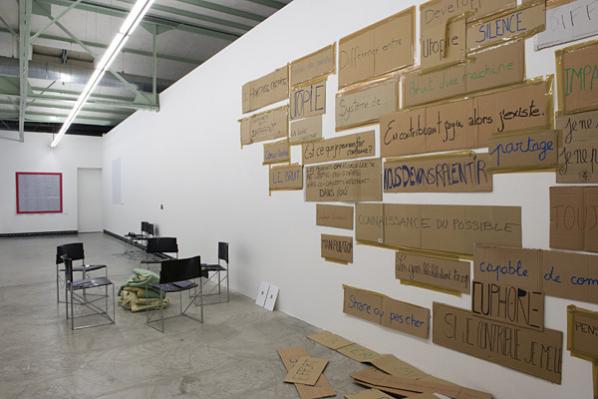
At the far end, a number of framed photo and images based pieces plus a work consisting of a single photograph and headphone delivered audio (it’s a snapshot – snapshot size, snapshot aesthetic – of husband and wife volunteer fire fighters. The audio is manipulated audio of texts on the subject of fear read by them. Let’s not try and place all this into any sort of context yet. Let’s set out our stall, enumerate, account, describe.)
A final deft touch is the symbolic linking of the two areas by a ribbon of text occupying the 15 or so centimetres above the floor, skirting board height, the topic of which appears to be mental illness (and all elegantly lettered except for one point where a letter had been omitted and is inserted with a caret symbol.)
Most of the pieces employ texts or performances – both gestural and textual – by others – often created according to some seed question or protocol. The texts often come from questions posed on the internet but sometimes from workshop or outreach type (type –this is to tentatively and provisionally locate the thing – it’s outreach Jim, but not as we know it) activity.
The performers in the moving image pieces are geographically dispersed but brought together at a single time by webcams and some custom software that Abrahams has used on a number of occasions where the web-cammed-in participants occupy a space in a rectangular grid (aficionados of seventies UK quiz shows such as Blankety Blank will get it immediately).
There’s a fragility, a delicacy, a tentative hold on existence, a testing of our belief, about these works that so many works of fine art – as opposed to design – have. The sense that what we have incorporates the idiosyncrasies, indeed the weaknesses of the support materials and media, into a final object (the same sense as when an artist wilfully uses something manifestly not intended for art, or allows mistakes to stand, or omits, or makes all too evident repairs; this is not new. Think pentimenti, or the hasty addition of an extra panel of canvas or paper to take account of expanding ambition or vision, or the aestheticized unevenness of Japanese tea-ware.) This sense of object-hood rather than message or statement is key. An objecthood which in retrospect could not have been other, but equally could not have been proposed, foreseen, except in its protocols of playfulness.
The pixellation, dropout, glitching, concomitant upon the pushing of the current state of the network to its limits in the multi participant pieces (and this reminds one of how flicker and roll and a general fuzziness become now part of the Acconci piece Abrahams draws upon in her Theme Song After Acconci – which reasons of space preclude too much detail about here – suffice it to say Abrahams honours, compresses, feminizes, satirises and intensifies the original. If Acconci could have had access to a “better” technology, one where the speed was constant, where no flicker or roll appeared, would he have then felt it served his purpose better? Did what he saw even look fuzzy or worn to him? Probably yes, compared with the film standards of the day, as does Abraham’s work compared with high end digital video [and even the current, rather good, quality of You Tube].)
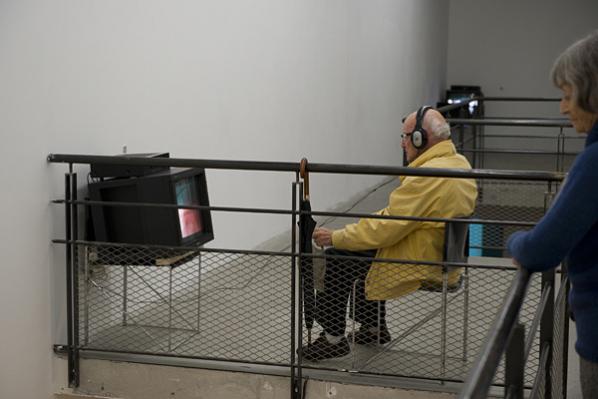
To offer participants a protocol is paradoxically both to assert and to cede control, to know and to not know how things will turn out (an analogy is the use of chance in the works of Polish composer Witold Lutosławski, where the mechanisms make the generality of the sound, its broad texture, predictable but any particular instance impossible to predict or even fully imagine [but all, please note, a matter of degree because the finer the grain, the greater the level of magnification, the more we can find such uncertainty in anything unfolding over time – it’s a question of our norms – what is the difference between the Stockhausen piano pieces where the performer can choose the order of segments and a Mozart sonata where the tempo may be quite widely varied? – in principle, none])
The piece Pourquoi avons-nous des difficultés à ouvrir un ordinateur et en changer le disque dur? plays on a single monitor with the screen divided into two areas. In each we see, sometimes with difficulty and ambiguously, parts of a computer, screws, connections and hands.
We hear two voices, one that of Abrahams and the other her co-performer, discussant, what have you, Eliza Fantozzi, speaking in French. In the version at Sète there are English subtitles which even for non English speakers provide a kind of functionality, meaning, in that the words tend to be positioned on a line from left to right according to who is speaking. When both speak suggestive gaps appear, though these cannot be read definitively).
The subtitles are in a strange (for a native English speaker) near-English (the title, for example, is translated as “Why do we have difficulties to open a computer and change its hard disk?”).
This is, it must be said, cute, amusing and engaging and it underscores the altogether naughty childlike quality of the entire interchange. The characters (for I think one should mistrust the assumption, however tempting, that we have here unmediated access to the actual participants) are playful – amused and amusing. At the same time they ruthlessly anatomise the roots of their difficulties with technology (but the performativity avoids being on–message in any sense and makes for something strange, complex and even uncomfortable. At one point Fantozzi complains of the lack of colour variety inside the machine and starts painting the components with nail varnish to “create a much merrier circuit” – Je crée un circuit beaucoup plus gai).
Later Abrahams lays into a ribbon connector with a pair of scissors and then starts apparently fringing it with regular cuts half way across … There is an association of the decorative, the playful and a rejection of the serious which is somewhat too close to many gender stereotypes to be entirely comfortable. (The piece was originally performed on international women’s day 2011) And yet, and yet – the end result is complex, for there is a steeliness to the play and a self respect and assertiveness. Perhaps (I don’t know. I don’t think there is a definitive answer. I don’t think close reading or theory can bring us it either) it is the very truthfulness, the richness of the incorporation of the world as it is and not as we might like it to be from which this springs.
Before we get to the physically largest and most imposing presence in the show we’ll look at its neighbour, comprising two chairs, a monitor and two sets of headphones.
Double Blind (Love) is a record of a 264 minute telematic performance by Annie Abrahams and the US artist Curt Cloninger which took place on November the 29th 2009. Annie Abrahams was in the Living Room (Espace de création contemporaine) Montpellier, France and Cloninger in the Black Mountain College Museum and Arts Center, Asheville, North Carolina, US.
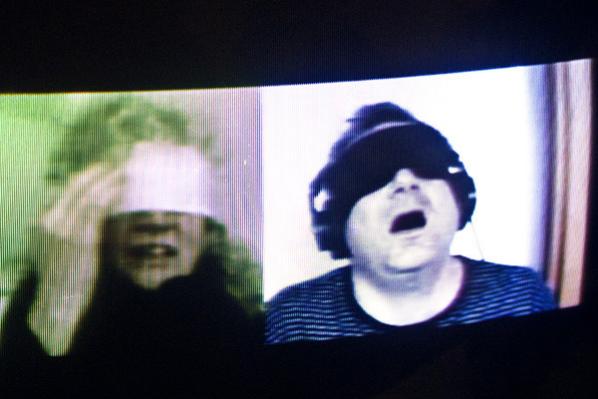
Both wore blindfolds for the entire duration of the performance, which was a joint telematic musical (and I use the word advisedly; though Abrahams describes Cloninger as a musician she appears to reject the description for herself. I think she is mistaken) performance taking the form of an improvisation, largely vocal but with some keyboard input from Cloninger, around a short musical cell from the track Until the End of the World by U2. The section in question has a repetition of the word “love” for its sole lyrical content and occurs just over midway through the song. It would perhaps ordinarily be described as a chorus but in fact appears only once in the song (although it continues as a backing vocal throughout the next verse), one of the first of many tiny idiosyncrasies on our pathway, peculiarities which add cumulative spice and interest to the project. I’d always found U2 banal and full of bombast but going to the song, under the circumstances of researching this piece, with necessarily open eyes and ears was a small epiphany, one of a number occasioned by a systematic engagement with Abraham’s work.
It’s worth noting that much of the structure of this piece came originally from Cloninger. In the previous year he had performed a number of pieces under the title “pop mantra” where in a live situation he repeated a similar pop music cell for a period of hours (“usually blindfolded”).
Cloninger had also video documented these performances though at this point this is documentation and lives no independent life of its own.
Let’s take a look at these proto ‘Double Blinds’. There is as yet no suggestion of interchange, of development. Although this is clearly a more obvious option with two performers, conscious development is not impossible in a solo performance. It does however appear to be consciously excluded. In an echo of the process or systems driven works of the seventies, Cloninger sets something in motion and allows it to unfold. He attempts to repeat the phrase many times. Presumably his arms start to ache and his voice to tire. This trial of endurance becomes a principal motor of the pieces. What does this evoke? For me, and you might share this, there are the dance marathons of the twenties, the notion of sport, especially individual sport, of pitting oneself against oneself; there is ritual repetition – Sufi whirling, or that carrying out of repetitive, gruelling and apparently pointless tasks sanctified in some Buddhist traditions; the pilgrimage; there is a kind of practical prayer through ritual, suffering or self-abnegation.
The motoric unwinding and associated characteristics obtain in Double Blind, too. What is new, what comes from Abrahams, is the telematic – the fact of separation by an ocean and the fact of collaboration. Indeed there is an inbuilt sharper contradiction as the collaboration separated by so much physical distance is of the peculiar intimacy that attends musical partnership, improvisatory or not. (A couple of years before Abrahams had performed a telematic kiss for three hours with the US artist Mark River.)
Despite Abraham’s denial the finished performance falls entirely within the established parameters of the musical. Precedents such as the work of Meredith Monk could be cited for Abraham’s compelling vocalisations – song, whisper, shout, scream, cry of pleasure, cry of pain – whose musico-dramatic logic and sensitivity to her performing partner, this listener at least, finds totally satisfying. It’s a touching partnership, with both performers bringing a fierce commitment to the task in hand but also each bearing different gifts – Cloninger, a formed musical sensibility supported by conventional skills and Abrahams a kind of discovery/invention of improvisation (indeed of music) ab ovo.
Thousands of years in 4 and half hours.
There is a formal challenge and satisfaction too, common to both Abraham’s and Cloninger’s concerns – how much transcendence can be mined, discovered, invented, from the small, the insignificant? Can it be exhausted before we are exhausted and what does the transfiguration brought about by the attempt suggest about us as human beings?
Two performers. Two chairs for two spectators only. Likewise, two sets of headphones.
Grace.
Opposite, stretching luxuriantly out, is the exhibition’s jewel in the crown – Angry Women, created by Abrahams and twenty two other women of many nationalities, speaking about anger; acting out, demonstrating, reflecting, on anger, on webcams from their different individual locations and in their native tongues, with the images being sent to the 3X4 grid, in a format that Abrahams has made her own. Because of the limits of even current streaming technology it was necessary to conduct two separate performances (separated by an interval of a couple of months). The length of each performance was determined by a protocol where a minute’s silence by all participants signalled the end. This resulted in pieces of differing lengths which lack of synchronisation adds another layer of fragile grace to the final projections, projected large on adjacent walls around the corner joining them with sound from the left images fed to the right speaker and vice versa.
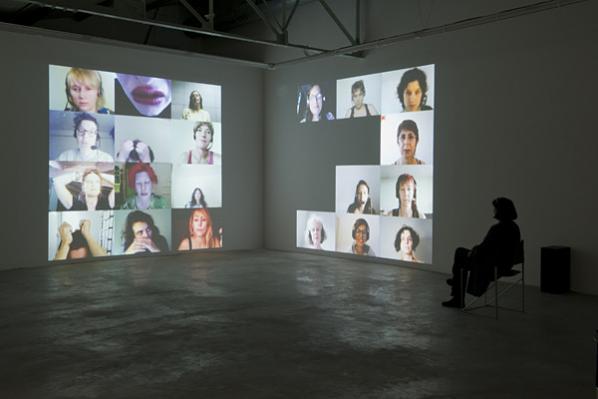
The effect is visceral – we face what feels like a wave of humanity, not so much in numbers, although 23 is impressive, but in the infinite malleability of the face, hands and of gesture and expression and of how these things can occupy the frame. Sometimes that frame will resemble a Giacometti portrait, with the subject appearing to recede into what seems to be endlessly deep space. At others red lips or an open mouth, sensual and terrifying by turns, occupy the whole of the space – and furthermore each cell is constantly in flux (because these are living, breathing unpredictable human beings). There is something both of portraiture and of the dance at work, and a species of found poetry too, which the moving image work has in common with the collaborative texts at the other end of the exhibition. The combination of iron control, planning, foresight (the grid, the protocols) with a letting go and a trust elsewhere – the phased lengths, the blank space for the person who didn’t turn up, the performative possibilities – makes for something of great richness.
Additionally it’s clear that those of the performers who have previous experience are consciously playing with and against their fellows – gestures are mirrored, sounds echoed, the fiction of looking elsewhere (to the side, or above) in the grid is impressively deployed.
The angry women turn out to be at one and the same time very particular –unique – women and women in general too; the women in general turn out to be human beings in general (and general en masse because each so particular) and the human beings in general turn out to live in this, one, our, very particular, world – that mysterious, frightening and wonderful place.
In keeping with the cheering on of lack of clarity, of mess, of crudity I’ve espoused so far in this piece (and will continue so to do, here and elsewhere) I want to say we need to take the exhibition (and the world) as a whole. Offering us the video and the still image pieces and audio means we cannot but think of them together (we can choose to artificially isolate pieces but we cannot undo our knowledge of that whole). So to the extent that I have selected topics here I have done violence to Abraham’s art, which has no message, is not confined to any one medium, collaborates in multiple ways, borrows, steals (and gives) and presents us with a set of marvellous and mysterious objects which afford us a spectrum of entirely new pathways to the world, to seeing it, talking and thinking about it, ourselves, after we have gone to the bar or got on the train north to Paris and thence homewards, happy and somehow a little changed.
—-
Training for a Better World – Annie Abrahams
Centre Régional d’Art Contemporain Languedoc-Roussillon, Sète, France
28/10/2011 to 01/01/2012
‘About 50% of global trade is channelled through tax havens and 83 of the 100 largest multinationals are based in the Netherlands for fiscal reasons. The flow of money seeks the path of least resistance – but where exactly do those paths lie today?’
This is how graphic designer Femke Herregraven began a presentation about her new online game Taxodus. Herregraven designed the prototype of Taxodus, a game about offshore tax avoidance, during a master class at Sandberg-Mediafonds. The offshore system offers companies advantages in countries where legislation relating to non-nationals guarantees certain privileges, for example, when it comes to corporate structures, in certain areas of business confidentiality, or low taxation. Taxodus is an accessible way to discover how you can avoid paying taxes, and if you can’t get away with it completely, how you can make sure you pay the lowest possible amount.
Annet Dekker: Taxodus is a game about offshore business practices. How does it work?
Femke Herregraven: As a player you choose an existing multinational company or bank with a specific profile and then you look for the most favourable countries to set up a subsidiary and accumulate income by paying as little tax as possible. Each country has a specific transaction profile. For example, companies involved with Intellectual Property Rights find the Netherlands most appealing, while oil companies are drawn to other countries. The game offers a random number of options and calculates what these yield for you. You can compare the results with other countries to achieve the game’s goal of reaching the end with as little expenditure as possible. The game is based on actual information on withholding tax in global tax treaties.
AD: This isn’t a topic you usually encounter in art. Where does your interest in this subject originate?
FH: In 2010 I was asked by the Virtueel Museum in Amsterdam to research the identity of the Zuidas during a residency. The Zuidas, which literally translates as ‘South Axis’, also known as the ‘Financial Mile’, is a large, rapidly developing business district in Amsterdam. Much like Richard Florida, they wanted to ‘cheer up’ the neighbourhood. My questions about the companies located there received only vague responses; there weren’t any lists, or names, or post boxes, and with the exception of known names like Google and Facebook, the other companies that are based there was a mystery. To trace what type of businesses might be located there I spent weeks indexing the entire Zuidas from the Chamber of Commerce’s trade register. I indexed the occupants by street and house number and then compiled three telephone books from the data. All sorts of unusual data and patterns became evident – some addresses only have one occupant, while others have more than a thousand of the so-called mailbox companies that only exist on paper. This is also apparent from the names: some only consist of Roman numerals.
All this information piqued my curiosity and I wondered why these companies were situated there and what they were up to. The next step was delving into Dutch tax law and it became clear that there are enormous financial benefits to setting up a company in the Netherlands. This is a major selling point when Holland is promoted abroad. The entire offshore system has operated below the radar for a long time – sometimes we catch a glimpse of it – but quite how it works in its entirety almost no one knows. The first step to understanding this is visualising it to gain insights, and then you can ask specific questions. Taxodus classifies this information by visualising it: from mining in the Congo to oil companies in Italy and Libya.
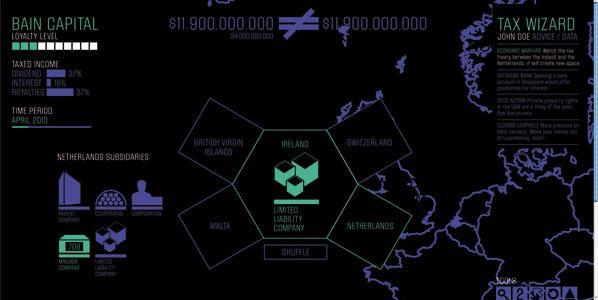
AD: It all sounds very murky!
FH: It’s all completely legal, but shady at the same time. If a foreign company doesn’t want to open a physical office in the Netherlands, it hires a trust office that takes care of the bookkeeping, drafts the annual reports and appoints a CEO. There are countless small trust offices that manage huge numbers of foreign companies on paper. Everything is done according to Dutch law and the tax benefits in Holland are hugely beneficial for foreign companies. For example, small businesses in the Netherlands pay more than thirty per cent tax, while foreign companies avoid a large part of that taxation due to tax planning. The presumption that foreign companies basing themselves in Holland is beneficial for national employment is also misleading because most of these companies only exist on paper and don’t employ anyone. The trust offices advise against opening a physical office and taking on any staff because Holland attaches great value to its employment policy, which makes dismissing personnel difficult. A ‘mailbox’ company avoids all these complications.
AD: But the way in which you visualise this is also subjective because you manipulate the data.
FH: Yes, I selected companies that people will know or which appeal to the imagination. Unfamiliar names won’t really be noticed, but once you realise that almost everyone participates in this system, from Mitt Romney’s Bain Capital, Walmart, Google and Facebook to Chanel, then it takes on a different immediacy or value for many people. If you look at this on a wider scale – globally – you will see, for example, that 60 per cent of large companies in Portugal, Italy, Greece and Spain use the Netherlands to take advantage of these types of constructions. This is legal and it’s also beneficial to the Netherlands, but when Dutch politicians insist on more transparency from Greece and lecture the country from up on high it smacks of hypocrisy. You see the same thing with a lot of development aid to countries in Africa: most of that money is diverted to the bank accounts of African leaders in offshore tax havens. Someone has done the maths: the debt of the entire African continent is less than the monies African leaders hold in offshore tax havens. A ‘mailbox’ company by itself is not that suspicious, but with everything else it creates the holes through which (public) money can disappear. My primary intention is to make these flows of money visible and question them, because once it’s out in the open people can decide for themselves if this is our idea of a sustainable economy.
AD: Of course, your game can also be interesting for existing companies who can use it to see where and how they can best invest? Is Taxodus the new Monopoly?
FH: Yes, in a way it is, but in reality companies have been doing this for ages. General Electric supposedly has a department employing about a thousand people who are busy with this on a full-time basis. I don’t think my game will suddenly improve things. Yet, the point is that the knowledge about international tax planning is now only in the hands of experts like fiscal lawyers and accountancy firms, and isn’t accessible to the rest of us. That’s also what Taxodus is about, making a tool so that we can track what they’re up to.
Monopoly is an interesting comparison because it originated as a critique of capitalism and private monopolies. The games are comparable, but Taxodus goes further. If you make a move in the game that correlates to reality then you are informed about this and receive a reality-bonus. It’s at this point in the game that investigative journalism comes into play.
AD: How do you relate to investigative journalism?
FH: My projects frequently begin from a journalistic position and for this one I meet with journalists, fiscal lawyers and researchers quite often. Yet, I’m a designer and I don’t want to write articles but use other methods to provide insights into topics. For me design is not an end in itself but a way to research, express and contribute to debates in society. This means also collaborating with other disciplines and experts: a group of fiscal experts is currently helping to remove errors and provide feedback. Obviously, it’s impossible to create a 1:1 translation, there will always be things that aren’t entirely accurate or that have to be left out, but it is important that the broad outlines are clear and correspond with reality.
AD: Why a game?
FH: Avoiding and evading tax is complex but you can learn the psychology of this system by playing the game. Taxodus is actually a kind of chess game. The rules aren’t simple and your eventual benefits depend on all sorts of interrelated factors. You have to continually take strategic decisions to advance in the game. All this information is incorporated into the game and the various tax treaties between different countries gradually become clearer. You are aided in this by advisors. At the start of the game you chose a particular advisor. Different advisors offer different advice, some will try to find legal alternatives while others try to convince you to bend the rules. Players can ask for a second opinion at any point in the game and manipulate regulations and treaties. This enables players to steer the game in the direction they choose. As in reality, a player has to have the possibility to have complete control. Ideally the game should be a do-it-yourself kit that you can add things to, an open game of strategy.
AD: What do you mean exactly? Can you name an example?
FH: The simplest way is to play it alone; the more complicated version is played with others in real time. At a certain point you can earn loyalty points by, for instance, evading high taxation for your parent company. Once you’ve arrived at the loyalty level, you can change roles, perhaps becoming a government employee who modifies regulations ever so slightly to make it more beneficial for yourself. You can also block other players in this way. This is an obvious reference to the increasing merging and blurring of the interests of large corporations and political leaders.
AD: How do you keep up with actual changes in the real world?
FH: It isn’t as if new information is constantly being made available – a lot of countries are reluctant or refuse to release ‘sensitive’ information. Tax treaties and regulation doesn’t change too often, but when they do, these changes will also be incorporated in the game. The English researcher Nicolas Shaxson, who is very active in charting the offshore system, says that people have to first become aware of what’s happening before they can think about how to deal with it. I hope my game and visualisations can contribute to this awareness raising.
AD: When or how does the game end?
FH: You have a certain amount of time before you have to submit an annual report for your company, then your trajectory is incorporated into the database and you can see what your score is. You can also compare it to other players and download their fiscal structure, which adds an element of competition and makes it a crowd-sourced investigation. By playing you contribute to the research and help expose the layers.
AD: Will Taxodus be a commercial success?
FH: My main concern is to make a tool that makes this small yet incredibly significant part of our opaque financial world more transparent, and especially more public. I think artists have a responsibility to broach topics like this. People find it all quite shocking when I tell them about Taxodus, but for those who are directly involved in the actual system it’s mere child’s play. This type of project can stimulate discussion and determine what is and what isn’t desirable.
This approach was shown to be successful with another project, the Art Reserve Bank. We set up a bank with a small group of artists and designers and introduced a new currency in the heart of the Zuidas as a way to encourage discussions about the financial sector. Our bank – a vault, an exchange counter and a glass house with a minting press: a bank brought back to basics – is located across from the ABN AMRO headquarters, and each day some of the employees and other people come by to see what we’re doing and have a chat. People also buy our coins, which are designed by a different artist each month. It doesn’t always go smoothly, but there is certainly enough curiosity. One problem is that people are personally interested but refuse to make any statements in a professional capacity. De Nederlandsche Bank (the Dutch central bank) recently sent us a letter stating that we cannot use the word ‘Bank’, threatened us with a fine of up to 2 million euros and invited us for a talk. These types of discussions are what we aim to achieve. Our goal isn’t necessarily to introduce a new currency; instead we want to underscore that fact that the bankers and financial experts of this world do not have exclusive rights to debate and decide what happens on financial markets.
———
A Dutch version of this interview appeared in Tubelight, September 2012.
Femke Herregraven: http://www.bitcaves.net
I met Eugenio Tisselli in Edinburgh at the Remediating the Social conference in November 2012. Eugenio gave a presentation on the project Sauti ya wakulima, “The voice of the farmers”: A collaborative knowledge base created by farmers from the Chambezi region of the Bagamoyo District in Tanzania, and “by gathering audiovisual evidence of their practices they use smartphones to publish images and voice recordings on the Internet”, documenting and sharing their daily practices.
I was struck by his sensitivity to the social contexts and political questions around this type of project engagement. This interview explores the challenges we all face in connecting to a deeper understanding of what technology can succeed in doing beyond the usual hype of the ‘New’ and its entwined consumerist diversions. Not only does the conversation highlight how communities can work together in collaborating with technology on their own terms. But, it also discusses the artists’ role in the age of climate change and the economic crisis, locally and globally.
Marc Garrett: Can you explain how and why the Sauti ya wakulima, “The voice of the farmers” project came about?
Eugenio Tisselli: Sauti ya wakulima is the fruit of my collaboration in the megafone project, started in 2004 by Catalan artist Antoni Abad. During six years, we worked with different groups at risk of social exclusion, such as disabled people, immigrants or refugees. The idea was to provide these groups with the tools to make their voices heard: smartphones with a special application that made it easy to capture images, sound recordings or short videos, and a web page where these contents could be directly uploaded. Using these tools, the participants of each project were able to create a collaborative, online “community memory”, in which they could include whatever they considered to be relevant. Although megafone was relatively successful and, in some cases, made a positive impact on the people who participated, I was worried that the project was becoming too dispersive. We worked in six countries, with extremely different groups. So, in 2011, I decided to follow my own path and apply a similar methodology into more focused projects, related with sustainable agriculture and environmental issues. I realized that the projects which sought to increase the empowerment of a community could become too complex for a single artist to handle. That’s why, in Sauti ya wakulima, I’m not “the artist”, but a member of a transdisciplinary team which includes biologists, agricultural scientists and technicians. Such a team came together after my PhD advisor Angelika Hilbeck, my colleague Juanita Sclaepfer-Miller and myself came across the possibility of working with farmers in Tanzania. The network formed by local researchers, farmers and ourselves was quickly formed, so we started the project on March, 2011.
MG: I find it interesting that you made the decision to put the role of artist aside. This reminds me of a discussion in Suzi Gablik’s book published in 1995 ‘Conversations before the end of time’; where James Hillman in an interview talks about learning to refocus our attention from ourselves and onto the world. Further into the conversation Gablik says “In our culture, the notion of art being a service to anything is an anathema. Service has been totally deleted from our view point. Aesthetics doesn’t serve anything but itself and its own ends”.[2]
So, I have two questions here. The first is how important was it for you to put aside your status as an ‘artist’, and what difference did it make?
And, where do you think you and others may fit when considering the discussion between Gablik and Hillman?
ET: It is important for me to make it clear that I didn’t abandon my role as an artist. Instead, I fully assumed my status, but only as a member of a transdisciplinary team. I believe that this may be a point of departure from the classical view of the artist as a “lone genius”, which is closely related to the discussion about service in art. So I’ll try to interweave both questions together. In a recent publication, Pablo Helguera aimed to set a curriculum for socially engaged art. He identified the new set of skills to be acquired by the artists, and the issues they must address when dealing with social interaction. But, as Helguera suggests, perhaps what’s most important is to overcome the “prevailing cult of the individual artist”, which becomes problematic for those whose goal is “to work with others, generally in collaborative projects with democratic ideals.” [3] To me, this implies that the artist must give up control of the work to a certain degree. I find myself in this scenario, and I think of my role in Sauti ya wakulima as that of an instigator and coordinator. Furthermore, all of us involved in Sauti ya wakulima aim to effect actual changes in the lives of the participating farmers, rather than obtaining purely symbolic results. Our project is a socially engaged artwork that wants to be useful, to deliver a service.
We are living in urgent times, beyond any doubt. Looming global challenges, such as climate change, radically cancel the luxury of being useless, of not doing anything. This includes the artist who, as any other citizen, is called to use his or her abilities to help in preventing a catastrophe. I especially like Franco “Bifo” Berardi’s proposal about the new task that the artist might assume: that of reconstructing the conditions for social solidarity. This work of reconstruction would oppose competition, a value often found in the markets that deal with self-referential, self-serving artworks. Solidarity, writes Berardi, is neither an ethical nor a political program, but a pure aesthetic pleasure [4]. In my opinion, the artists who still embrace the idea that art should only serve its own ends will become those who play the lyre while our world burns.

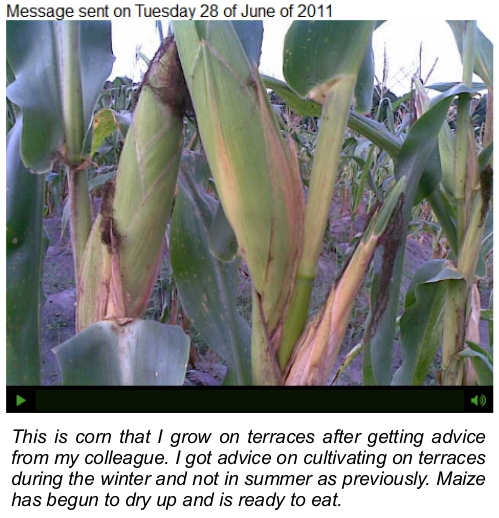
MG: What kind of behaviours began to emerge once the farmers took control of the smartphones supplied?
ET: It was quite interesting to see that the farmers started to use the phones for purposes which were different from those that we had originally proposed. This happened very soon after the project started. Only one month had passed, and the farmers had already started to go beyond merely documenting the effects of climate change. They interviewed other farmers, and asked them all sorts of questions about their crops and agricultural techniques, their opinions and views. In short, they slowly laid out a web of mutual learning. This was a real eye-opener for us. As we began to observe this, the environmental researchers in the team became worried that the farmers were deviating from the goals that we had set. I wanted to leave room for this deviation, as I was particularly interested in studying the process of technological appropriation. So I had to convince the researchers that we should leave enough room for the farmers to freely explore the potentials of the smartphones. It was not easy but, in the end, negotiating the tensions between a goal-oriented and an open-ended research turned out to be quite fruitful.
On one hand, the farmers found that they could shape the project to fit their interests which, as they said, were to “learn about what other farmers in remote areas were doing.” On the other, the researchers finally realized that the images and voice narrations posted by the farmers were an invaluable source of information about what was actually going on in the farms and within the communities. Sometimes, agricultural initiatives may be designed with an insufficient understanding of the social context in which they are applied. By allowing the farmers to publish a wide range of topics, Sauti ya wakulima became a “community memory” that reveals rich details about farming and the social life of rural communities in Bagamoyo.

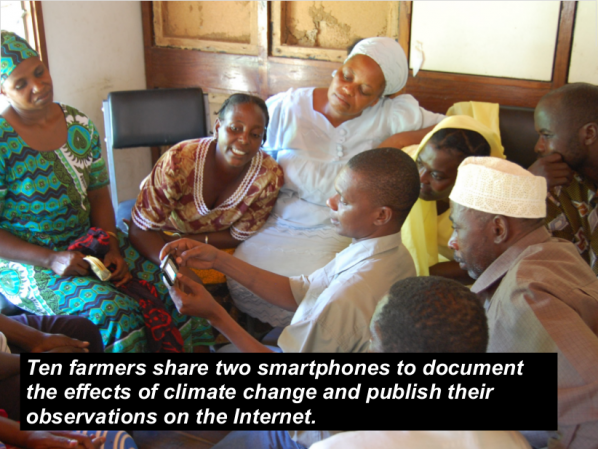
MG: In your presentation at Remediating the Social, I remember a quote from one of the farmers saying “The project helped me learn that phones can be used for other things besides calling people, and that computers can also be used to solve problems: they are not just a fancy thing for the rich people in towns.” What’s interesting here is, these words could be said any where. And that our consumer orientated culture could still learn a few things regarding uses of technology.
What lessons can the farmers teach ‘us’ in a culture where computers are part of the everyday life?
ET: I have interpreted this particular quote in two different ways. The first, most obvious one, is that the farmers discovered that the smartphones and the web can be useful tools, which may be shaped and adapted to meet their needs. For many of them, Sauti ya wakulima was their first chance at trying out these technologies. And, happily, the project showed us all that they can become an important ingredient in making farmers’ lives a little better.
However, my second interpretation is not as optimistic: in the quote, there is an explicit comparison between the (poor) farmers living in remote areas and “the rich people in towns.” Moreover, the fact that smartphones are explicitly considered as fancy devices points towards issues which need to be handled very carefully. In every part of the world, technological gadgets are quickly becoming symbols of social status. Currently, I am working in a rural zone in southern Mexico where cellphone coverage was nonexistent only two years ago. But as soon as the first antennas were installed, young people in those communities started buying smartphones, and now there is an open competition to see who has the fanciest one. A similar thing happens in Bagamoyo.
So, of course, smartphones can be useful tools, but they can also bring more consumerism into poor communities. This is very dangerous. I’d like to stress that, in our project, the smartphones are used as shared tools. This means that there is a limited number of devices available, and everyone must have a chance to use them at least once. I believe that this is a small but significant contribution towards diluting the extreme individualism and consumerism that are closely linked to these technologies.
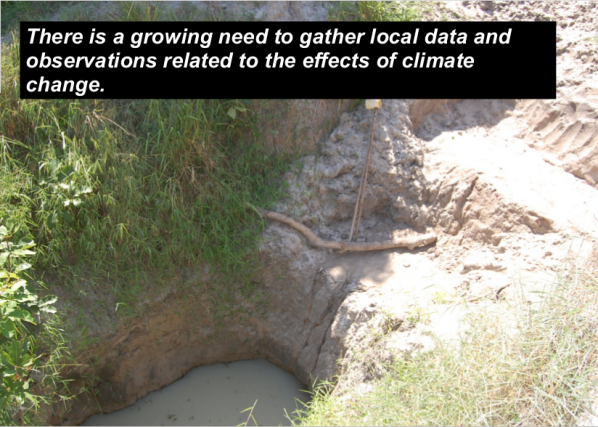
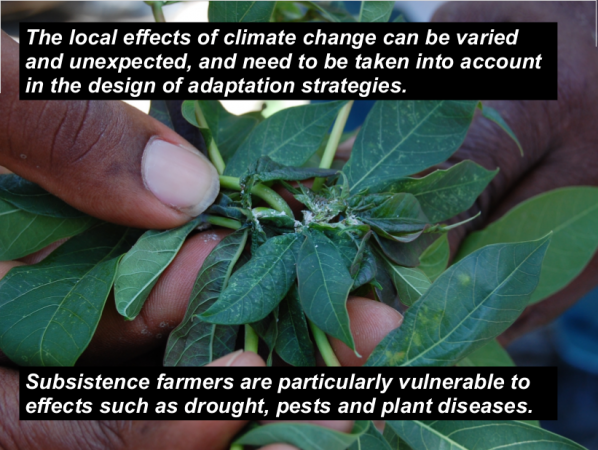
The farmers I have met in Bagamoyo have a very strong sense of community. Although their farms can be very far apart, sometimes with no roads between them, they still get together very often. They work together, learn together, have fun together. That’s the biggest lesson I’ve learned: we need each other’s presence. Quoting “Bifo” again, we are living in a time of precarization of the encounter of bodies in physical space. I agree with him that the most important poetic revolution has to be the re-activation of bodies. The farmers, with the great efforts they make to get together, and the great joy they find in doing so, have taught me a great deal: I need to get out of Facebook and step in to the “here and now”, together with others.
MG: What has this experience taught you. And how will it impact your future practice as an artist?
ET: I have partially replied to the first part of this question. But besides learning how to re-dimension the importance of computers in my life, I have also learnt a lot about agriculture. This is not a minor thing for me: after all these years of living in big cities, and realizing that I lack a basic connection to the earth, I believe I have found the best possible teachers. Of course, I’ve also learnt a lot about how to work with non-expert users of technology. This has made me better as a teacher. And, as you can imagine, many of the things we take for granted at home won’t necessarily work in Bagamoyo. So, doing projects in difficult environments has taught me to adapt, and to transform things that escape my control into opportunities. All of this changes me, not only as an artist but as a human being. My artistic practice is already quite different from what it was before Sauti ya wakulima. I have adopted a very critical position towards technology. Now, this is also a major shift: I started programming creatively when I was ten years old, and have been a media artist almost since then. But I feel I can’t go on with those artistic explorations, knowing what I know now. Consequently, last year I wrote and published a small note explaining why I stopped creating works of e-Literature, a field in which I was involved for more than ten years [5]. That was both a closure and a point of departure. Let’s see what the future brings.
Excerpt from ‘Why I have stopped creating e-Lit’ by Tisselli (November 25th, 2011)
Dear friends: this morning I went for a walk along the Naviglio Grande in Milan, and I entered a shop selling second-hand books. There I found a small book, “The Computer in Art”, by Jasia Reichardt, published in London in 1971. The book described the works of pioneers of Computer Art, such as Charles Csuri or Michael Noll, who were active at that time. A real gem. But the biggest surprise came when I turned to the last page, on which the previous owner had written: “I married on 23, November. I would like to be a man, not artist, not engineer, a man.”
I took the book with me.
Those involved in the Sauti ya wakulima / The voice of the farmers project.
The farmers: Abdallah Jumanne, Mwinyimvua Mohamedi, Fatuma Ngomero, Rehema Maganga, Haeshi Shabani, Renada Msaki, Hamisi Rajabu, Ali Isha Salum, Imani Mlooka, Sina
Rafael.
Group coordinator / extension officer: Mr. Hamza S. Suleyman
Scientific advisors: Dr. Angelika Hilbeck (ETHZ), Dr. Flora Ismail (UDSM)
Programming: Eugenio Tisselli, Lluís Gómez
Translation: Cecilia Leweri
Graphic design: Joana Moll, Eugenio Tisselli
Project by: Eugenio Tisselli, Angelika Hilbeck, Juanita Schläpfer-Miller
Sponsored by: The North-South Center, Swiss Federal Institute of Technology – Zürich
With the support of: The Department of Botany, University of Dar es Salaam (UDSM)
Sam Renseiw and Philip Sanderson’s Lumière & Son project is a near perfect and altogether exhilarating sequence of moving image lyric poetry (though lyric here does not exclude humour or the grotesque) and a demonstration of how seriality and fragment – an unfolding over time, the diaristic – has quietly become one of the fundamental modes brought stage centre by the network (so much more than the rather dull ‘interactive’ which has so quickly become the standby of the monetised digital). Impossible to watch one of these pieces without the desire to watch just one more.
The set (which lives online but has been shown offline in whole and part) and its component pieces, moreover, are studies in various interesting things: the liberating effects of constraint and collaboration and what those both demand and imply; also of randomness, or perhaps better, the loose, the dashed off, differing degrees of accuracy in such collaboration (also the apparently dashed off, the apparently loose [also the apparently synchronised or ordered]).
To start with, a little history. In 2007 two young members of the digerati, Andreas Haugstrup Pedersen and Brittany Shoot, invented a form and threw down a gauntlet. The form, in fairness, was not exactly new – over 100 years old, actually – but its re-contextualisation within the digital realm and more particularly on the network was, without exaggeration, a stroke of genius[1]. It involved taking precisely the constraints affecting the films of the cinema pioneers, the Lumière brothers, and applying these to contemporary online video work. Films or videos of exactly one minute, fixed camera, no sound, no zoom, no edits. Such videos dubbed, naturally, ‘Lumières’. There was clear recent precedent in the constraints of the Dogme movement of Von Trier and others but the project also drew on the various little-bit-art-little-bit-geek, young, playful cultures which abutted and intersected the more formal area which we called, for a while, ‘net-art’, and which thrived on a sparky and often competitive and showy overcoming of the early net’s limitations of file size and bandwidth – projects like 5k.org, 10secondfilm.com spring to mind.
Additionally, because the start of modernism still does not really seem all that far away, early film was a natural reference point for many wrangling the early internet as art tool and channel both.
We responded viscerally to the sheer, almost willed-into-being, expressivity of the ad hoc devices and solutions of early film and this fitted snugly with the bodges we ourselves were employing. It gave us confidence, too, that our ducking and diving too could be expressive but also it confirmed a certain tendency to lo-fi-ness there in the zeitgeist. (I speculate – a lo-fi-ness which helped to define and declare art – useless, beautiful and human – as against the slickness of corporate design, communication and advertising… This has persisted remarkably – note the thriving on-going cult of the animated gif)
That was the form. The challenge – make some. Embrace that 100+ year old limitation and do something engaging with it. Push the form as far as it will go.
Pedersen and Shoot set up a web site where all contributions would be aggregated and indexed (in retrospect, somewhat unfortunately, by links rather than copies held on their server – much work of historical significance has already vanished. Shoot and Pedersen themselves have moved on and the site has a Marie Celeste feel). In addition to the site itself, there was a Lumière manifesto which, personally, I found a little narrowly focussed. Shoot and Pedersen seemed to invoke a near ethical dimension to the return to first principles and in their own moving image practice confined themselves to work (much of it very good) entirely within this discipline. It was clear from the huge response of other artists and film-makers though that the form clearly answered a diverse set of pressing needs. For some it was a cleansing activity, for some a sketchbook, for others a spur to invention and for others still, a challenge in the sense of “How can I observe the spirit of the rules whilst actually driving a coach and horses through them?”
Although the Lumière made next to no impression on the ‘official’ world of art video (one speculates – cynically, perhaps – too democratic and available to anyone with a cheap camera, too ontologically opposed to the expensive grandeur of high concept, too hands-dirty in a world where artists aspire to hire videographers and editors to realise their art; in short, too lacking in the conspicuous consumption that validates much contemporary work), it was enthusiastically taken up by a mixed bag of videobloggers and artists excited by the idea of video specifically made for the net.
An immediate adopter and one of the most enthusiastic and prolific makers of Lumières was the Danish architect, educator and thinker, Thomas Wiesner, who operates in online video as Sam Renseiw and maintains a quirky and engaging site called Spacetwo: Patalab. Renseiw (as he prefers to be known in a video context) is a maker of numerous very singular small video works, which evince his keen interest in space and movement within spaces. (He teaches not only architecture but also a course for dancers involving approaches to conceptualising movement in space). I’m not sure Renseiw completely understands how original his work is. It is characterised by a joy in careful, quizzical looking (and a spontaneity in finding or being gifted subjects for such looking, assisted enormously by the continual development of more portable and discreet video cameras). It is, in terms of the formal art world deeply unfashionable. Personal and diaristic, it eschews the grand concept and extravagant and expensive execution and is all the better for this.
Renseiw has a profound sensitivity to space and to how people and objects move along variously restricted and open trajectories but he is mindful too of what the ‘actors’ in these found scenarios, set out to do and in fact achieve as human beings. The gap between aim and reality provides fertile ground for Renseiw’s dry and humane sense of humour, which is never far distant.
Significantly his prolific Lumière making (337 at the time of writing) sits side by side with longer (though still lapidary) works with music, editing and the other things the Lumière eschews.
Renseiw’s Lumières are characterised by a number of quite distinctive things. Something that unites them all is a quite extraordinarily heightened sensitivity to both colour and composition, which formal feature hits us forcefully in the moments even before we begin to decode any content or action. Formally striking too is the way in which a number of the pieces are composed so to as to allow for action in the near, middle and far distance, sometimes in different sectors of the frame, sometimes simultaneously in a kind of layered visual counterpoint and sometimes spread out temporally. My imputed intentionality here is somewhat problematic, though Renseiw confirmed to me that he shoots much more material than he uses and that he will select a particular minutes worth of material from longer sequences so on two counts there is a rudimentary (though nominally forbidden) editing process occurring. A quick comparison with Lumières by other film-makers will however confirm that Rensiew’s singular vision distinguishes each of his pieces from the off.
Other signatures are extremely low, oblique or occluded camera positions, into the fields of which parts of human bodies mysteriously intrude. This sounds clinical. Curiously it is the opposite. Redeeming it is a genial humour which allows the part to stand for the whole – we perforce imagine the entire human being whilst smiling at the V-effekt with which we are presented – for example a pas de deux for a pair of woman’s black leather boots (on the ends of beyond-the- frame legs) and the four paws of a black dog – randomness, clumsiness, near misses, narrow escapes and – we just know because we are human – purposeful activity. Human life, in short.
Another defining stamp is a musician’s sensitivity to rhythm and tempo – rhythm as manifested both as near metronomic regularity – someone’s gait, traffic flow, a hammer, for example, with either disruptions – slowings down, speedings up, pauses, stutterings – to that regular pattern, or polyrhythms created by other simultaneous independent near regularities and variations therefrom.
There are three loose categories into which Renseiw’s Lumière work could be said to fall (of course they’re by no means entirely mutually exclusive) – we’ll call them the loop-able, the documentary and the performative. The loop-ables are kin to the still photograph, are often of natural phenomena or repetitive but irregular human engendered activity where one could imagine the minute’s imaging infinitely, hypnotically extended – the flashing light patterns in Belisha Code for example. The documentary tag applies where the topic itself might be assumed to have some independent interest, for example the workers transporting away in a sling Copenhagen’s Little Mermaid for a trip to Shanghai’s 2010 expo in Speaking Voice or Michelle Obama’s motorcade in Rite of Passage. In what I’ve called the performative, richest of all in my view, an amazing amount of stuff happens. And everyday stuff happening and rendered vital by keen eye, framing and selection rather than something we might have known to look out for, is key. The differently distanced layers referred to earlier partition the frame physically or the piece temporally and unexpected things happen against and within them. We participate in these dynamically as viewers – we view this strange jigsaw world and complete it mentally; sketch a world beyond which is not simply our lived world but that world somehow leavened with Renseiw’s odd and warm sensibility.
I’ve written pretty glowingly about these Lumières – constrained, silent but surprisingly un-austere and you could well think that to add sound, music or both and several layers of these to boot might be over-egging it all somewhat. So one would think, but I have complimentary things yet to say about skill, tact, panache, flair and sensitivity and they are heading the way of Philip Sanderson, Renseiw’s musical/sound collaborator in the extended Lumière and Son project.
Renseiw’s Lumières are, I hope I’ve established, rich, dense, multi-layered but remarkably uncluttered works. A number of these pieces approach as closely as possibly the condition of music whilst remaining wholly without sound. It might seem superfluous or an act of hubris to add sound to them, the consequence of which could be to render leaden, stiff and fixed what is light, playful, complex and turns on a sixpence.
With the exception of a couple of near misses Philip Sanderson’s sound and music additions triumphantly avoid this trap and indeed deepen those rich and quicksilver qualities.
It’s important to note that what Sanderson contributes is all found or appropriated material – it’s possible he’s added original material in, I don’t know, but it’s not a significant chunk if he has – he certainly reworks much of it intensively, usually in the form of a mix of several layers of sound, some musical, some textual. (And we should note that Sanderson’s wit and deftness is literary as well as musical).
The deployment of sound gains enormously from Sanderson’s huge and eclectic range of knowledge, reference and enthusiasms. There’s a cooking metaphor in here – mixing the ingredients, finding just the right, perhaps almost imperceptibly present flavourings, knowing the qualities of things and how to combine them well…
Elsewhere I have asserted that the key feature of the most successful short form video work is a combination of intense poetic compression with a huge range of suggestion. I called this opening-out – a universe from a speck of dust. An ability to evoke the range of connectedness of many disparate things by well-chosen images, sounds, texts, whatever can pertain to moving image. Certainly Renseiw’s work has this in spades. Sanderson’s sound opens-out the movies still further. It adds, almost literally, an extra dimension, as if enabling new angles of view. It provides paths, bridges, vistas, tunnels, maps, balloons, telescopes, and sonar.
The guiding methodological principle seems to be a species of metonymy and one moreover which suggests an, in practice entirely non-existent, explanatory or illustrative dimension. The flashing beacons in Belisha Code are accompanied by a recording of a numbers station where one’s immediate impulse is to construct entirely absent meaning in the correspondence of the binary on-off of the four beacons and the German numbers from zero to nine heard on the soundtrack. Let’s be clear that this is not a criticism – a rigorous correspondence would be leaden – closed-in – but what we do have is a rich package of suggestion and affect. The correspondence that does exist is formal and temporal, between the flashes of the beacons and the articulation of the words and where the same sort of rickety polyrhythms that we’ve observed within the original Lumières themselves ensue.
Although comparison of some of Sanderson’s sources with their use in the pieces evidences, on occasion, some quite detailed cutting, mending and buffing-up there is an inescapable sense in his deployment of sound of the somewhat aristocratic tradition of the modestly dashed off. It’s partly his clearly extensive knowledge of his sources and his evident skill with a huge variety of genres but it’s also to do with a certain ambiguity in how the sounds are placed – not four square upon, but athwart the images, the sound often only fading or vanishing well after we’re into Renseiw’s end titles. Sometimes the sound is clearly not cut to shape in the way one might at first expect – an introduction, for example proper only to the original sound itself and not to any clear visual motivation might be left standing. The imperfections, noise, oddities and glitches contained within each block of appropriated sound intensify this sense of informality as does the slightly culinary air referred to previously. On the other hand, often enough to matter, the sound directly lines up in a spine tingling way with a particular action. It’s a master class in expressive ambiguity.
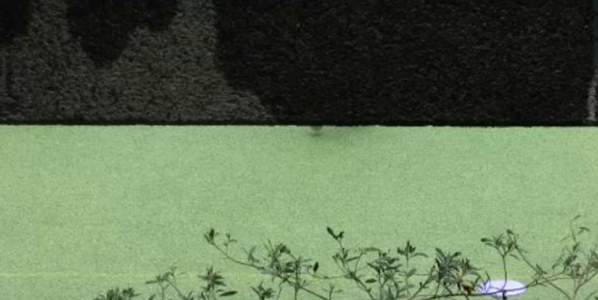
Renseiw – physical poetry, the occlusion, constraint. The careful choice of footage (variety and kind of motion within a narrowish range). Humanism: we don’t see faces, we don’t hear voices, we are amused but we recognise ourselves, youth and age &c.
Sanderson: The music found but could have been composed. The artfulness of placing it just thus. We will never know whether the way it ends with the action, the running off, taking place just after the repose of the final minor chord was deliberated or found. For me this placement implies a universe beyond the letterbox. It has a commonality with the treatment of time in many photographs and paintings – this is an instant, a fragment, but there was a before and an after.
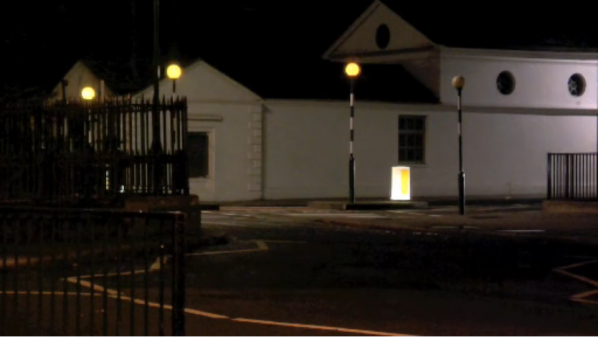
Note that there are four beacons. The sound (a numbers station, one can almost track the archaeology of impulse!) draws on the numbers 0-9, in German. It’s worth noting there is no obvious mathematical mapping between the pattern of the beacons and the numbers but the character in sound of the numbers is close to that of the beacons in light. Suggestion, metonymy.
This forces our attention very strongly on that area of the screen, with the concomitant effect that when we force our attention away it is as if our eyes have been suddenly opened. There is a world out there.
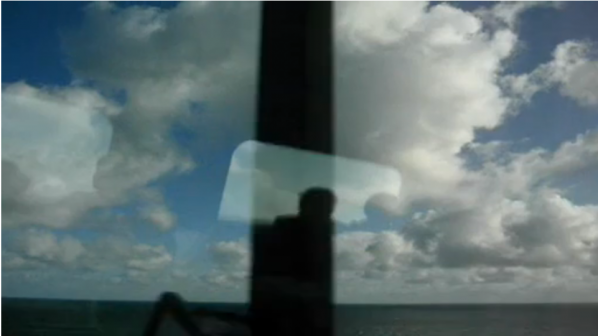
There is a hint of the transcendent in the title – how is this realized? Unless we know Denmark it takes a few moments to realize we are on a train rather than a boat or plane – we are clued into this by the close objects we clearly pass at speed and the reflection of passengers and seating in the windows. One speculates that the sound track is comprised of two elements – one the rhythmic and metallic pulse which somehow rhymes with the passing object (a kind of pseudo-diegesis) and the second an (Open University?) lecture on relativity.
Here, not exactly metonymy but something more fragile, delicate chains of suggestion and subtle resonance. No argument (to see an argument in any of this would be to commit a category error) but a complex and suggestive …um…thing. One should also note that this piece (in both its silent and extended versions) is extremely beautiful.
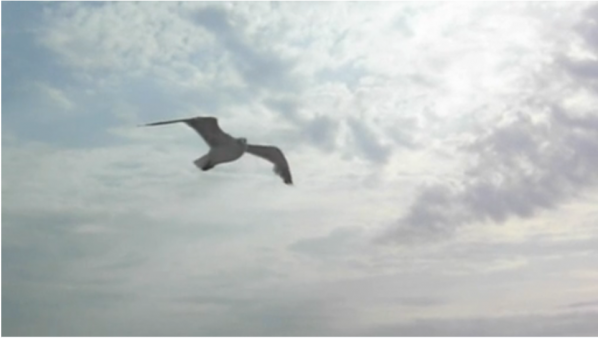
Let’s talk about the sensibility and taste of the makers. Renseiw offers something simple, a kind of tour de force – we perceive it as such although given the fixed camera constraint any virtuosity belongs to the seagull.
A banal seasoning of music would involve simply the seven note modal motif which hails, I’m almost certain, from American popular song of the 70s big country type – Wichita Linesman, you know the sort of thing. (I checked with Sanderson –it’s Bobby Goldsboro’s Summer The First Time) By itself it would be too perfect, too parallel to the floating bird (it seems to give way to a crashing wave sound in its looped form; interestingly the Goldsboro video I found on YouTube begins with a shot of gliding seagulls). With too much parallelism nothing extra arises but Sanderson spices the mixture by the addition of dialogue from what sounds like an American film of the forties or early fifties. It disrupts the idyll but only so as to make us more aware of it. There is a kind of musical V-effekt here (which could have been so badly handled and so isn’t). This is its ‘meaning’ – these things! Here, now!
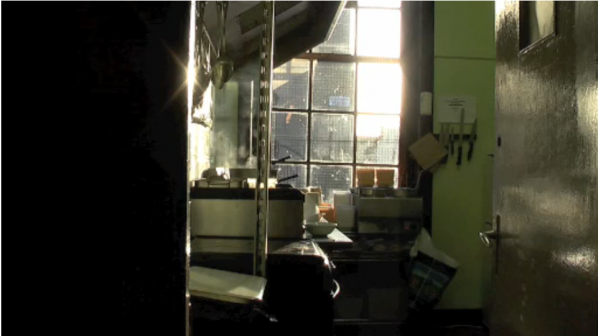
There is something of the dance about this. The music beautifully picks up both the nervous, sudden gestures of the cook but also suggests the process of cooking itself. The music has a funk component. One might say that it cooks.
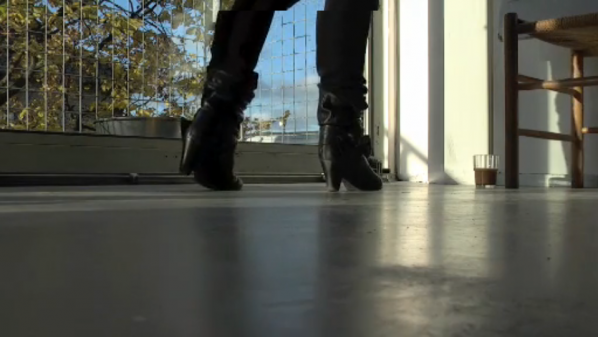
Visually – the low angle, the fragmented view of the body, the person here and not here. The focus on that person which permits and invites its opposite, in particular the framing of the sky and trees. The rhyme between the black-booted two legs of the woman and the black four legs of the dog. Their pas de deux. The music here subordinate, properly so. Ambient sounds, on the one hand, with odd vocal snatches on top. The strangeness doesn’t demand our attention because we are so focused on the visual.

Until the last moments we simply hear a fitting (slightly arch) accompaniment to the skating – we surmise that it is intended to pastiche the kind of accompaniments used in professional skating. At the last moment we realize this is exactly what it is, as the commentator’s voice breaks through. There is also a ‘skate’, ‘friction’ or ‘traveling’ noise which exactly underpins the final move we see, just before the humour of the juxtaposed text, which continues after the movie has gone to black, strikes us: “Delightful, skating of the highest quality” delivered in classic plummy BBC tones…

A hugely rich piece: visually there are a number of layers – the far left street background where distant people and vehicles process. The game of Petanque: – the actual participants (although glimpsed corporeally only twice: fleetingly at the very end and as one set of typical Renseiw-y legs) and the balls themselves (and the metonymic link between these and the planets). Thirdly, the large shadows. (And the apparent size of each of these layers allows for very clear visual interaction). Sound – the ‘light’, jokey, playful music. The University Challenge soundtrack, here unusually clearly cut up – questions – astronomy; replies – painters. A risk for Sanderson, but one that works.

A little detective work indicates the level of detailed truffling about by Sanderson – part of the sound, the text, is grabbed from a YouTube video about French patisseries in London and cut up considerably – in particularly yielding the repeated incantation “cream cakes, tarts, macarons” the latter word in a considerably overheated French accent following the sloaney first three, to deeply comic effect. Comic maybe but, repeated, as in a dream; this mood is reinforced by a rather beautiful waltz time solo piano loop of the opening line of The Associates’ Party Fears Too. Here’s another piece where the visuals, here also dreamy and wistful, set in a looking glass Copenhagen (and the disjuncture between the London-location heavy narrative and the visuals is simply ignored, taken for granted, part of the deal), support quite a complex sound assemblage. Utterly haunting and quite difficult to say exactly why.
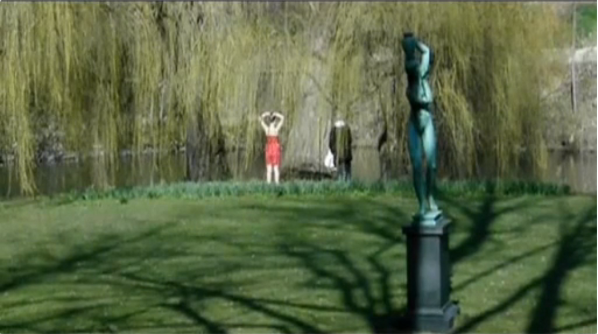
If one didn’t know it wasn’t one would surely assume this was carefully planned, and our knowledge it was not adds to our pleasure in it. Visually the rhyme between the woman and the near foreground statue is perfect – at one point she seems to mirror it exactly. Maybe she knows the area well and there is some unconscious mental echoing…we’ll never know. The other sharp visual pleasure is the smallness of the area of focussed distant activity, which again feels like a sort of directorial chutzpah, except, except…
Sanderson’s contribution is razor-sharp – the pseudo dialogue hits the mark precisely but doesn’t outstay it’s welcome – or at least there’s other stuff going on to detain us, not least the way the model’s preliminary warm-up shimmy becomes a perfect piece of minimal dance when set against the music.
Right of Passage/Speaking Voice
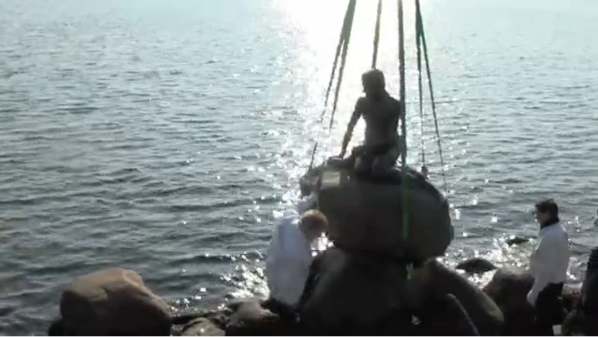
I wonder if when the content has it’s own ‘documentary’ interest, when the filming becomes a case of “Look at this remarkable thing not because of its intrinsic interest but because it happened”, the final result is somehow less engaging?
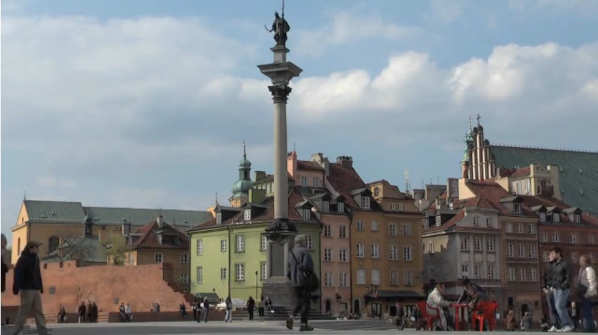
Again a dance related piece – the regular beat of the calling of the numbers one to eight sets up an aural grid against with which the implicit rhythms of the movement in, out and across frame interact in a sophisticated but subtle polyrhythm. Part two of the sound, with actual step instructions, ups the tension and the effect (especially the late entering ‘spinning’ man). Note how often in these pieces the sound fades out slightly later than the visuals, over Renseiw’s titles, thus emphasising its separate existence in an independent channel or dimension.
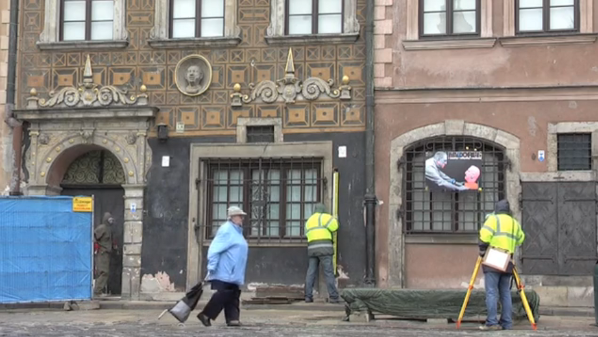
Beautiful found synthesis. Funny. Funny and truthful and touching.
The moving image is packed with incident at both different spatial levels and at different points in the piece. The Portsmouth Sinfonia version of Dance of the Sugar Plum Fairy underpins like a grid, as with Square Dance but in a more complex way, the visual rhythms of the film. Enough coincidence of rhythm to feel planned, enough ‘pull outwards’ to feel open… Again humour… Why does the Portsmouth Sinfonia track, in particular, work so well – atmosphere? the conjuring of a sort of raggedy clockwork ? – can we imagine in its place a more conventional rendering of the Tchaikovsky? Yes, but…
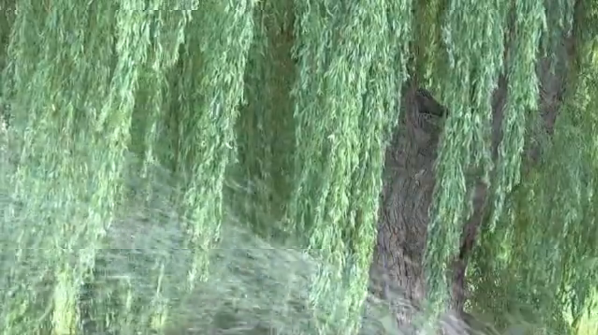
Prime example of Sanderson mind set – metonymy, suggestion – the trees are hair, the water appears exactly on cue (worked? Hmm – the audio appears to be cut to make the word ‘rinsing’ and the water jet coincide)
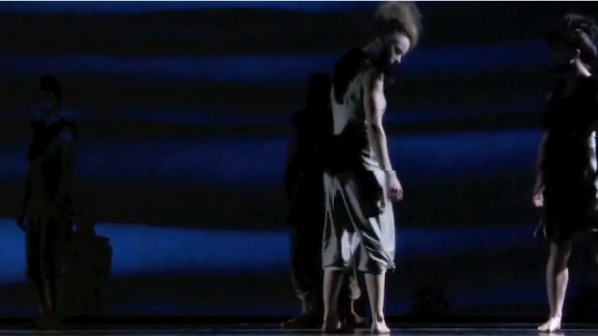
A one liner, but, given its place in the sequence, none the worse for it.
Brass band/Dancers.
*The pieces loosely divide into ones where either sound or vision predominate and some where they have equal roles.
* Not only does dance appear a couple of times explicitly as a subject but the spirit of dance pervades the project.
*The question of the success of individual pieces and of the sequence – a piece that seems less effective in isolation can well form an effective point of relaxation or reflection in the sequence as a whole…
*There are three pieces which, if one ‘re-removed’ the sound, would not strictly be Lumières – Check Out Art Fairs (speeded up), A Beauty Overblown (slowed down) & Sucked In (reversed). Sanderson performed the first two operations for reasons he felt the sound he used demanded. (To which one can only say: yes, this is right, a constraint is there for the sake of art, not art to be constrained.) Sucked In remains a mystery.
*The titles matter (note the re-titling of the composite works). They provide yet another dimension and illumination too.
*The prevailing tone is light, warm and playful. The darker side of life is largely absent, at least explicitly (though there are trails we could pick up to find it). Humour is everywhere. Only a philistine or fool would judge the work as a consequence to be less ambitious, significant or universal.
“Tweets in Space beams Twitter discussions from participants worldwide towards GJ667Cc – an exoplanet 22 light years away that might support extraterrestrial life. By engaging the millions of voices in the Twitterverse and dispatching them into the larger Universe, Tweets in Space activates a potent conversation about communication and life that traverses beyond our borders or understanding.”
Marc Garrett: Could you explain to our readers what ‘Tweets In Space’ is?
Scott Kildall and Nathaniel Stern: Tweets in Space is an art project — a networked performance event — which beams your Twitter messages to a nearby exoplanet that might support human-like, biological life. Anyone with an Internet connection can Tweet with the hashtag #tweetsinspace during the performance time, and their messages will be included in our shotgun blast to the stars. The performance is on September 21st, 20:30 – 21:00 Mountain Time (3:30 AM BST / London time).
MG: What was the motivation behind your current collaboration?
SK and NS: We found inspiration from various sources. First, in NASA’s Kepler mission, whose purpose is to discover planets in the “habitable” or “Goldilocks” zone. The project has found over 2000 exoplanets thus far, all of which are “not too hot, not too cold, but just right” for life as we know it. Scientists now estimate that there are at least 500 million planets like this in the Milky Way alone. Our conclusion: extraterrestrial life is almost certainly out there.
![The newly discovered planet is depicted in this artist's conception, showing the host star as part of a triple-star system. Image credit: Carnegie Institution / UCSC. [1]](http://www.furtherfield.org/wp-content/uploads/2012/09/planet_gj667cc.jpg)
“The latest discovery is at least 4.5 times bigger in size than Earth. Reportedly, the planet exists 22 lightyears away from Earth and it orbits its star every 28 days. The planet is known to lie, in what is being referred to as the star’s habitable zone. A habitable zone is a place where the existing conditions are just perfect for life sustenance. Astronomers, according to this report also suspect that the GJ667Cc may have been made out of earth-like rock, instead of gas.” [ibid]
Another source of great inspiration is how we use social media here on Earth. This is our second, large-scale, Internet-initiated collaboration. In 2009, we amplified the power structures and personalities on Wikipedia, and questioned how knowledge is formed on the world’s most-often used encyclopedia – and thus the web and world at large. Now, we are turning to the zeitgeist of information and ideas, feelings and facts, news and tidbits, on Twitter. The project focuses on and magnifies the supposed shallowness of 140-character messages, alongside the potential depth of all of them – what we say in online conversation, as a people.
We are directing our gaze, or rather tweets, via a high-powered radio telescope, towards GJ667Cc – one of the top candidates for alien life. It is part of a triple-star system, has a mass that is about 4 times that of Earth, and orbits a dwarf star at close range. GJ667Cc most certainly has liquid water, an essential component for the kind of life found on our own planet.
MG: Right from its early years when Jagadish Chandra Bose [2], pioneered the investigation of radio and microwave optics – science, technology and art have had strong crossovers. And it might be worth mentioning here that Bose was not only well versed as a physicist, biologist, botanist and archaeologist, he was also an early writer of science fiction. [3] Which, brings us back to ‘Tweets In Space’, wherein lies themes relating to science fiction, radio broadcasting (commercial, independent and pirate), wireless technology of the everyday via our computers, and ‘of course’ the Internet.
![J.C. Bose at the Royal Institution, London, 1897.[3]](http://www.furtherfield.org/wp-content/uploads/2012/09/JC-Bose-at-the-Royal-Institution-London-with-his-radio-equipment-The-date-is-1897.png)
But, what I want to pin down here is, where do you feel you fit in historically and artistically with other past and contemporary artists, whose creative art works also involved explorations through electromagnetic waves?
Scot Kildall: The work of JC Bose is incredible and what strikes me is that he eschewed the single-inventor capitalist lifestyle in favor of his own experiments. Isn’t this the narrative that artists (often) take and linked back in many ways to the open-source/sharing movement, rather than the litigious patent-based corporation? And it mirrors in many ways the reception of electromagnetic radiation as well. You can’t really “own” the airwaves. Anyone who is listening can pick up the signal. This comes back, as you point out, to the internet. Twitter is now, one of the vehicles, and, ironically entirely owned by a benevolent* corporation.
Nathaniel Stern: (Agreeing with Scott) and we can’t forget of course Nam June Paik, who played with naturally occurring and non-signal based electromagnetic fields to interfere with analogical signals (as well as the actual hardware) of tube televisions, and more. And of course, there have been other transmission artists, explored in depth by free103point9, among others. I think, like them and others, we are messing with the media, amplifying (figuratively and metaphorically) and intervening, pushing the boundaries of DIY and cultural ethico-aesthetic questions…
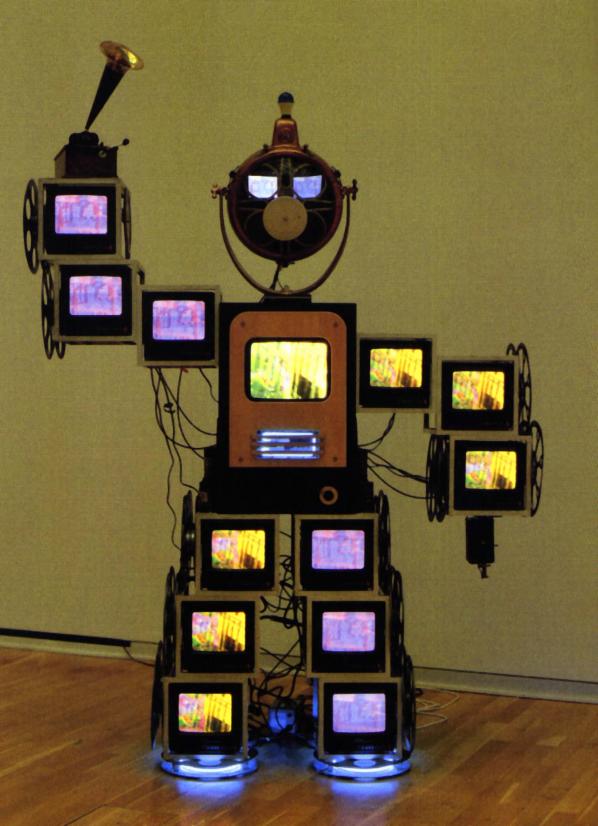
MG: What is especially interesting is that all the tweets submitted by the public are unfiltered. How important is it to you that people’s own messages are not censored when going into space?
SK and NS: Absolutely. Tweets in Space is by no means the first project to transmit cosmic messages with METI technologies (Messaging to Extraterrestrial Intelligence). Our fellow earthlings have sent songs by the Beatles, photos of ourselves shopping at supermarkets, images of national flags, and even a gold record inscribed with human forms – controversially, where the man has genitals and the woman doesn’t. These slices of hand-picked content exhibit what a select few believe to be important, but ignore, or willfully exclude, our varied and collective modes of thinking and being.
Tweets in Space is “one small step” with alien communications, in that it is open to anyone with an Internet connection. It thus represents millions of voices rather than a self-selected few. More than that, our project is a dialog. There have been, very recently, a small number of projects that similarly “democratize the universe” but none are like ours: uncurated, unmediated thoughts and responses from a cooperative public. We can speak, rebut, and conclude, and nothing is left out. Our transmission will contain the good, the bad, and the provocative, the proclamations, the responses, and the commentary, together, a “giant leap” for all of humankind – as well as our soon-to-be friends.
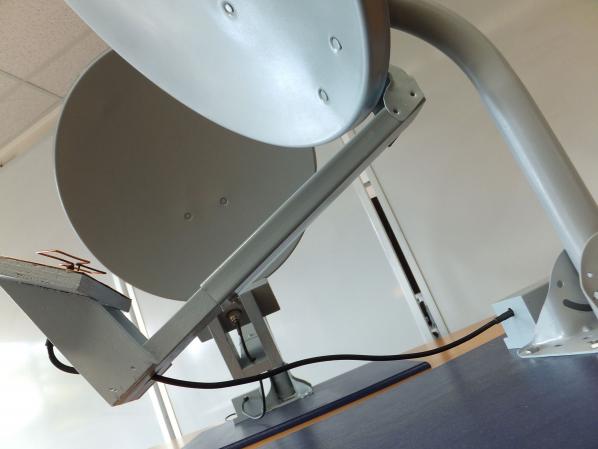
Furthermore, by limiting the event to a small window of only 30 minutes, we are encouraging all our participants to speak then respond, conversing with one another in real-time, through networked space. We are not just sending lone tweets, but beaming a part of the entire dialogical Twitterverse, as it creates and amplifies meaning. Tweets in Space is more than a “public performance” – it “performs a public.”
MG: Now, you will be transmitting real-time tweets toward the exoplanet GJ667Cc, which is 22 light-years away. How long will it all take to get there?
SK and NS: Well, first off, we’re collecting all of the tweets in real time, but only sending them out later in October. The main reason for this is that we have to wait for the planets to align – literally. We want line of sight with GJ667Cc from where our dish is. The added bonus of time, however, is that this will allow us to really flesh out how we send the messages in a bundle. We want to include a kind of Rosetta Stone, where we will not only send binary ASCII codes of text in our signal, but also analog images of the text itself. We additionally intend to choose the most frequently used nouns in all the tweets from our database, then give a kind of “key” for each. If “dog” is common, for example, we can transmit: 1. an analog image of a dog, like a composite signal from a VCR; 2. a text image of the word “dog” in the same format; and 3. the binary ASCII code for the word dog.
In terms of time/distance, when speaking in light years, these are the same thing. A light year is the distance light can travel in one year of Earth time (about 9.4605284 × 10 to the 15 meters). Since radio travels at the speed of light, a big dish on GJ667Cc will pick up the signal in 22 years. We should start listening for a response in 44 – though it may take them a while to get back to us…
MG: Will the code used for the project be open source, and if so, when and where can people expect to use it?
SK and NS: Yes it is! The most useful part of our code is the #collector, which saves real-time tweets to a database, that can then be used for live projections or web sites, or accessed and sorted later via all kinds of info. The problem is that it’s not really user friendly or out of the box – folks need a suped up server (VPN), and to plug into a few other open source wares. The main portion of the backend we used is actually already available at 140dev.com, and then we plugged that into Drupal, among other things. For now, we’re telling interested parties to contact our coder, Chris Butzen, if they want to use our implementation. And we hope to do public distribution on tweetsinspace.org if we are able to package it in a more usable format in the next 6 months.
MG: Are there any messages collected so far, grabbing your attention?
We’ve had thousands of tweets so far – even while just testing the ware in preparation for the performance. We’re anticipating a lot of participation! The tweets we’ve seen have ranged from variations on “hello [other] world” and “don’t eat us,” to political activism and negative commentary, to a whole surreal narrative of about 30 tweets per day over the last 3 months.
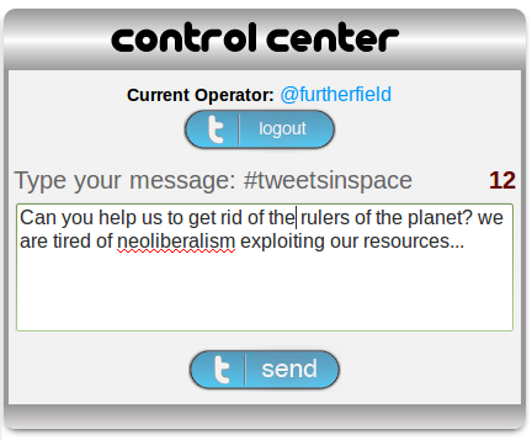
go to tweet aliens to add your own words…
Some of our favorite tweets have been those that question how to make our own world better. These speak to both the hope of space age-ike technology, as well as the hope in collective dialog – both of which our project tries to amplify. Such tweeters ask about the alien planet’s renewable energy sources, tax structures, education, art, and more.
We imagine the 30-minute performance will see a much more potent discussion about such things, and hope your readers will participate. The final transmission will be archived permanently on our site once we’ve prepared it for launch.
As part of the International Symposium on Electronic Art in New Mexico (ISEA2012). We will collect your tweets and transmit them into deep space via a high-powered radio messaging system. Our soon-to-be alien friends might receive unmediated thoughts and responses about politics, philosophy, pop culture, dinner, dancing cats and everything in between. By engaging the millions of voices in the Twitterverse and dispatching them into the larger Universe, Tweets in Space activates a potent conversation about communication and life that traverses beyond our borders or understanding. http://tweetsinspace.org/
AND THEY WILL BE SENT INTO DEEP SPACE!!!
Watch the stream LIVE here – http://tweetaliens.org/tweets/tweets.php
ALL WELCOME
A project by Sarah Waterson and dogs (and their human companions) of Finsbury Park.
+ Dog walks: every Wed-Sat, between Wed 17 October and Fri 30 November 2012
Laika’s Dérive invites Finsbury Park’s dogs and their human companions to record a walk in their local park and surrounding area. This walk offers a chance for interspecies communication and a sharing of knowledge that results in a collaborative mapping of each dog/human’s walk.
Each dog is kitted-out with a system that automatically photographs the dog’s favourite vistas and objects on location. The photographs are selected via the sniff and interest time of the dog, and are returned to the human as a series of the dog’s favourite snaps, and displayed on Laika’s Dérive website.
Laika’s Dérive is part of the WWW: World Wild Web exhibition at Furtherfield Gallery.
To take your dog for a dérive, please contact Furtherfield Gallery at info@furtherfield.org or phone 0208 802 2827.
Walks can be booked by one person/dog Wednesday to Saturday between 1-5pm, from Wednesday 17 October to Friday 30 November 2012, so book early to avoid disappointment!
The kit collection point for the walk is Furtherfield Gallery, McKenzie Pavilion, in Finsbury Park.
Event Coordinator: Laura Bottin
Event Producer: Alessandra Scapin
Laika’s Dérive/Dog’s DeTour (2011) is a new media locative data-mapping work by Sarah Waterson about interspecies communication, collaboration and knowledge. Community participants and their dogs use an electronic mapping system (custom iphone app-GPS, accelerometer, interval timed and geo tagged photography) within their local area. The data collected is incorporated into the online mapping and visualisation system (website) together with the participant narrative and profiles. This work engages cross species sensing to explore a psychogeography of place.
A sketch for this project was produced during the Kiss Club incubator residency at the Performance Space, Carriageworks, Sydney. Feb 2010.(A minisite for the project prototype can be found here).
The android mobile phone application and harness system was developed during a residency at Blast Theory, UK, June- July 2011.
More info at http://laikasderive.sarahwaterson.net
Sarah Waterson
Sarah has practised as a new media artist for the past twenty years. Her works include electronic installations, collaborations with performers, video and audio work, generative and software based artworks, VR environments and data visualisations and ecologies. Interdisciplinary and collaborative practice informs the development and ultimately the design of these artworks. Her current interests include data mapping, data ecologies and cross species collaboration.
Sarah’s recent interactive installations have included: Laika’s Dérive (Performance Space, Carriageworks 2011), 33ºSouth (collaboration with Juan Francisco Salazar, Casula Powerhouse 2009), a custom made data mapping system that juxtaposes the cities of Sydney (Australia) and Santiago (Chile) trope, a e-literature project developed for the Second Life environment (SWF 08, ongoing), subscapePROOF (collaboration with Kate Richards, Australian Centre for the Moving Image, Melbourne), and subscapeBALTIC (ISEA2004, Helsinki, Finland). Sarah is a senior lecturer in interactive media at the School of Humanities and Communication Arts, University of Western Sydney, Australia.
Furtherfield Gallery is supported by Haringey Council and Arts Council England
FURTHERFIELD GALLERY OPENING HOURS
WWW: World Wild Web exhibition
18 October – 01 December 2012
Open Thu-Fri 1-5pm, Sat 11-5pm
Opening Event: Saturday 13 October 2012, 1-4pmFree admission to exhibition and events
Location
Furtherfield Gallery
McKenzie Pavilion, Finsbury Park
London N4 2NQ
T: +44 (0)20 8802 2827
E: info@furtherfield.org
So ArtForum have launched a special September issue investigating the, lets say broader, relationship between new media, technology and visual art.*
Of worthy mention is the essay Digital Divide by the art world’s antagonistic critic of choice Claire Bishop, a writer whom a little under 8 years ago, deservedly poured critical scorn over the happy-go-lucky, merry-go-round creative malaise that was Bourriaud’s Relational Aesthetics and all of the proponents involved. Since then Bishop’s critical eye has focused on the acute political antagonistic relationships, within the dominant paradigms of participatory art and the concomitant authenticity of the social.
In Digital Divide, Bishop asks a different question, and its delivered even more bluntly than usual. Why has the mainstream art world, for the most part, refrained from directly responding to the ‘endlessly disposable, rapidly mutable ephemera of the virtual age and its impact on our consumption of relationships, images and communication.‘ This is not to say the practices of mainstream artists do not rely on digital media (in almost all cases, it now cannot function without it), but why hasn’t the shifting sands of digital culture been made explicit? In Bishop’s words;
“[H]ow many really confront the question of what it means to think, see, and filter affect through the digital? How many thematize this, or reflect deeply on how we experience, and are altered by, the digitization of our existence?”
Clearly, there are exceptions and she mentions three examples by art stars Frances Stark, Thomas Hirschhorn and Ryan Trecartin which flirt here and there with digital thematisation. Conversely artists who once specialised in digital art, Cory Arcangel, Miltos Manetas – to name two very famous examples – have previously broken out into the mainstream.
But for Bishop, there is of course, “an entire sphere of “new media” art, but this is a specialised field of its own: It rarely overlaps with the mainstream art world (commercial galleries, the Turner Prize, national pavilions at Venice)” – (one could add art fairs here). But nonetheless “these exceptions just point up the rule“. Bishop’s focus is on the mainstream and, moreover, she contends that “the digital is, on a deep level, the shaping condition—even the structuring paradox—that determines artistic decisions to work with certain formats and media. Its subterranean presence is comparable to the rise of television as the backdrop to art of the 1960s.” True enough, this structuring paradox is an implicit problem with the mainstream art world, but thats not the problem tout court.
From the responses I’ve read both in the article comments and in subsequent blog posts, a particular issue has been marked with Bishop’s statement that “new media” art is a specialised field. Whilst it doesn’t qualify as a dismissal, one could certainly suggest that Bishop is partly guilty of the same disavowal she throws at the mainstream art world when she relegates this sphere as an ‘exception’. In a blog-post response, Kyle Chayka makes a similar point; “Bishop understands that digital technology forms a seedbed for art as well as life, but fails to uncover the artists who are already critiquing that context.” I’m not a Lacanian, but maybe this is a symptom of something.
If mainstream art is ‘the rule’, (and I’m insinuating ‘the rule’ as anti-metaphor here) perhaps ‘the rule’ isn’t worth paying attention to, considering that the new media art exception is too much of a ‘specialisation’. In as much as one can only agree with Bishop’s call for mainstream art’s negotiation with digital thematisation, has she not missed the same aesthetic questions already posed and re-composed in this exceptional sphere? Why should the qualifier of the mainstream be such a factor of importance here? Why not cut off the need to reconcile digital thematisation with a set of historical, and commercially ideological principles which may not take kindly to the more ambitious and darker questions that the social and political arena of global digitalisation have thrown up. This is not to say that Bishop isn’t seeking those questions nor does she wish to reconcile those principles, but the specialised sphere of ‘new media art’ may quench the questions she herself raises.
Case in point: all Bishop would have needed to reference is something like the Dark Drives exhibition for the transmediale festival earlier this year; the tag line “uneasy energies in Technological Times” sums up her main descriptions of a digital epoch quite nicely. For instance, the artist group Art 404’s 5 Million Dollars 1 Terabyte, renders explicit one subset of the absurd, copyright, exploitative logic of proprietary software, by saving one terabyte’s worth of unlicensed software onto a single hard drive. Next to it was JK Keller’s idiosyncratic piece Realigning My Thoughts on Jasper Johns, which showed off a glitchy, abstract bastardisation of a Simpson’s episode Mom and Pop Art – regurgitating haggard mainstream perspectives. Crucially the success of the show was down to the implicitness of the exhibition’s technical triumphs – where technical jargon is often touted as a reason for the mainstream’s averted gaze. Whilst the viewer didn’t need to know the technics, but a richer understanding emerged should they have wanted to know.
There isn’t any need to clog up this article with a bottomless plethora of pieces from other equally important exhibtions and shows (I’m sure many others are better qualified in doing so); my point here, is that Bishop cannot relegate new media art as an exception to the rule, when the digitalisation of media is becoming the rule, which she herself explicitly admits. Choosing to focus on the failure of the mainstream in this arena gives the essay a healthy line of questioning, but in relegating an entire sphere which has – for some time – repeatedly dealt with these questions and more, it raises what is effectively a pointless query. To be fair to Bishop, she isn’t trying to force a fecund translation of new media with mainstream values, but looking for methods where digitalisation can instigate the change of those values.
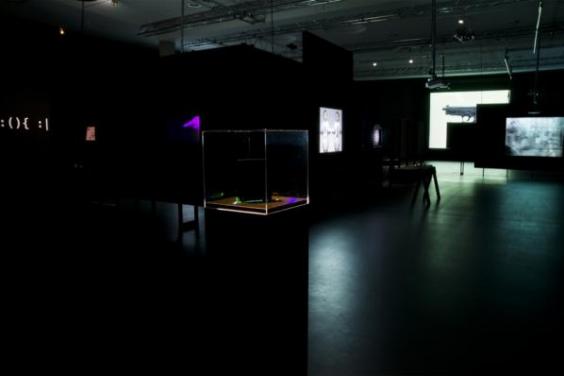
Granted, Dark Drives is one major show in a major Berlin new media festival – the top of a very extensive collection of disparate voices and influences – but it inadvertently highlights a salient thought. What if Bishop’s call to bridge the ‘Digital Divide’ was actually met by a new generation of artists thrust into the mainstream, where digital themes were translated into its own methods of commercial production? We’ve gotten over the myth that ‘virtual’ commodities are unmarketable, so it’s not as if I’m being negative for the sake of it. Where would this leave festivals like transmediale, or not-for-profit collectives like Furtherfield – how would they respond? It’s an uneasy question, one which for speculative purposes cannot be answered quickly at present, if at all.
In the throws of conjecture, there is perhaps another division at play here. Towards the end of her essay, Bishop makes a reference to the difference between the non-existent embrace of the digital medium today, and the rapid embrace of photography, film and video in the 60s and 70s.
“These formats, however, were image-based, and their relevance and challenge to visual art were self-evident. The digital, by contrast, is code, inherently alien to human perception. It is, at base, a linguistic model. Convert any .jpg file to .txt and you will find its ingredients: a garbled recipe of numbers and letters, meaningless to the average viewer. Is there a sense of fear underlying visual art’s disavowal of new media?”
This is a division which is even more striking; more aesthetically and philosophically significant in comparison to marketable rules and unmarketable exceptions. I think Bishop is really on to something when she chastises the hybrid solutions of old media nostalgia, evidently favoured by the market and contrasts it to the alien nature of code, but it’s not without problems.
Some may consider there to be nothing inherently alien about digital media; many artists, who also work as programmers and write, design and engineer artworks together with code without any recourse to an alien nature (however I vehemently disagree with the notion that code be solely reduced to human production, but it must be pointed out) Likewise, any 90s utopian reading of the ‘digital revolution’ is mired from the start, once you take into consideration, closed proprietary devices and services which falsify other meaningful alternatives (one only needs to trace the important work of the Telekommunisten art collective to realise how advanced these questions are, in what is supposed to be a specialised field).
If there is a fear underlying visual art’s disavowal of digitalisation, it’s not just a critical bemusement of code, but of the material which composes computational media; wires, LCD screens, motherboards, caches, firmware, sorting algorithms. Bishop’s call for mainstream contemporary art to be aware of its own conditions and circumstance is admirable, but unless art can actually get its hands dirty with the material processes of new media and more importantly the underlying computational conditions concerning the digital (because thats what it is), the project of explaining these circumstances will be quagmired from the start. It’s not enough to explain ‘our changing experience’ with computation, but to explain the experience of computation in itself.
But for now, lets keep the divide going, not least because antagonisms are fun (Bishop should know), but because the contemporary digital arts are not hindered with the burden of seeking the mainstream’s attention. They can get away with a lot more as a result. Digital or Computational art needs to be cheaper and nastier, as the artist’s tools of use are getting increasingly dirty with critical engagement and proflierfation of code (one cannot avoid mentioning Julian Oliver et al’s important project of critical engineering in this sense). Only then, can Bishop speak of a moment, where the “treasured assumptions” of mainstream art are brought to bear through the criticality of the digital.
——————
* Just to make it clear, I am aware that key terms in this article such as ‘new media’ ‘digitisation’, etc carry little to no relevance anymore, (I prefer computational to be more relevant myself), and they’re only used as a replying dialogue with Claire Bishop’s essay which relies on them throughout.
Charlie Gere is a Media Theory and History professor in the Lancaster Institute for Contemporary Arts, Lancaster University. Co-curator of FutureEverybody, the 2012 FutureEverything exhibition in Manchester. In 2007 he co-curated Feedback, a major exhibition on art responsive to instructions, input, or its environment, in Gijon, Northern Spain. He has given talks at many major arts institutions, including the Centre de Cultura Contemporània de Barcelona, the Architectural League in New York, Tate Britain, and Tate Modern. Gere’s new book, Community without Community in Digital Culture (Palgrave MacMillan, 2012), is out now.
Previous titles include: Digital Culture (Reaktion Books, 2002), Art, Time and Technology (Berg, 2006), Non-relational Aesthetics, with Michael Corris (Artwords, 2009). Gere was co-editor of White Heat Cold Logic (MIT Press, 2009), and Art Practice in a Digital Culture (Ashgate, 2010), as well as writing many papers on questions of technology, media and art. He is also co-editing with Robin Boast an anthology entitled Allegories of the Information Age (forthcoming).
Marc Garrett: Digital Culture was originally published in 2002, which happens to be the version I’ve had all these years. In 2008 it was republished, revised and expanded. Now the book has an extra chapter ‘Digital Culture in the Twenty-first Century’. Of course, we already know that digital technology and society has changed dramatically since 2002. So, what themes and historical contexts did you choose, as necessary to include in this new and last chapter?
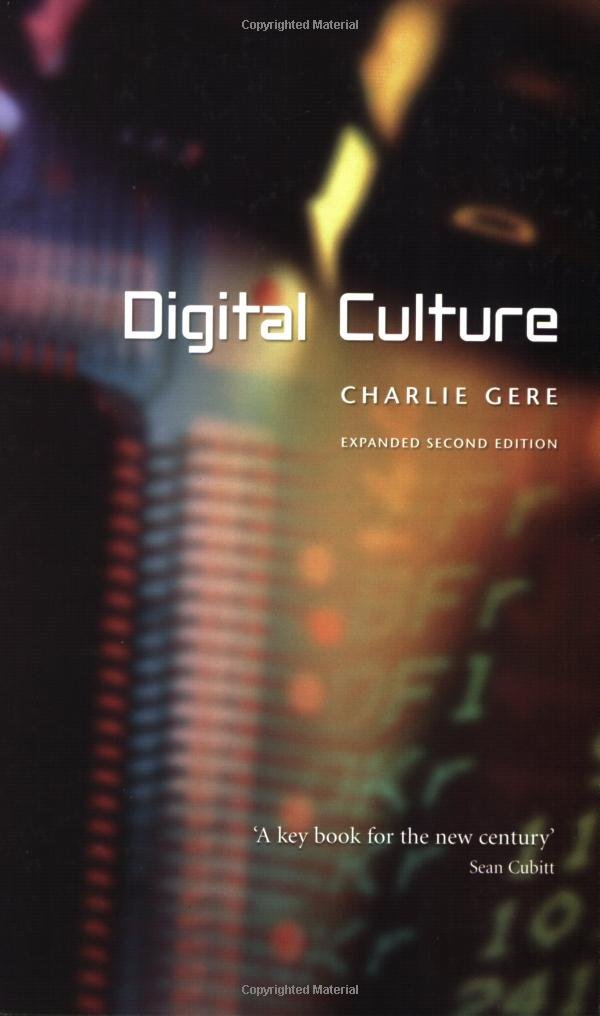
Charlie Gere: What happened after the first edition’s publication was of course, the rise of so-called Web 2:0, which was simply the greater exploitation of the reciprocal possibilities of the Web. I tried to reflect on how this reciprocity was visible beyond the Web itself and was becoming part of a more general culture of engagement and exchange, not that I share some of the more utopian visions of this phenomenon. Indeed, in my new book Community without Community in Digital Culture, I try to counter the, for me, more naive visions of community in relation to digital technology. I advocate a more ‘non-relational’ approach that does not deny the transformative effects of new media in terms of community but thinks of it more in terms of hospitality to the other.
MG: Many of the artists we have worked with are using new media to explore and critique the utopian assumptions you discuss: YOHA, IOCOSE, Liz Sterry, M.I.G (Men In Grey, Julian Oliver and Danja Vasiliev), Heath Bunting, Face to facebook (Paolo Cirio and Alessandro Ludovico), Annie Abrahams and more. Each of them work in a deeply relational way to intervene in the mythologies projected about digital technology; and, with a knowingly crtical eye of the technical limitations and the social controls at work when using networked technology. At different levels, all are producing work that ‘consciously’ incoporate relational contexts, in some way or another, this includes ideas and approaches with autonomy as part of their art, but not necessarily advocating technology as a singular, saving grace.
How do you view the role of this practice in the context of the wider corporate and state impact on the way technical cultures are evolving. How do you see the notion of hospitality working between the arts and these other more mainstream cultures?
CG: I greatly admire and like the work of the artists you mention and others doing similar things. For me they exemplify the complexity of the idea of hospitality. In general the Web is about exchange, whether that of money for goods, social links and relational exchanges in social networks, or the exchange of speech and dialogue in on-line fora. The work of these artists refuses this demand for exchange and profit within a restricted economy. Thus they are in a sense parasitical on the Web. The word ‘parasite’ comes from ‘para sitos’, meaning ‘beside the grain’, and refers to those animals that take advantage of grain stores to feed. They are the creatures to who must be offered hospitality, as a gift, without expectation of return, which means that while they are bound up with the technological systems that comprise the Web, they are not part of the restricted economy of exchange, profit, and return that is at the heart of capitalism, and to which everything else ends up being subordinated and subsumed. Thus they find an enclave away from total subsumption not outside of the market, but at its technical core.
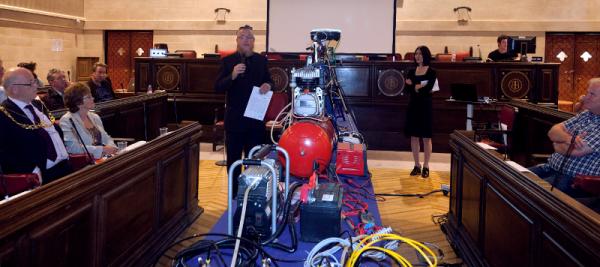

MG: Many are aware that technology and digital culture have changed the world we live in and appreciate their immediate effects on our everyday behaviours and situations. But there is a bigger story to tell, and history can offer us insightful glimpses, important clues and ways into this story about our relationship with technology and digital culture. One of the arguments outlined in your book ‘Digital Culture’ is that digital culture is neither radical, new nor technologically driven. With this in mind, which past developments do we need to acknowledge and be reminded of and why?
CG: For me the emergence of digital technology is part of a much longer story of abstraction, codification, quantification and mathematisation that can be traced back to numerous points in the history of the West, from Ancient Greece, to early Modernity to the rise of industrial capitalism. Here one might think of Heidegger’s use of ‘cybernetics’, a word we normally associate with post-war computing culture, to describe the technology and calculative enframing of modern society which he traces back to the Ancient Greeks and especially to Plato. I am not a particular advocate of digital technology, and while I appreciate its uses, I also think we must try to be aware of how it determines the way in which we think, and in which we conceive of the world. Above all we should not regard it as merely a conduit to an uncomplicated world simply out there, but rather the means by which a particular world comes to be for us. That said, this is very hard, given that in my view, and to adapt a well-known phrase from Derrida, il n’y a pas de hors-media, there’s no Archimedean point outside of our medial condition, from which we can understand it as from a god’s eye view. ‘Media determine our situation’ as Friedrich Kittler put it.
MG: In Digital Culture, you write about the composer John Cage and how he “has had the most profound influence on our digital culture”, and how his influence has opened up various different avenues of creative engagement. And, many of his ideas on interactivity and multi-media not only “have repercussions in the art world”, but also a strong influence on how computers are used as a medium. Which art movements in particular did he influence and what kind of legacy did he leave for others in relation to computers?
CG: Actually Cage’s influence on those using computers in the arts is probably less to do with what he himself did with such technology and more to do with his use of aleatory methods in many his different projects across many artforms. Also there is something about Cage’s own refusal of a normative Western subjectivity that is also consonant with aspects of our hyper-technologised existence with its emphasis on decentering the individual. Both the refusal of such subjectivity and the aleatory work together to produce a new model of the artist as conduit of contingent social forces rather than protean demi-urge or genius.
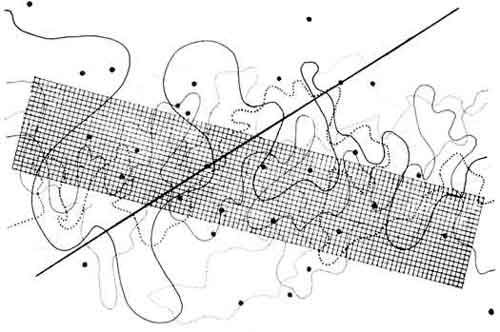
MG: Your new book ‘Community without Community in Digital Culture’, has come out at the same time as Geert Lovink’s ‘Networks Without A Cause: A critique of Social Media’. Lovink asks “How do we overcome this paradoxical era of hyped-up individualization that results precisely in the algorithmic outsourcing of the self? How do we determine significance outside of the celebrity paradigm and instead use intelligence to identify what’s at stake?” [1]
Where are your thoughts in regard to Lovink’s question, and does it relate to what you propose in terms of “hospitality to the other?”
CG: I haven’t read Geert’s book, yet at least… But I am highly sympathetic to what I take to be his position. My view is that the Web is part of a broader set of developments that apparently concern relationally, but actually emphasize the sovereign individual and autonomous subject of modernity, as well as promoting spectacular and image-bound forms of presentation and relation. The problem is that one alternative to this individualization is a kind of fascistic identification with the mass, in the form of fusion that negates the individual. A solution maybe to engage with the idea of the other in terms of difference, as both relational and separate, and yet also that which we depend on for our identity in a process of differentiation; thus the idea of hospitality as a reception of the other in difference.
MG: Community without Community in Digital Culture, is a curious title. It proposes contradictory meanings and these contradictions are clearly explained in the introduction. Although, the last sentence says “In this such technologies are part of the history of the death of God, the loss of an overarching metaphysical framework which would bind us together in some form of relation or communion. This can be understood in terms of contingency, which has the same root as contact.”
Could you unpack this last sentence for us, I’m especially interested in what contingency means to you?
CG: I owe my understanding of contingency to the work of philosopher Quentin Meillassoux, whose book After Finitude is causing a stir. Meillassoux is one of a small number of young philosophers sometimes grouped together under the name ‘speculative realism’, mostly because of their shared hostility to what they call ‘Kantian correlationism’, the idea that there can be no subject-independent knowledge of objects. Meillassoux follows the work of David Hume, who questioned the whole notion of causation; how one can demonstrate that, all things being equal, one thing will also cause another. For Hume causation is a question of inductive reasoning, in that we can posit causation on the grounds of previous experience. Meillassoux pushes the implications of Hume’s critique of causation to a point beyond Hume’s own solution, to propose the only necessity is that of contingency, and that everything could be otherwise, or what Meillassoux calls ‘hyperchaos’.
![Community without Community in Digital Culture [Hardcover]. Dr Charlie Gere. Palgrave Macmillan (2012) http://www.barnesandnoble.com/w/community-without-community-in-digital-culture-charlie-gere/1110025572 See on Amazon.](http://www.furtherfield.org/wp-content/uploads/2012/09/179510500.jpg)
I use his ideas to think through the implications of the ‘digital’. According to the Oxford English Dictionary ‘digital’ has a number of meanings, including ‘[O]f, pertaining to, using or being a digit’, meaning one of the ‘ten Arabic numerals from 0 to 9, especially when part of a number’, and also ‘designating a computer which operates on date in the form of digits or similar discrete data… Designating or pertaining to a recording in which the original signal is represented by the spacing between pulses rather than by a wave, to make it less susceptible to degradation’ (the word for data in the form of a wave being ‘analog’).
As well as referring to discrete data the dictionary also defines ‘digital’ as ‘[O]f or pertaining to a finger or fingers’ and [R]esembling a finger or the hollow impression made by one’, thus by extension the hand, grasping, touching and so on. Much of the book concerns deconstructing the ‘haptocentric’ implications of contact, and communication, especially in relation to the claims made for social networks, and to engage with what I understand as the relation between ‘contact’ and contingency’. ‘Contingency’ is derived from the Latin con + tangere, to touch. ‘Contingency’ enables us think through the implications of the term digital, by acknowledging both its relation to the hand and touch and also to the openness and blindness to the future that is a concomitant part of our digital culture after the death of God.
MG: What other subjects can we expect to read about in the publication?
CG: Touch in Aristotle and medieval theology, cave painting, mail art, Darwin and Dawkins, Luther Blissett, On Kawara, Frank Stella, Bartleby the Scrivener, Christianity – among other things… oh, and a lot of Derrida.
MG: If there is a message you’d like to send to the world, as it carries on regardless with its “permanent exposure of life, of all lives, to ‘all-out’ control […] thanks to computer technology” [2] (Virilio 2000), and it was printed on a banner, or on a billboard in the streets, what would it be?
I am reading Blanchot at the moment, so perhaps something like ‘the disaster has already happened’ (it’s suitably enigmatic to annoy people).
<———————————- The End (for now) ——————————>
Featured image: London Hackspace http://wiki.london.hackspace.org.uk/view/London_Hackspace
…the machine is always social before it is technical.
(Gilles Deleuze)
Though the term ‘lab’ conjures the image of a fairly sanitised environment optimised for scientific experiments and populated by people in white coats, media labs – centres for creative experimentation – are quite different. At their most basic, they are spaces – mostly physical but sometimes also virtual – for sharing technological resources like computers, software and even perhaps highly expensive 3D printers; offering training; and supporting the types of collaborative research that do not easily reside elsewhere. In the early-to-mid-1990s, partly propelled by the exciting possibilities of the internet and associated web browser technologies, groups began to coalesce, bent on developing access to the inherent potential of collective creativity. With the exuberant new dot.com businesses fuelling a ‘creative economy’, the Californian ‘cybercafé’ (surf the internet and slurp the coffee) was emulated in urban centres around the UK and in some cases artists were heavily involved. They saw the internet’s myriad ways of changing the way we make, think about and share art – not to mention its capacity for social empowerment – and wanted to harness these qualities quickly and effectively. With many practitioners coming from the spaces, practices and communities forged by the independent film and video movement, the phenomenon of the UK media lab was born. However, despite the importance of these spaces as the hybrid homes of the then emergent and now embedded creative activities that characterise today’s rich field of digital and media practices, their history and contribution to current lab environments has been little discussed outside a niche arena.
Early Media Labs
Two of the earliest UK media labs were Artec and Backspace (aka Bakspc), both based in London. Artec, which was established in 1990, was initially funded by Islington Council and ESF (the European Social Fund), but soon won additional support from Arts Council England. Conceived by Frank Boyd and Derek Richards, its focus from the outset was to deploy technology for social empowerment and, early on, it provided valuable professional training to the long-term unemployed. In this sense, it did not operate from within an arts context proper, but combined art and technology in the name of social integration. Creative projects were led by Graham Harwood, whose own artistic practice and his collective Mongrel were formed through associations at Artec.
Harwood and Mongrel’s practice is known widely for scrutinising social, political and cultural divisions through a framework of technology. A notable piece from this period was Rehearsal of Memory (1995), which took the collective experiences of staff and patients at Ashworth high security mental hospital, near Liverpool, and presented them as a unified and anonymous computer-based group portrait. Now available as a CD-ROM, the work strongly undermines the assumptions we make about mental health, blurring the line between those branded ‘normal’ or not. It is an excellent example of the way artists and media labs habitually combine creative activities with technology to give people a renewed agency. Around 1995, Peter Ride was brought on board to curate a stream of activity called Channel, which lead to further powerful artworks including Ubiquity (1997) by David Bickerstaff and Susan Collins’ In Conversation (1997).
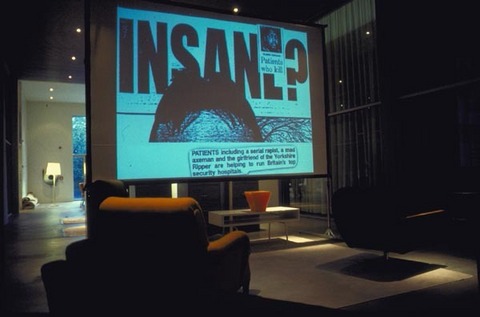
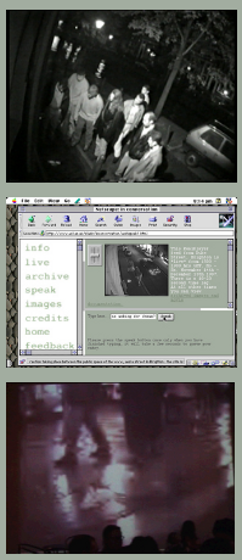
Without regular public funding, Backspace started out as an independent self-organised cybercafé. Initiated by James Stevens as a ‘soft space’ adjunct to his commercial web design business, Obsolete, it had a physical studio and lounge on Clink Street. People could drop in and use the web access and computer terminals in exchange for a nominal membership fee and commitment to maintain the space. What is notable about the Backspace model is how it attempted to foster a co-operatively managed resource. It exemplified a preoccupation amongst internet culture devotees with autonomy and new forms of governance, and struggled with all the contradictions of such ideals alongside the fact of its commercial parent entity. Obsolete shared its (at that time) capacious bandwidth. This gave people web hosting and streaming capabilities that would otherwise have been prohibitively expensive; allowed for the hosting of many artistic projects produced within the space itself; and facilitated many early streaming experiments with link-ups between other European media labs including as E-lab in Riga, Lativa and Ljudmila in Llubljana, Slovenia. Early attendees and co-facilitators of Backspace now list some central figures of the Digital and New Media art fields including: Matt Fuller, Simon Pope, Armin Medosch, Heath Bunting, Ruth Catlow, Pete Gomes, Manu Luksch and Thomson and Craighead – even Turner Prize winner Mark Lecky was a regular for a while.
Globally distributed discussion networks provided a discursive layer for these media labs, with early mailing lists such as Nettime, Rhizome and Syndicate forging international connections around technology, art and politics. Likewise, Mute (at first a newspaper, then a glossy magazine, now a web journal) provided regular critical commentary on burgeoning digital culture.
Foundationally different, Artec and Backspace were united by a belief in the importance of access to tools and training within a social context. In slightly differing ways, they put creative experimentation and social concerns at the centre of the agenda via technology. This was to become an important organisational strategy for this sector. Though both spaces have since closed, Stevens continues to build social and technological infrastructure as Deckspace, at Borough Hall, Greenwich. Without a physical space, Frank Boyd has evolved his media lab system into an industry-orientated programme called Crossover, which assembles creative professionals to workshop cross-platform ‘experiences’ from a variety of creative arenas including film TV and the computer games industry. Crossover is one of many peripatetic media lab models that privilege collaborative creative processes, although it is more goal-orientated than most as participants often pitch to a panel of industry commissioners.
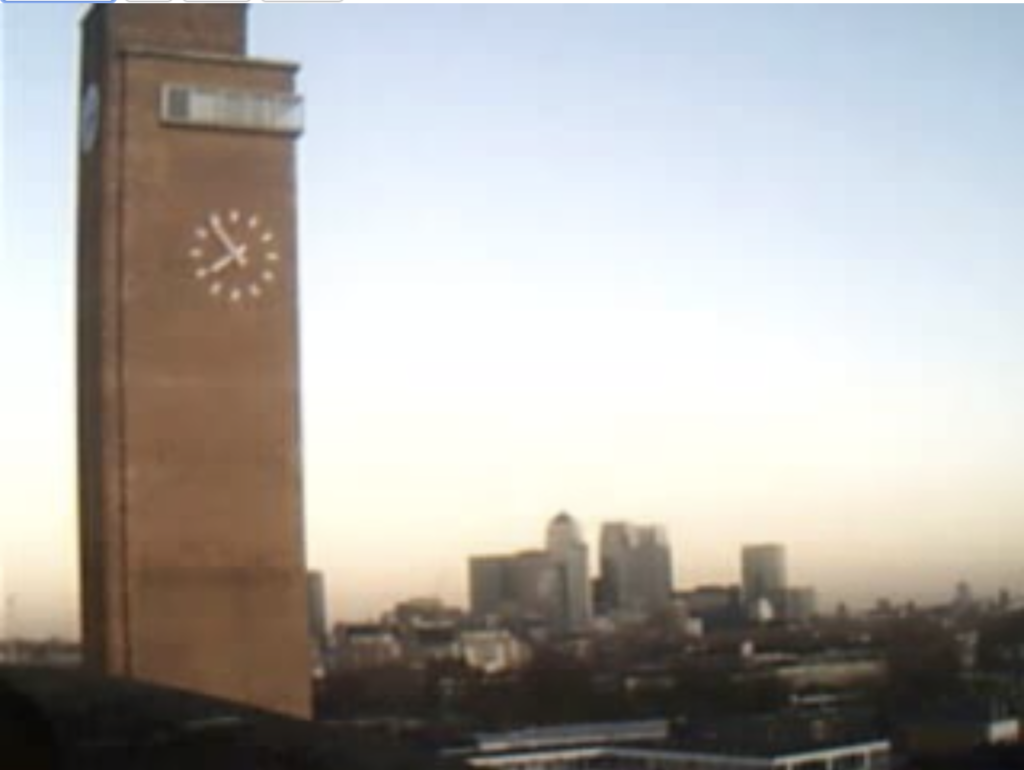
Process over Product
With less of an eye on industry and an abiding interest in the creative process itself, PVA MediaLab was formed in 1997 by artists Simon Poulter and Julie Penfold. In its first incarnation, it took up residence at Dartington College of the Arts, with funding from South West Arts. While there, artists were offered a well-equipped space in which to experiment with technology and develop ideas. In fact it is this developmental freedom that forms another core operational component of the media lab. Rather than asking artists to arrive with pre-formulated projects, or expecting them to see a piece through from start to finish, media labs have consistently placed value on self-determined exploration. PVA helps artists to manufacture methodologies rather than final artworks, fully designed products or content packages. They have also led the way in assisting other media labs to produce a similar system, through their Labculture programme. Highly itinerant, the Labculture model adjusts itself to host organisations, like Vivid, in Birmingham, so they can learn how to set and achieve goals while building the sorts of lasting partnerships that will sustain future activity.
This shared or Open Source way of working integral to media lab culture is also exemplified by GYOML (Grow Your Own Media Lab). A collaborative project between media labs Folly, Access Space and the Polytechnic, GYOML was designed to help generate more media lab initiatives. It has included: ‘GYOML in a Kitchen’, a sound recording and editing workshop by Steve Symons (Lancaster); ‘GYOML in a Van’, which staged an introductory workshop in media-lab culture for community group leaders (Lancaster); a game-centred ‘GYOML for teenagers’ (Rochdale); and ‘GYOML at the Canteen’, catering to film-makers and professional artists with an interest in open source (Barrow-in-Furness). Legacies of this project include the Digital Artists Handbook, an impressive guide to Open Source tools and techniques and ‘Grow Your Own Media Lab (the graphic novel)’, a set of inspiring case studies. Folly continue to work very much in this manner, forming essential infrastructural relationships as and where needed and guiding others through the adoption of free software.
Another example of this attention to operation and openess comes from GIST Lab, in Sheffield, which energises community-based projects through a space that hosts meetings and workshops. Even without a dedicated tech suite, their knowledge-exchange is a short-cut to all manner of original cross-over work, and they have supported yet another project that literally and metaphorically recreates aspects of the media lab model. 3D printing (or rapid prototyping) is increasingly popular in producing anything from car parts to jewellery, by layering materials like plastic into finished three-dimensional objects. RepRap, however, is able to print the spare parts it needs to be built while it is still itself under construction. Just like media labs, this self-replicating 3D Printer is all about sharing access to a successful system.
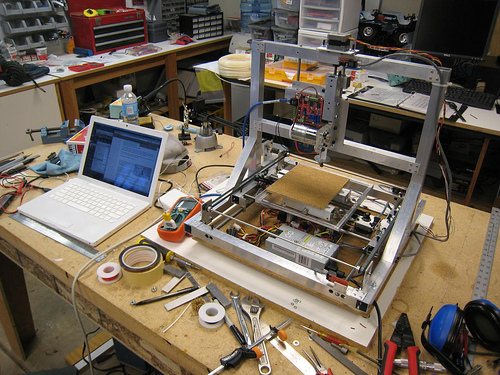
If media labs are not driven by material production, neither are they all about technology. Arising from the work of the art group, Redundant Technology Initiative, Access Space in Sheffield established its media lab through the use of free and recycled technology and learning. Given our cultural predisposition for wanting the latest, fastest equipment and our reprehensible dumping of perfectly serviceable technology, abundant hardware is sourced from all manner of locations. The latest Free and Open Source software is installed on the hardware where expensive proprietary software once lay and the media lab space, complete with this equipment, is opened to the public five days a week. The one proviso placed on this access – continuing the recycling theme – is that once a media lab participant has learnt how to do something, they should pass this knowledge on. As evidence of the success of this system Access Space boasts impressive outreach capacity: more than a thousand regular visitors, of which only about thirty-five percent are university educated, and over half are unemployed, and they habitually work with people experiencing disabilities, learning disorders, poor health, homelessness or other measures of exclusion.

One of the projects that clearly shows what they do is Zero Dollar Laptop, a collaboration with the Furtherfield organisation and community. Through a series of workshops, homeless participants are given the ability to use and maintain a free laptop complete with free software in self-led creative projects. It is this model of learning through self-directed creativity that arises again and again in media labs because it provides demonstrable results in helping people acquire and retain the skills they need. Without ‘bells and whistles’ new technology, Access Space emphasise the importance of ideas over technology and demystify all manner of computer-based skills. SPACE Studio’s MediaLab is also an excellent example of a lab working at a range of levels to offer beneficial specialised training. They teach software packages at a professional level to film makers, artists and a range of media industry workers, as well as offering film-making and media training for NEET (Not in Education, Employment or Training) teenagers in the local area. There are also a number of DIY Technology workshops including those regularly hosted by MzTEK who have expanded their operation as a result of their connections with SPACE. MzTEK are all about encouraging women to build technical skills and enter the new media sector. Growing from a small group to wide and supportive network they answer underdeveloped areas of knowledge. In addition to this, SPACE’s PERMACULTURES residency series has, to date, hosted eight residencies supporting over eleven artists, helping them explore technology and go on to show in a range of spaces.


The media lab also plugs an important gap in the art gallery and museum network. Digital and New Media arts are distinctive for collapsing boundaries between the place of production and exhibition. As a result, few existing art spaces have been in a position to fully represent it. Media labs, as well as community websites like Furtherfield and Rhizome, international festivals including ISEA and Transmediale and curatorial resources like CRUMB (the Curatorial Resource for Upstart Media Bliss) have imaginatively responded to this situation. Media labs in particular have been very successful in fostering relationships between artists and galleries. They have helped to translate not only the ideas expressed by this type of art – which can require much additional contextualisation – but also their physical installation in spaces not designed for this new breed of work.
For example, Folly recently collaborated on an experiment in the exhibition and acquisition of New Media art with the Harris Museum and Art Gallery. Entitled Current, the project saw expert panels first select works to be exhibited at the gallery (in Spring 2011) and then choose one to enter the permanent collection. Not only did this give the gallery the chance to add a timely contemporary work to their collection but it formed a useful public case study showing other institutions how they might engage with emergent art forms in various new media.
Media labs greatly contribute to the collaborative working methods the creative sector now thrives upon. Cross or interdisciplinary partnerships involve people from very different industries or working cultures combining and even reinventing the way they work in order to unearth all manner of new practices and products. Many universities, having born witness to a boom in research which straddles different academic subjects and industry sectors (due in some part to government funding imperatives around ‘knowledge transfer’), have established their own media labs. A relatively early example of this was i-DAT (the Institute of Digital Art and Technology) at the School of Computing, Communication and Electronics at the University of Plymouth. A large project with many interrelated strands is their op-sys (operating systems) network of research into architectural, biological, social and economic data and how it can be made publicly available and useful. The University of Nottingham has the Mixed Reality Lab, which was established in 1999 with £1.2 million in funding from the JREI (Joint Research and Equipment Initiative) programme as well as ongoing grants and investments. Run by Steve Benford, it hosts around eighteen PhD students providing resources for researchers and post-graduates working in areas that intersect its host department, the School of Computer Science, and associated training facility, the Horizon Doctoral Training Centre. It maintains a number of diverse projects, some of which have won prestigious awards and award nominations including Can You See Me Now, a collaboration with Blast Theory. The CoDE (Cultures of the Digital Economy) Institute at Anglia Ruskin University in Cambridge has a digital performance laboratory that focuses on sound-based work. Culture Lab is Newcastle University’s bespoke unit of media-lab-style flexibility, where artists work experimentally and across disciplines, and Sandbox, a similar resource, is located at the University of Central Lancashire. Another approach for universities is to partner with existing media labs. Pervasive Media Studio, a Bristol-located media lab, was set up by Watershed, a cross-artform production organisation, HP Labs and the South West Regional Development Agency. They have a partnership which runs for three years with the University of West England’s Digital Cultures Research Centre and work in a number of different ways including offering Graduate and New Talent residencies for those just starting out in their careers. The Pervasive Media Studio has helped to establish events like Igfest, the Interesting Games festival, held annually in Bristol, as well as development platforms such as Theatre Sandbox, which helps theatre makers introduce technology to their practice. They also support artists, including: AntiVJ, Duncan Speakman and Luke Jerram.
As we have seen, some labs have been nomadic or temporary while others have evolved into new incarnations. A media lab might be part of an array of dependencies with institutional responsibilities i.e. Folly, Isis Arts, Lighthouse, Pavilion, Pervasive Media Lab, PVA, Vivid and more, all of which regularly produce an abundance of quality experimentation in Digital art and culture. While new incarnations of the media lab may respond to three distinct but related phenomena: the rapidly evolving technology sector; the transient networks of geeks and digital experimenters; the need for sustainable models for innovation in industry. MadLab, in Manchester, provides space and facilitates meetings and workshops for ‘geeks, artists, designers, illustrators, hackers, tinkerers, innovators and idle dreamers’. Their ‘drop in’ events, commonly known as ‘Hacklabs’ (for example *Hack to the Future* during the Edinburgh International Science Festival), give people instant hands-on experience with all sorts of code and kit. Although hacking is still seen as a specialist and somewhat murky activity, the term is being increasingly decoupled from its conventional criminal associations and made accessible to mainstream arts territory. In January 2011 the Royal Opera House facilitated a ‘Culture Hack Day’, bringing cultural organisations such as the Crafts Council and UK Film Council together with software developers and creative technologists to usefully open up and share data. Other HackLabs may have less of an arts focus, but do have impressive resources built using the open membership model (pioneered by the likes of Backspace). The London Hackspace boasts a laser cutter, digital oscilloscope and kiln, all donated or collectively purchased.
Scattered through many of our city centres are office/studio-based working spaces which cater to the creative industries by offering flexible working environments and abundant networking and training opportunities. The Hub, in London’s Islington and Kings Cross areas (with up to thirty further Hubs in cities across the globe), gives fee-paying members access to facilities and a way of working orientated towards connecting people from across the network in cost-effective innovation. These spaces are indicative of the emphasis placed on the creative economy as the big hope for economic renewal driven by small entrepreneurs grabbing and shaping the opportunities in technology, entertainment and design.
Inspirational before Institutional
Looking briefly at some of the ways media labs have operated since the 1990s shows them as uniquely fertile spaces for all manner of shared expertise and creative innovation. They have made a fundamental contribution to Open Source culture. Working as openly and collaboratively as possible, participants have found ways of sharing process and product, while an interdisciplinary nature has revealed a plethora of creative possibilities. Fulfilling a difficult remit by offering a home for many of the emergent artistic practices currently transforming artistic activity, they have led us away from ‘art for art’s sake’ and towards work which has demonstrable meaning and lasting social and economic benefit. Large institutions might be extremely well-versed in mounting financially advantageous blockbuster exhibitions, but the beauty of media labs derives from their ability to develop and disseminate the socially-transformative systems that have already and will continue to shape the future of the arts.
A big thank you to everyone who contributed to this research despite their incredibly busy schedules and a special shout to: Simon Poulter for pulling over his car, Clive Gillman for kindly kicking things off, Sarah Cook for an innovative approach to note sharing and Peter Ride for not taking a lunch break.
You can find Charlotte’s original article on Collaboration and Freedom – The World of Free and Open Source Art http://p2pfoundation.net/World_of_Free_and_Open_Source_Art
As part of the Furtherfield collection commissioned by Arts Council England for Thinking Digital. 2011
This conversation follows in a series of interviews with women who work at the intersection of art and technology. Amy Alexander’s work as an artist, performer, musician, and professorapproaches art and technology from a performing arts perspective, often examining intersections of art and popular culture.
Amy Alexander is an artist and researcher working in audiovisual performance and digital media art. She has worked under a number of pseudonyms including VJ Übergeek and Cue P. Doll. Coming from a background in film and music, she learned programming and began making time and process-based art on the Internet in the mid-1990’s with the Multi-Cultural Recycler and plagiarist.org. Amy has performed and exhibited on the Internet, in clubs and on the street as well as in festivals and museums. Her work has appeared at venues ranging from the Whitney Museum and Ars Electronica to Minneapolis‚ First Avenue nightclub. She has written and lectured on software art and audiovisual performance, and she has served as a reviewer for festivals and commissions for new media art and computer music. She is an Associate Professor of Visual Arts at the University of California, San Diego. During summer/fall of 2012, Amy is Artist-in-residence at iotaCenter in Los Angeles.
Rachel Beth Egenhoefer: You’ve taken on many roles as an artist, musician, performer, coder, organizer, professor. How would you explain what you do to the “average Joe” who has not idea what a code artist is?
Amy Alexander: I usually don’t try to explain to people what a code artist is. I generally just tell them about the types of projects I or my students do, (“museum installation,” “club performance,” etc.) and what some of them are about. Then I explain that it’s done by writing software, building electronics, making videos, etc. But the point is more about the projects, not about how specifically they are made.
I also think talking about code-as-art is both less necessary and less difficult than it was five or ten years ago. What motivated me and a lot of other code artists back then was a concern that algorithms had a cultural impact that wasn’t well-recognized. Nowadays, people are familiar with the idea that Google sorts your search results in a particular way, websites you visit develop demographic profiles of you, etc. – they’re already concerned about algorithms. So I think it frees up both artists and audiences to focus on other aspects of the work. Of course, there are definitely some situations in which focusing on algorithms-as-art is important. Just like photographers sometimes focus on the nature of photographs, video artists on video, etc.
RBE: You’ve worked as yourself, as well as other performers such as Cue P. Doll and Übergeek. Can you describe the differences between some of your characters, and how do you see identity as a key element in your body of work?
AA: Some of the online characters just evolved. I tend to anthropomorphize things, and I like to break into characters; I’ve just always done those things. So in some cases when I’m developing a project from a particular perspective, a character emerges who personifies that perspective. For example, The Original Plagiarist.org (1998) website was a collection of projects in which grandiose attempts to opportunistically plagiarize from the Internet always turned out to be transparent. So the character of Plagiarist emerged as the proud proprietor of this site and creator of all its projects – and the only person who couldn’t see the futility of the plagiarisms.
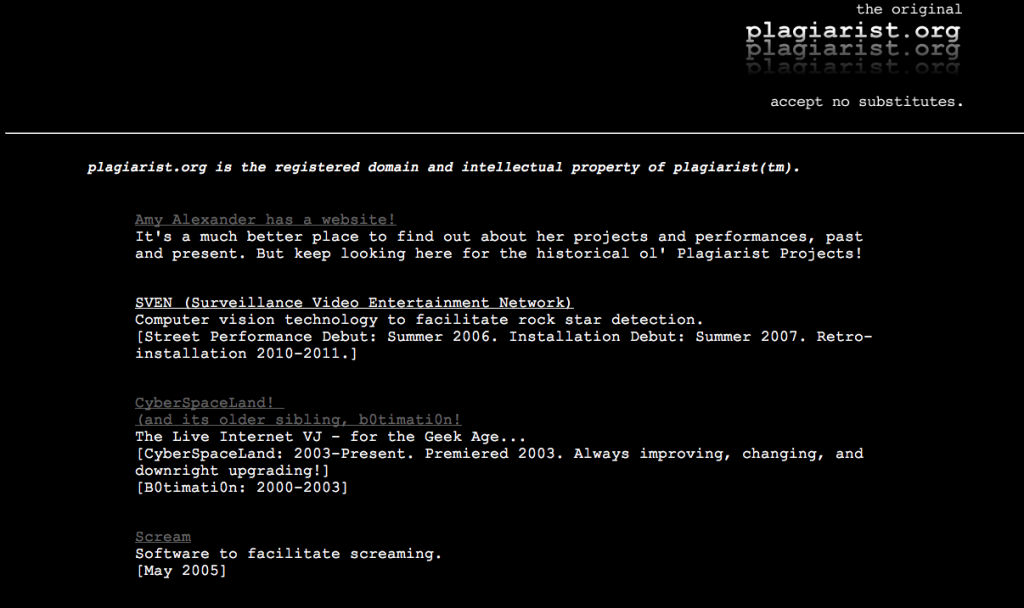
Übergeek is different, since I physically go out and perform as her. She’s both a theatrical character and actual club performer – in varying proportions depending on the context of the show. The theatrical character is a geeky rockstar wannabe. That opens up space for Übergeek to exaggeratedly escape the physical restrictions of performing on a computer – by waving around an “air mouse,” dancing on a DDR pad, etc. The club performer comes from my growing up performing music. I’d never thought about it, but the zone musicians go into to perform is really like playing a character. You have to become someone else. A few years ago I heard Steve Schick explain that when he has to perform a difficult piece of music, he imagines he’s someone else – and that other guy can play the piece. Eventually I realized that any performance of any kind I’d done that I’d been remotely satisfied with, whether music, VJ show, or performance art – I’d mentally become some other person. Going into character is really important, even if the character is just, “the performer.” It can be easy to forget the crossovers between performing arts and visual arts, but there’s a lot we can learn from one another.
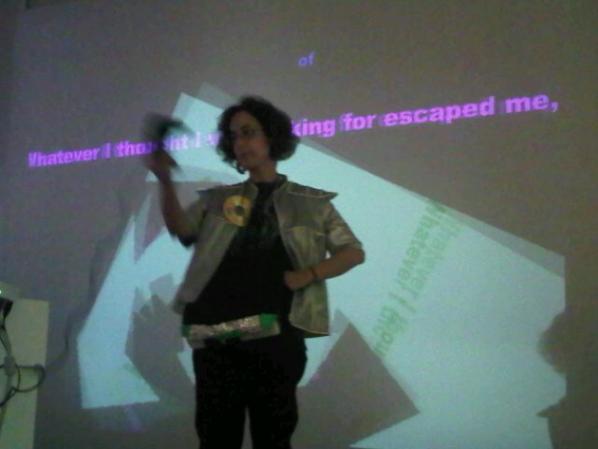
RBE: Do you think this happens to us when we interact online, that we become performers? (Some people believe for instance that Facebook is really a performance of ourselves, not our real selves) Do you see any intersections of performance in “online” vs “physical/ in person” interactions? (I realize this gets into an entirely different question, the idea of intentional performance and unintentional, but perhaps you see an overlap?)
AA: I think there’s an overlap, but there’s also an overlap between the kind of “performances” we do online and those we do in “real life.” I don’t buy the dichotomy that the physical world is real/true and the online world is fake. We perform different sides of ourselves in different real life situations – work, friends, family, large group, small group, etc. Sometimes we perform more consciously than others. On the other hand, sometimes we feel less inhibited in online interactions, so we behave more naturally.
That’s not to say there’s no difference between online and offline interactions – but then again, these differences didn’t just suddenly emerge when the Internet came along. Think back to when people sometimes had pen pals by snail mail, for example. The relationships could be friendly, intimate, or performative. When things like immediacy and nonverbal communication disappear, that invites a different kind of behavior – be it more natural, more performative, or a combination.
RBE: What connections do you see between identity, code, and performance?
AA: I guess I’ve responded to identity & performance in the question above. As for code & performance: people have pointed out that code parallels musical notation, in that both are executable languages. If you think about scores by people like John Cage, where scores could actually be diagrams or verbal instructions to the performers, the connection between performance and instruction set becomes even clearer. This is interesting historically and theoretically, but for many of us who use code in performance, the connection becomes self-evident in practice. Code launches processes and actions, and performance *is* processes and actions, and there’s a back and forth between the performer and software. It’s not that much different for me performing software than performing a musical instrument; if I play violin, I finger, bow, pluck in various ways to get various sounds. You can think of the violin as interface, the notes and gestures as parameters, or whatever. But to be honest, trying to create precise analogies is a recipe for disaster. The point is, you perform both of them, and you have to learn how to do it. The difference with software is, you build your own instrument; that’s both a blessing and a curse. So you try to balance playability with flexibility, and so on. Because of my experience playing music, I keep trying to build ones that will accommodate clumsy performers like me!
RBE: Do you see all code as being “performed”? (Or perhaps is saying code is executable the same as saying code is performed?)
AA: It depends on which sense of the word “performed” you’re using. In the sense that means to do some sort of process – like to perform your job duties – yes. You can think of data as nouns and algorithms as action verbs. You “run” code, and though the physical metaphor might be an exaggeration, in general, some sort of an action happens. So in that sense, the processor is performing the code.
But in the other sense of the word – intentional performance, performing arts, performance art, etc. – running code is innately no more of a performance than breathing. People like John Cage have made interesting performances out of breathing, and people like Alex McLean have made interesting performances out of running code. But it’s not that way on its own, except in the Cagean sense of it being performance if you think of it that way. I think that’s interesting, but I’m personally more interested in code’s cultural, rather than formal, implications. In other words, I’m not so excited that processes are dynamic and self-repeating for their own sake. I’m more interested if, for example, that means we have increasing difficulty finding unpopular or obscure information online, because the popular perspectives have formed an algorithmic echo chamber.

RBE: Your newest work is using audiovisuals, performance, solar energy, and the history of dance in cinema. How did you arrive at this combination of ideas?
AA: The project is Discotrope: The Secret Nightlife of Solar Cells. It’s an audiovisual performance – a collaboration with Annina Rüst, with algorithmic sound design by Cristyn Magnus. There’s really two parts to the project: the projection system, and the content and performances that we develop for it. The system is a disco ball where some of the mirrors have been replaced by solar cells. The cells power the motor that turns the ball. We project video onto the ball instead of colored light. The result is, reflected, fragmented video images move around the room. Since the video projections “solar”-power the ball, the speed at which the images move around the room varies with the brightness of the images.
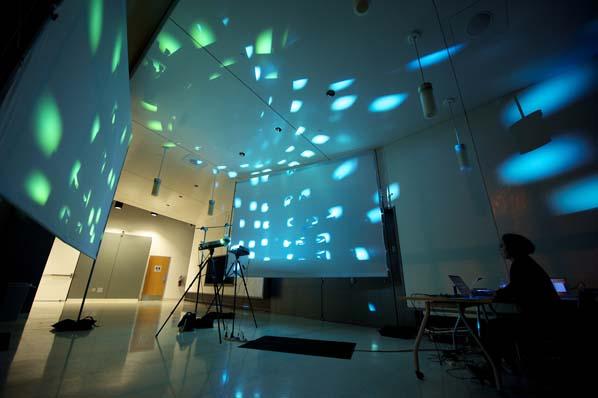
The way this all came about was I’d been interested in the philosophy behind hybrid cars and various other things – that when we “waste” energy, we might actually be creating it. I kept wondering if this idea could be applied to media somehow, and I kept trying various experiments with video: could the talking heads on cable news power an LED? etc. Never quite found the right outlet for this idea, though. At some point, Annina and I came across a disco ball, and we noticed the similarity between its mirrors and small solar cells. Then the idea of projecting videos onto it hit us, and it all came together as a “media-powered” system. Of course, that was just the general idea. After Annina built the initial prototype of ball, it took many hours working with it the studio for the “instrument” to reveal itself – i.e. how exactly does a video-powered disco ball become useful visually and performatively? Figuring that part out was just elbow grease – but getting from rough idea to what-is-this-really always is for me; I have to get my hands on things and play with them.
The content framework we’re working with for at least our initial round of performances is “the history of dancing ‘at’ cameras.” Since it’s a disco ball, we envisioned performing it at community dance parties, etc., and so people dancing seemed like the obvious thing to project. We started from the idea of projecting the people at the party onto it live – but we realized we also wanted to expand beyond that. Again, the elbow grease process: I’d try different clips of people dancing on YouTube, old movies, TV shows. Eventually a connection emerged between early cinema clips and contemporary YouTube clips. In both cases, people dance pretty much like vaudeville performers, directly for the audience – as opposed to cinematic narrative style, in which the viewer is a fly on the wall. In the dancing “at” cameras style, there’s a more direct, intimate connection between dancer and audience. We’ve written some things about this on the Discotrope blog – and I’ll probably write more there soon. Another thing we became interested in is how representation (gender, physical, etc.) does and doesn’t change from early movie camera demos and Hollywood films to YouTube, where people are generally self-cast and self-directed. And I’m really interested in the relationship between all of this and the muddy space between exhibitionism, voyeurism, and surveillance. That’s a theme that’s run through a number of my projects, and dancing at cameras certainly exemplifies that murkiness.
Of course, a lot of the dancing at cameras perspective relates to film history in general – cinema’s origins in theatre and vaudeville, the development of montage, etc. So it’s interesting to see it return with YouTube. Teresa Rizzo has written a really interesting article related to this called, YouTube: The New Cinema of Attractions.
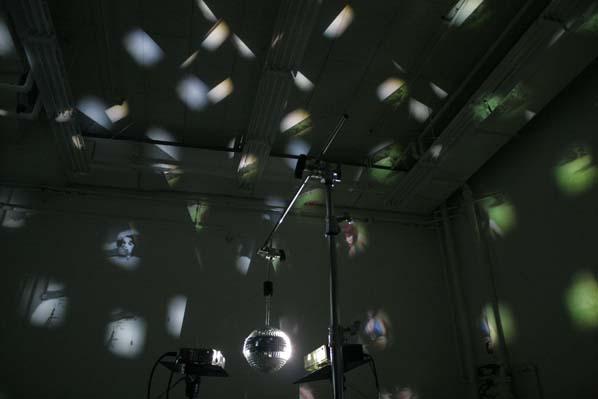
RBE: When you say “people dancing at cameras” I immediately thought of surveillance cameras. Is your disco ball a type of surveillance camera?
AA: I’m really interested in the blurring between surveillance, exhibitionism, and voyeurism. The Multi-Cultural Recycler, SVEN, and CyberSpaceLand all hit on that theme in one way or another; this time it’s cinematic dancers. The cinema/YouTube performers who appear in Discotrope all knew they were on camera, so overtly it’s more about exhibitionism and voyeurism. Glamorous 1950’s female burlesque dancers did their strip tease acts for the camera; sixty years later, not-so-glamorous scantily-clad men proudly stomped through the Single Ladies dance on YouTube. One group does work-for-hire within the Hollywood studio system; the other does what they want. Does that make one voyeurism and the other exhibitionism, or is it more complicated than that? in some cases, we see the performers much differently than they probably saw themselves. Does that make it surveillance? I think it’s all very muddy, and that’s what I find interesting.
The flip side is that there are people in some of Discotrope’s YouTube videos doing things like dancing in Walmart, which gives the video a surveillance camera look even though it’s obviously not surveillance (in the traditional sense, at least.) People turn the tables on surveillance video and make their own production numbers in surveilled/controlled areas – for fun and as a type of resistance. That’s one of my favorite parts of Discotrope. Then we get to recreate those Walmart spaces in the big Discotrope projection. It makes it even more like an old Hollywood production number, and it makes it weirdly immersive. This is fun for us, because Walmarts are not the kind of thing normal people like to recreate immersively. 🙂
RBE: For this piece you are creating something for other people to perform with. Are there any differences for you in creating work that you will perform vs. others performing?
AA: Ah, those pesky multiple senses of “performance” again!. 🙂 I do the visual performances for Discotrope, so for now I’m primarily building the software system for myself to perform. So far Annina is the only other person who performs with the software. Like anything, it’d require some tweaking to be distributed for more general use, though I’ve tried to make it not too terrible in that regard. 🙂 More challenging/interesting might be for performers to get the feel for moving the ball – like anything, it takes practice to get proficient.
But perhaps you’re talking about performers in terms of the audience who can dance to Discotrope, or the parts of the show where audience members can dance on camera interactively. In this case, they’re both performer and audience at the same time. That’s an interesting challenge, because in designing the show, we have to think about them in both ways.
RBE: You are starting a residency at the iotaCenter in Los Angeles, what will you be working on there?
AA: It’ll be mainly exploratory/preliminary research; things will likely be changing/developing as I go along. But my general plan is to explore two threads: gestural and spatial cinematic performance. In performing CyberSpaceLand over the years, I found myself unconsciously developing certain gestural/structural performance techniques that were much different than what I’d consciously designed for the piece. That spawned some ideas about gesture, time and space that I’m going to try to take further. The spatial thread grew out of some things we’ve played with in Discotrope in terms of deconstructing cinematic narrative in a 360 degree space. I’ll be exploring these spatial cinema ideas both in regards to Discotrope and as broader research.
iotaCenter’s a great place for doing research in abstract / formal and experimental cinema, visual performance history, etc. They’ve got a terrific collection of films and texts. I’m hoping to also use the opportunity to get together with other experimental cinema and visual performance folks in LA. It’d be great to organize some fun/intellectually-stimulating/breathtakingly-earthshattering screening/performance events.
RBE: This interview is going to be part of a series of interviews with women working in art and technology. What do you consider to be important today about being a woman working in art & technology? Do you think it is still useful to discuss the female voice as a separate voice in the field?
AA: It’s a tricky subject, because we both need to hear women’s voices and avoid tokenizing or homogenizing them. Women artists working with technology do tend to have different perspectives than men, and there are far fewer of us. So often when the dominant themes emerge, they tend to be the “masculine” themes by virtue of sheer numbers. A corollary is that often women artists feel pressured to focus on gender issues or certain types of social issues. Again, it’s a problem of critical mass and self-perpetuating themes. Since a fair number of women are already involved with those topics and many women’s interests overlap there, they have momentum. But this ends up discouraging women from discussing or doing work on other topics they’re interested in, So, while we need to talk about shared experiences among women in art and technology, we also need to recognize that they have a diverse range of work and perspectives.
RBE: How have you seen perceptions of gender change through the years either in teaching, performing, or working as an artist?
AA: It’s interesting to think that the first programmers were women, and that at the time it was considered clerical work. (See Researcher reveals how “Computer Geeks” replaced “Computer Girls” by Brenda Frink.)
As men started to fill programming jobs, the perception of programming shifted. It became something “technical” that was somehow inherently “man’s work,” even though it had been clerical “women’s work” only a few decades earlier. I’ve seen something similar happen as a female computing artist. I think there are more of us now – at least we don’t seem to be the novelty we were ten or fifteen years ago. And I’ve seen a shift in attitudes and perception among undergraduate computing arts students: by now both the men and women have grown up playing video games and doing a variety of Internet activities that might have seemed like “boys-with-toys” pastimes a decade ago. So their perceptions of what they’re learning to do as computer artists is a little more open and less gendered. But unfortunately, there are still circular perceptions in all age groups that whatever technical work women are doing can’t be too serious by virtue of the fact that a woman did it. It would seem to parallel the current political debate in the US about the pay gap between women and men. There are always arguments that women’s jobs aren’t as demanding, and they usually end up with someone saying, “I can’t believe we’re still talking about this in 2012!” So on one hand, the more things change, the more they stay the same. On the other hand, as more women computing artists emerge, we’ll hopefully soon achieve sufficient critical mass for world domination. Don’t say I didn’t warn you.
Featured image: “Born in 1987: The Animated GIF” from the site’s page.
Marc Garrett interviews Katrina Sluis, the new curator of the Digital Programme at The Photographers’ Gallery, London. We discuss about the gallery’s recent show Born in 1987: The Animated GIF and what kind of digital exhibitions and projects we can expect from the gallery in the Future.
An edited selection shown on the London Photographers’ Gallery’s new digital wall, during the final weeks of the show. http://thephotographersgallery.org.uk/the-wall-2
The exhibition microsite. An open conversation where anyone can join in and contribute their own GIFs. http://joyofgif.tumblr.com/
Marc garrett: You have joined The Photographers’ Gallery and as part of the new digital programme launched the exhibition “Born in 1987: The Animated GIF”. Could you tell us about this project?
Katrina Sluis: The digital programme presents projects both online and offline, which respond to recent dramatic shifts in the digital image as it becomes increasingly screen-based and networked. As part of this new programme we have launched ‘The Wall’ – a permanent exhibition space on the ground floor of the Gallery, visible both to visitors and passersby on Ramillies street. The Wall itself is a 2.7 x 3m Sharp video wall which we installed after considering a number of different technologies. We were conscious not to use digital projection as it would locate the project within traditions of cinema and video art, and we wanted the screens to respond to the reception and distribution of images within wider visual culture.
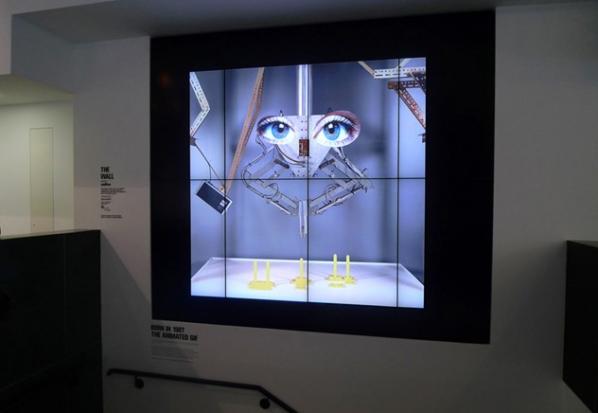
For the opening show, we decided to focus on the animated gif for a number of reasons. Firstly, the gif is a uniquely screen-based image format, in which the specific characteristics and limitations of the image file are inherent to the form, in contrast to the other kinds of images the gallery might show which might adopt digital techniques but result in traditional print-based photographic work destined for the gallery space.
I also wanted to disrupt certain expectations about the screens – the fetishisation of resolution and image quality, and what kinds of photographs The Wall’s programme might seek to address. The animated gif in this sense is very interesting – it is one of the first image file formats native to the web, and although it is 25 years old this year it has been undergoing a resurgence on platforms such as Tumblr. In a commissioned essay for the show, Daniel Rubinstein speculates that current resurgence of the gif “is not only part of the nostalgic turn towards the blurred, the unsharp and the faded but it is also a marker of a moment when the history of the network becomes the material from which the digital image draws its living energy.”[1] Frequently authorless and contextless, the gif image works on a different economy in which its value is based not on its uniqueness and scarcity (as in certain forms of art) but its circulation and proliferation. Although there have been significant practitioners of the gif form, it is a format which ultimately resists canonization. And, in the context of a photography gallery, it opens up other debates concerning medium specificity and the ‘post-photographic’.
In approaching the exhibition, I was keen to ask a diverse range of photographers, writers, organizations and other practitioners to contribute a gif for the show. In keeping with the unmonumental nature of the form, I asked contributors to respond within a short timeframe of 7 days. For many contributors, this was the first time they had made a gif; but other contributors already had large followings on Tumblr and some were established net artists. This opening show and associated Tumblr site (http://joyofgif.tumblr.com) became a starting proposition for the project in order to then open up The Wall to gif contributions from the wider public. We will continue to update The Wall with public responses on a daily basis until the final day of the show on 10th July.
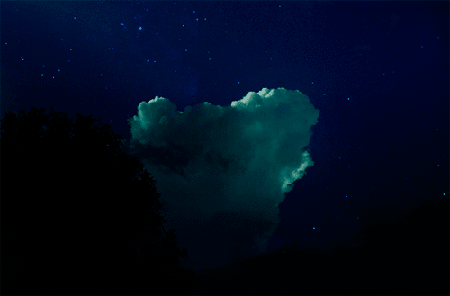
MG: At first, some may assume that the first part of the exhibition title ‘Born in 1987’, refers to the fact that today so many young people using computers these days were born in 1987. Yet, the GIF format, short for ‘Graphics Interchange Format’, was introduced to the world of computers by CompuServe in 1987. Was the title of the show deliberately playing with both notions?
KS: I like this idea! The title does self consciously play with the way in which the digital is valorised for its endless ‘newness’ and novelty but yet has this long and frequently overlooked history of creative experimentation. You can also see this reflected in the recent hype around the work of Kevin Burg and Jamie Beck who have (problematically and entrepreneurially) re-branded the gif as the ‘cinemagraph’.
MG: Do you consider this project to be net art, if so, how does it relate to other forms of net art?
KS: The project (and The Wall’s programming) does pose certain problems as it seeks to relocate certain forms of online practice(s) into the space of the art museum. At the same time, the project exists in an online context with its own very different life on Tumbr, where the work circulates in a very different context with a very different audience. I think there are many interesting opportunities which emerge from this intersection of the institutional frame of the museum (with its associated issues of cultural and curatorial authority and the legacy of aesthetic modernism) and the values and politics which inform certain kinds of networked arts practices.
But I also think the project also needs to be understood in the specific context of The Photographers’ Gallery, its history and audience. Whilst the project shares the concerns of net art by raising questions concerning authenticity, authorship and ‘the social’, it is also motivated by the need to rethink familiar notions of photography and temporality, indexicality and the economy of the image – concerns which presently haunt the field of photography theory.
![Kennard Phillipps. GIF image by Peter Kennard and Cat Phillipps. Born in 1987: The Animated GIF. The Photographers' Gallery 2012 [2]](http://www.furtherfield.org/wp-content/uploads/2012/07/fuck-the-markets-latest1.gif)
![Rad Racer glitch 3. GIF image by tracekaiser. Born in 1987: The Animated GIF. The Photographers' Gallery. 2012 [3]](http://www.furtherfield.org/wp-content/uploads/2012/07/tumblr_m5tqfl62wl1qew2moo1_400.gif)
MG: In what way do you see this form of creativity relating to others who may not be so well versed with net art culture, or digital networked practices?
KS: The Wall presents an opportunity for the Gallery to collaborate with diverse communities who can bring their distinct expertise and experiences to the programme, and the net art community has much to offer in this respect. For this reason, we aim to develop The Wall’s future programme through the framework of ‘collaborative research’, in which our audience, along with the organizations we partner with, are potential co-researchers. The co-researcher model developed as an approach to research democracy in the Social Sciences, particularly in the approach of Action Research in the NHS but in a more relevant cultural example was used extensively in the Tate Encounters: Britishness and Visual Culture research project. Co-research recognises both the collaborative and collective nature of meaning construction, through a process which attempts to trace and reveal the complex manufacture of meaning.
At the same time, there is still another related project to be done in highlighting and responding to digital projects whose life is online – this is of course something I admire Furtherfield for doing so brilliantly. On a smaller scale and with a more narrow focus, we hope to launch a blog which will draw attention to online work which relate to photography as it becomes polluted, valorized, hybridized and networked.
![GIF image by Paul Flannery. Born in 1987: The Animated GIF. The Photographers' Gallery. 2012 [4]](http://www.furtherfield.org/wp-content/uploads/2012/07/tumblr_m442xish4q1rvlji4o1_500b_0.gif)
MG: Some, may view this this exhibition as relating to Internet Folk Art. There is an interesting article by Kenneth Goldsmith[1] where he discusses the digital theorist Rick Prelinger’s claim “that archiving is the new folk art, something that is widely practiced and has unconsciously become integrated into a great many people’s lives, potentially transforming a necessity into a work of art.”
Now, this is not directly relating to the show itself, but it resonates something regarding the inclusiveness of the show. So, in respect of it ‘possibly’ possessing aspects of Folk Art, what connections do you see as relevant or not, and what does it mean to you?
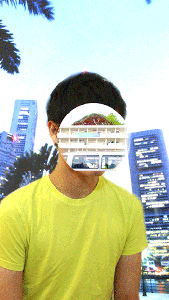
KS: By focusing on the gif the show does problematise the distinction between artist and audience, in which participation, openness and the ‘crafting’ of the image becomes key. However I have reservations about the use of the term Internet folk art, which could be construed as imposing a certain modernist logic on the discussion, burdening it with an analogue modeling of high and low culture. The research approach has been adopted precisely to avoid the trap of binary nominalism, and to problematise the tendency to shoe horn internet practices into the language of cultural studies and aesthetics.
MG: The Photographers’ Gallery was the first independent gallery in Britain devoted to photography and has been going since the 70s. It is the UK’s primary venue for photography and has been dedicated in establishing photography as an essential medium, representing its practice in culture and society. It seems that The Photographers’ Gallery is going through another transition. You have already mentioned how hybridized and networked the nature of future projects will be. So what kind of exhibitions and projects can we expect in the future?
KS: Because digital technology is not in itself a new photographic medium, but essentially a hybrid and converged set of technological practices, it raises many interesting problems, both theoretical and practical for a Gallery focused on photography. To the computer, the photograph is indistinguishable from the other binary blobs of data we used to call books, films and songs. The crisis of digitization and medium specificity now extends to the domain of the camera – Digital SLRs are coveted for their ability to shoot high quality digital video, and we turn to our mobile phones when we want to take snapshots. This is a very rich context for the programme to explore, and ideally the future projects will respond to the technical, creative and cultural languages of photography as produced by computer engineers, web developers, photographers, artists, networked communities, social scientists and other practitioners.
Our next show on The Wall (opening 13th July) features the practice based research of Susan Sloan into portraiture using motion capture and 3D animation techniques widely used in entertainment, medicine and the military. Her motion studies refer to the traditions and conventions of portraiture and the changing role of the camera as a recording device. At the same time, her work raises questions concerning the convergence of painting, animation, film and photography in the digital realm.
The future digital programme which will occupy different spaces and address various photographic practices including augmented reality, social media, electronic publishing, interactive media, mobile computing and synthetic imaging.
The Joy of GIF – the London Photographers’ Gallery’s new digital wall. Article by Wendy McMurdo.
http://www.foam.org/foam-blog/2012/may/photographers-gallery
The insights of American anarchist ecologist Murray Bookchin, into environmental crisis, hinge on a social conception of ecology that problematises the role of domination in culture. His ideas become increasingly relevant to those working with digital technologies in the post-industrial information age, as big business daily develops new tools and techniques to exploit our sociality across high-speed networks (digital and physical). According to Bookchin our fragile ecological state is bound up with a social pathology. Hierarchical systems and class relationships so thoroughly permeate contemporary human society that the idea of dominating the environment (in order to extract natural resources or to minimise disruption to our daily schedules of work and leisure) seems perfectly natural in spite of the catastrophic consequences for future life on earth (Bookchin 1991). Strategies for economic, technical and social innovation that fixate on establishing ever more efficient and productive systems of control and growth, deployed by fewer, more centralised agents have been shown conclusively to be both unjust and environmentally unsustainable (Jackson 2009). Humanity needs new strategies for social and material renewal and to develop more diverse and lively ecologies of ideas, occupations and values.
In critical media art culture, where artistic and technical cultures intersect, alternative perspectives are emerging in the context of the collapsing natural environment and financial markets; alternatives to those produced (on the one hand) by established ‘high’ art-world markets and institutions and (on the other) the network of ubiquitous user owned devices and corporate social media. The dominating effects of centralised systems are disturbed by more distributed, collaborative forms of creativity. Artists play within and across contemporary networks (digital, social and physical) disrupting business as usual and embedded habits and attitudes of techno-consumerism. Contemporary cultural infrastructures (institutional and technical), their systems and protocols are taken as the materials and context for artistic and social production in the form of critical play, investigation and manipulation.
This essay presents We Won’t Fly for Art, a media art project initiated by artists Marc Garrett and I in April 2009 in which we used online social networks to activate the rhetoric of Gustav Metzger’s earlier protest work Reduce Art Flights (from 2007) in order to reduce art-world-generated carbon emissions... Download full text (pdf- 88Kb) >
Published in PAYING ATTENTION: Towards a Critique of the Attention Economy
Special Issue of CULTURE MACHINE VOL 13 2012 by Patrick Crogan and Samuel Kinsley.
Anonymous, untitled, dimensions variable is the title of a show by 0100101110101101.ORG (Eva and Franco Mattes) at Carroll/Fletcher gallery in London from 13th April to 18th May 2012. Or at least it was. The title changes each day based on submissions to a blog (http://exhibitiontitlechange.tumblr.com/). The new titles have been printed out and displayed on the wall to the left as you walk in to the gallery.
You don’t expect this kind of playful intersection of the virtual and the real in a gallery off of Oxford Street, across from Soho, opposite other new galleries. Carroll/Fletcher’s glass-fronted welcomingly brutalist interior says “serious contemporary art space”. Inhabiting such a space presents a challenge to net and digital art that must be met with careful presentation and considered curation.
Through the glass front of the gallery, and as you enter, you see a sculpture or assemblage of a (stuffed) cat trapped in a birdcage by a (stuffed) canary (Catt, 2010). The cat has suffered Epic Fail as the Internet would say, and did in the meme image that the sculpture is based on. It’s a comic and unnerving object even without the extra layers of reference provided by the original meme and the knowledge that it was originally presented as a fake Maurizo Cattelan sculpture. It is art with its roots in the net that can stand on its own without that context. Its companion piece, Rot, 2011, is a fake Dieter Roth sculpture consisting of detritus in a glass jar on a plinth against the far wall. 0100101110101101.ORG briefly inserted it into the Wikipedia page on Roth, and the fact that its materials were all ordered via the Internet drives home just how commonplace this has become.
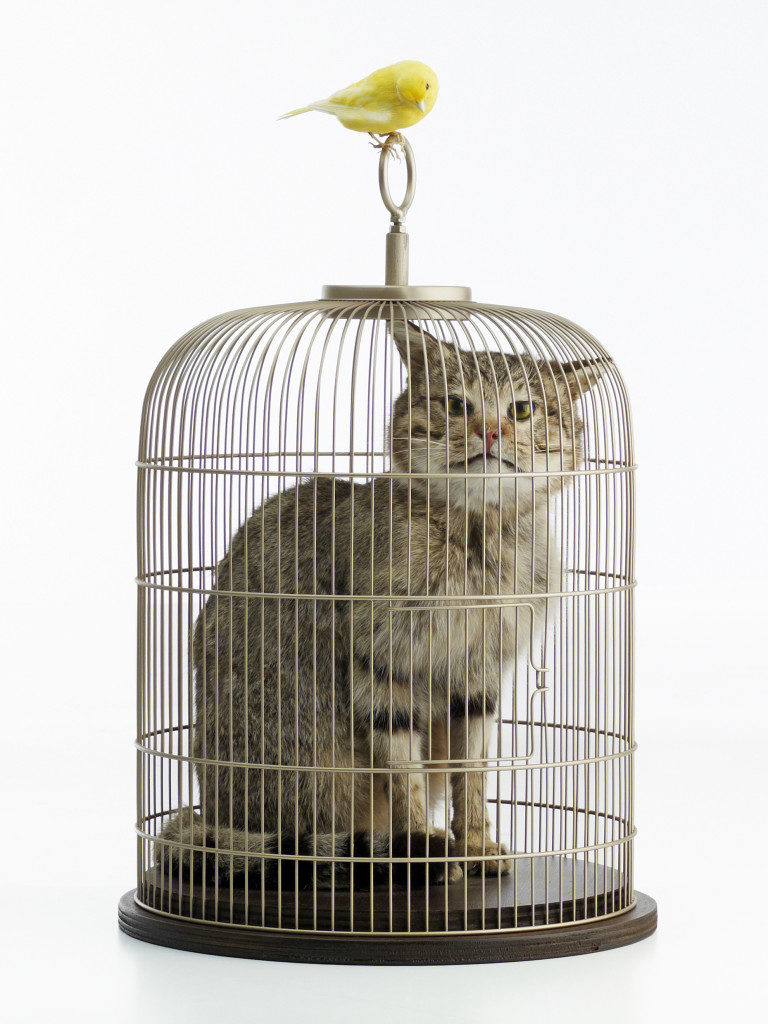
Both are given the room they need to work as objects in a gallery. Neither originates in itself as net art, more in 0100101110101101.ORG’s history of tricksterism and transgression. These are concerns that are easily linked to net culture, possibly too easily on the part of the reviewer, but it is telling that they are the works that the show opens with. They physically establish the playful appropriation and hyperreality that is the basis of much of 0100101110101101.ORG’s work.
Pride of place in the first room of the gallery goes to the projection The Others, 2011, 10,000 digital photographs (supposedly) copied without authorization from the folders of computers used by people on a peer-to-peer filesharing network that 0100101110101101.ORG used to distribute their own work. These are private images, projected at an angle and slightly across the corner. Configure your peer-to-peer filesharing client wrongly and it shares all the files in the folder you share. Including the images of you naked, drunk, lonely, partying, or whatever else you wouldn’t post anywhere a future employer might find them.
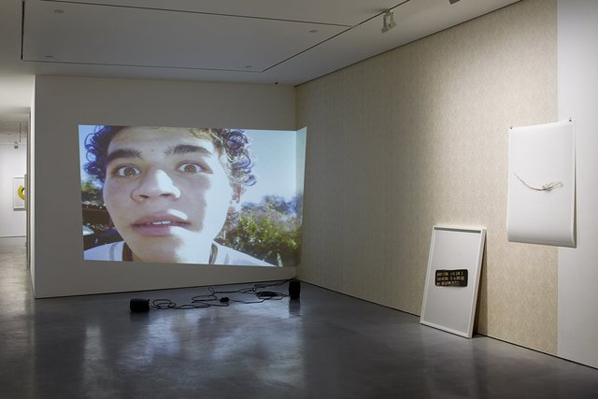
In the next, smaller, room is Colorless, odorless and tasteless, 2011. It is an old-fashioned car racing video arcade game retro-fitted with a petrol engine that starts up when you insert a coin and revs as you press the pedal to accelerate the virtual car on the screen, filling the (sealed…) room with carbon monoxide. Combining the virtual made physical of Catt and the moral impact of The Others, it is the most immediately dangerous artwork I’ve ever had to review.
Moving into the larger room at the back of the ground floor of the gallery, the video No Fun, 2010, is the most shocking piece in the show. Franco Mattes pretending to hang hineself on the random Internet webcam video chat switchboard Chatroulette is one thing, but the reactions of other Chatroulette users as they connect and see him apparently hanging there is quite another. Some laugh, some jeer, only one I watched displayed any lasting concern. This is the moral and aesthetic flipside of The Others.
Reenactments, 2007, is my aesthetic and technical favourite piece in the show. Videos of canonical performance art pieces being re-enacted by Eva and Franco’s Second Life avatars are displayed on CRT monitors arranged at floor level surrounded by the cables and adapters used to play back the video from SD cards. It’s much easier for an avatar to remain still as a “Singing Sculpture” than it is for a human being, making it even stranger, and Marina Abramovic’s “Imponderabilia” works much better with impossibly buff avatars than with mere naked human models stood in a doorway. It exquisitely foregrounds the social mediation of Second Life and its players self-presentation. A large cartoon wolf squeezes through between the naked avatars, their polygons intersecting. A vampire attempts to fly over them but hits the bounds of the architecture. The crowd in the background chat and bide their time. The virtual intensifies the real, out-doing and critiquing its appropriated source material.

Stolen Pieces, (1995, made public 2010) claims to move beyond fakery and unauthorized copying to physical appropriation. Stolen physical fragments of canonical postmodern artworks (Duchamp, Warhol, Koons, Rauschenberg) are displayed like forensic evidence, protected in small plexiglass containers, accompanied by large photographs of them and by documentary evidence of their theft. There’s no statute of limitation on theft in the UK, and damaging artworks shouldn’t be applauded. But it’s a daring performance and a concrete critique of the fetishism that lies at the heart of the art market and the institutions that help drive its value.
Following the brutalist concrete staircase to the basement reveals My Generation, 2010, a smashed but still working early-2000s PC lying on the floor. On its monitor, that appears to have fallen on its side, show video clips of computer game players giving in to and venting their frustration at the games they play. This isn’t the kind of image of yourself you want as your lasting monument on the Internet. Gathered together, like the images in The Others and the videos in No Fun, they again form a summation of an aspect of society and our visual environment that could not be achieved with such immediacy by other means. And the clear space and architectural solidity of the gallery again help to put a different emphasis on the material than if it was encountered on the web.
The wall-filling video projection of Freedom, 2011, records Eva’s attempts to plead with the players of networked First Person Shooter computer games not to kill her character. Touch-typing might have helped, but even when Eva manages to type long enough to explain that she’s an artist, or to ask people not to shoot, the social and game logic of the virtual world mean that her character is executed again and again, the screen shifting to third person as her avatar moves out of her control in death. Like No Fun, there is a core of callousness to these Internet interactions, and like My Generation they are unexpectedly preserved and presented for contemplation.
The final piece in the show is the documentary Let them believe, 2010, a video record of 0100101110101101.ORG’s Tarkovsky-haunted journey into Chernobyl’s “Exclusion Zone” in order to recover part of a fairground ride to turn into Plan C, 2010. Bringing part of the ride to life in a place where people can enjoy it is an effective and resonant symbolic resolution of the kind that art more than any other mode of human endeavor can provide.
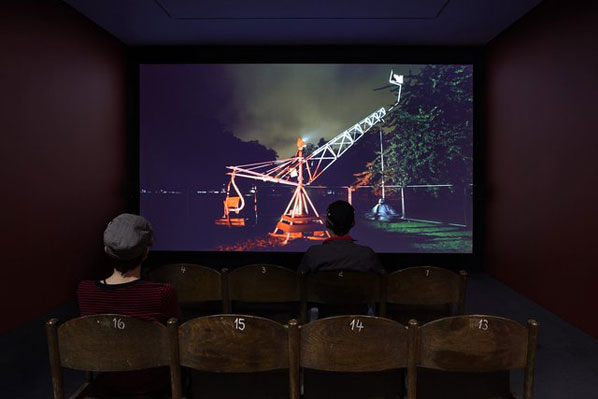
0100101110101101.ORG’s work presented physically has more than enough presence to fill the gallery and benefits from the space and the considered curation afforded it here. Some of the work is more physical than virtual and vice versa, sometimes the ethics of the work place 0100101110101101.ORG as the villain sometimes as the victim, and sometimes the work is performance whereas other times it is assemblage. I mention this to point out both the strong themes to the work and how individual the effect of each piece is.
Net art in the gallery might seem a category error, like museum postal art. Or it might seem a commodity, like auctions of land art documentation. But net art is transitioning from being the contact language of artworld emigrants learning the net’s protocols to the contact language of net emigrants learning artworld protocols. 0100101110101101.ORG have made art of these encounters from the start, and have always been as at home in the gallery as on the net.
The text of this review is licenced under the Creative Commons BY-SA 3.0 Licence.
Sign up: ale[at]furtherfield.org
To accompany Invisible Forces, Furtherfield invites all gallery visitors to take part in a programme of public play, games, making and discussion led by alert and energetic artists, techies, makers and thinkers: Class Wargames, The Hexists, Dave Miller, Olga P Massanet and Thomas Aston.
Saturday 23 June 2012 – 1-5pm
Summer Board Games and Picnic with Class Wargames and Kimathi Donkor
Saturday 30 June 2012 – 1-5pm
Summer Board Games and Picnic with Class Wargames
Wednesday 04 July 2012 – 9-11am
3 Keys – The River Oracle – The Hexists
as part of Moving Forest by AKA The Castle
Wednesday 11 July 2012 – 11-5pm
Technologies of Attunement – Olga P Massanet and Thomas Cade Aston
Saturday 21 July 2012 – 2-5pm
Dave Miller’s Finsbury Park Radiation Walk
Featured image: Ein Identity-Workshop mit dem britischen Künstler Heath Bunting. Vertiefung Mediale Künste, Sihlquai 131, 8005 Zürich. Dienstag,
Whether Bunting is climbing trees, skateboarding, canoeing or working with technology he approaches it all with the same critical attention. He hacks around systems, physical or digital. Right from when he built his first computer at the age of 14, his life has been an experimental research project. His practice consists of a dry sense of humour and an edgy, minimal-raw aesthetic, mixed with a hyper-awareness of his own artistic persona and agency in the world, whilst engaging with complex political systems, institutions and social contexts.
Even though the subjects he explores are likely to be the most topical or important issues of the day, it always includes playfulness and an element of the prankster in his work. His work regularly highlights issues around infringements on privacy or restriction of individual freedom, as well as contexts concerning the mutation of identity, our values and corporate ownership of our cultural/national ‘ID’s’, as well as our DNA and investigations into Bio-technologies. In an age where we are submersed in frameworks and protocols designed by a neo-liberal elite for a generic consumer class, Bunting’s work is well placed as observation and practical research into the ‘depths’ of legal and illegal territories in our contemporary, networked cultures.
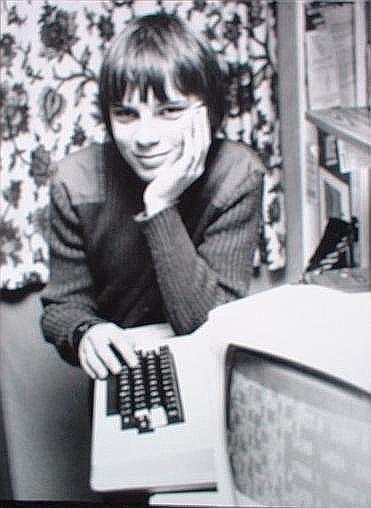
“our identity is constructed as human beings that can possess one or more natural persons and control one or more artificial persons. The higher up in the class system the better the access to status variety.”(Bunting)
The Status Project, is a study of the construction of our ‘official identities’ and creates what Bunting describes as “…an expert system for identity mutation”. His research explores how information the public supplies in their interaction with organisations and institutions is logged. The project draws on his direct encounters with specific database collection processes and the information he was obliged to supply as a public citizen to access specific services; this includes data collected from the Internet and information found on governmental databases. This data is then used to map and illustrate how we behave, relate, choose things, travel and move around in social spaces. The project surveys individuals locally, nationally and internationally, producing maps of “influence and personal portraits for both comprehension and social mobility”.
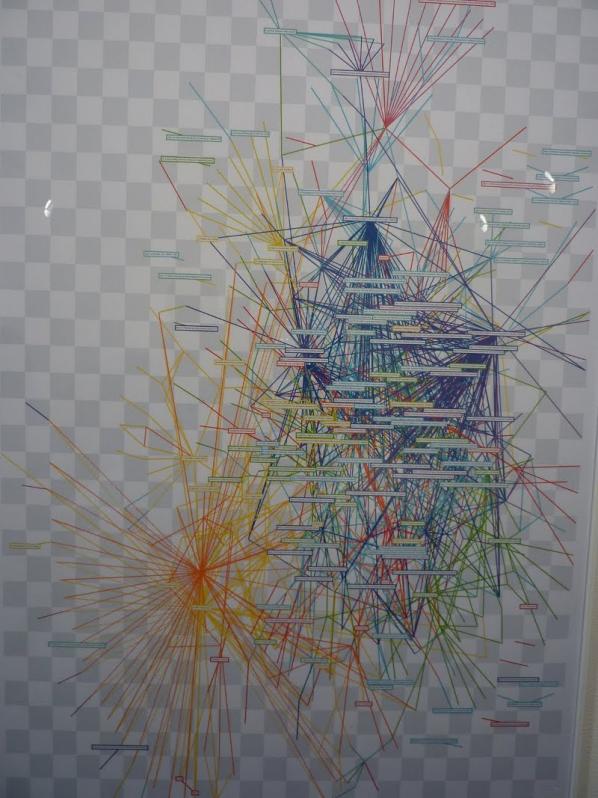
The use of data in contemporary life has made individuals an accessible resource for commercial and political interests. We are a rich source of data-mining material. Data mining is a process that potentially commodifies our interactions. Its historical roots lie with the development of artificial intelligence (AI) and 20th Century statistical analysis. These two methods of formulating data have grown ever closer together, backed by corporations and government-initiated military funding. Social networks such as platforms like Facebook and Internet networked institutions such as Google and the US military are all obsessed with our behaviours online. A good example is the NSA’s recent rebirth in turning most of its surveillance apparatus to spy on the US and its citizens. They have built a supercomputer tracing through billions of people’s emails, phone calls, and online activities in other countries outside of the US. The UK government is currently going through the political process of trying to implement similar spying protocols and systems to watch what UK citizens are up to.[2]
“Google suffers from data obesity and is indifferent to calls for careful preservation. It would be naive to demand cultural awareness. The prime objective of this cynical enterprise is to monitor user behaviour in order to sell traffic data and profiles to interested third parties.” [3] (Lovink)
Bunting is a Hacktivist Artist, acting (playing) out the role of a spy collecting and observing data content. Hacktivist Artists work with technology to explore how to develop their critical and imaginative practice in ways beyond the frameworks of the art establishment and its traditions. The established art arena is gradually catching up with this kind of artwork. However, one could be forgiven for thinking that many art critics and galleries are still caught in the 20th Century.
Two other artists also working on people’s data are Julian Oliver and Danja Vasiliev. They have collaborated on exploring alternative identities as the mysterious group, Men in Grey.[4] They detect online users’ vulnerabilities by tapping into and intervening in wireless network traffic – observing, tracing and copying user online activities. It is then redisplayed online on their website for others to view or transferred onto a visual screen on the side of a briefcase as an intervention in cybercafes for all to view. Although, no one knows other than themselves if the data is hacked and then redisplayed on these briefcases, as proposed in their video featuring one of their interventions. One thing is for sure – they have touched upon issues concerning our fears about personal data being seen by other people who we’d prefer were not viewing it.
The Status Project also taps into questions concerning technology, hierarchy and power. We are entwined in a complex game where the sacrifice of our information is part of connecting with others across digital networks. This raises the issue of our ‘human’ status being aligned ‘to and as’ objects of measurement. Through travel ports, our vehicles, passports, ID cards, library cards, mobile phones, alongside information about our health. We have mutated into networked (information-carrying) beings. Bunting’s own position on this matter is that “Technology is becoming more advanced and the administration of this technology is becoming more sophisticated, and soon, every car in the street will be considered and treated as persons, with human rights. This is not a conspiracy to enslave human beings, and it is a result of having to develop usable administration systems for complex relationships. Slaves were not liberated because their owners felt sorry for them; slaves were given more rights as a way to manage them more productively in a more technologically advanced society.”[5]

In the UK, in 2006 a research document called ‘A Report on the Surveillance Society For the Information Commissioner’ was published. Produced by a group of academics called the Surveillance Studies Network. This report was presented to the 28th International Data Protection and Privacy Commissioners’ Conference in London, hosted by the Information Commissioner’s Office. The publication begins by saying “Conventionally, to speak of surveillance society is to invoke something sinister, smacking of dictators and totalitarianism […] the surveillance society is better thought of as the outcome of modern organizational practices, businesses, government and the military than as a covert conspiracy. Surveillance may be viewed as progress towards efficient administration, in Max Weber’s view, a benefit for the development of Western capitalism and the modern nation-state.”[6]
We are not only under surveillance by entities we do not trust, we are also tracing each other online. Recently, in a show called ‘Being Social'[7] at Furtherfield’s new gallery, artist Liz Sterry showed her installation piece, ‘Kay’s Blog’. Sterry had “collated not only one form of online social engagements but all she could find about a Canadian blogger called Kay. Using everything from photographs to things Kay has mentioned in videos, blogs and posts on social networks, Sterry has recreated Kay’s bedroom in the gallery.”[8] (Scott)

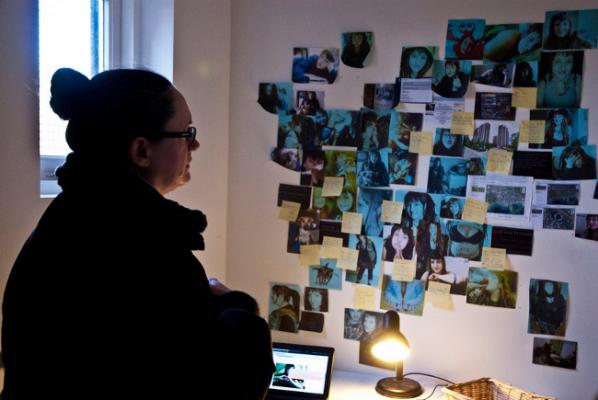
“”There were times when I felt quite creepy,” says Liz, 28, as she shows me lists of Kay’s Facebook friends and a Google Streetview of her apartment block while a playlist of her favourite songs plays in the background.”[9]
Yet, as this ever-creeping surveillance culture grows and attaches its all seeing eyes onto us all. Whether we are referring to domestic interactions, organizational or deliberate, this is not the main issue. Neo-liberalism has developed so much now, we are all part of the Netopticon. English philosopher and social theorist Jeremy Bentham in the late Eighteenth Century designed the Panopticon. It allowed officers in institutions, particularly in prisons, to observe (-opticon) all (pan-) inmates without them knowing whether or not they are being watched. In the end it was not built, but the French philosopher Michel Foucault in his publication Discipline and Punish: The Birth of the Prison,[10] in 1975 said that we are not only monitored in prisons, but in all hierarchical structures like the army, schools, hospitals and factories. This process has evolved through history to resemble Bentham’s Panopticon. The up-dated version of Panopticon, can now be thought of as the Netopticon – where individuals are complicit in feeding their own forms of collective co-surveillance, as well as being traced by corporations, governments and spammers.

“What your data body says about you is more real than what you say about yourself. The data body is the body by which you are judged in society, and the body which dictates your status in the world. What we are witnessing at this point in time is the triumph of representation over being. The electronic file has conquered self-aware consciousness.” [11] (Critical Art Ensemble)
So far, for the project he has created a functioning, sketch database of the UK system with over 10,000 entries – made over 50 maps of sub-sections of the system to aid sense of place and potential for social mobility. Bunting says he is also researching how to convert his identity generating software into a bot recognised under UK law as a person “covered by the human rights act i.e. right to life and liberty; freedom of expression; peaceful enjoyment of property. I am very close to achieving this.”
This bring us to another part of the project what I call ‘Identity Kits’, and Bunting calls ‘Synthetic off-the-shelf (OTS) British natural person’.[12] These kits consist of various items, personal business cards, library cards, a national railcard, t-mobile top-up card, national lottery card and much more. They take a few months to compile each of them because they are actual items that everybody uses in their everyday lives, involving evidence of identity. There is also a charge for the package of 500.00 GBP, which is cheap for a new identity.
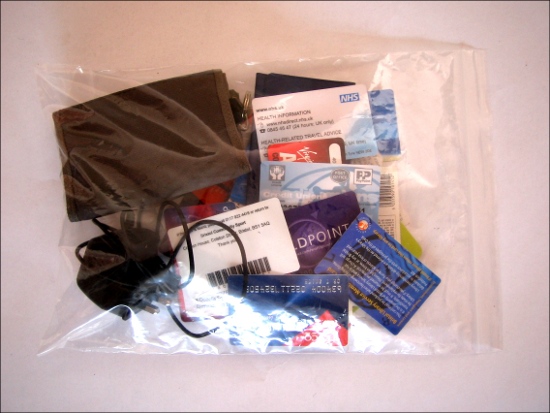
Bunting stresses that these UK identities are lawful and that there is no need for any official consulting or permission from an authority to use or make them. Through this he intends to illustrate a precise codification of class in the UK system. Currently, he defines three classes of identitiy: human being, person and corporate. What class of individual you are places you into categories of evaluation, this process allows others to judge your status, worth and value, within a hierarchy, which is clearly represented in the status maps.
This work touches on issues around our everyday status as a critique, but also as an investigative hack, and plays around with the quagmire of inequality currently in the UK. Inequality is built, constructed into the fabric our societies as an accepted default, through tradition, social or mechanistic, holding in place societal divisions. If there was a status project made in other countries reflecting their own status, worth and value of citizens there would be clear links defining where the connections and divisions lie, between each culture. In fact, another project worth mentioning here is ‘The Spirit Level: Why More Equal Societies Almost Always Do Better’. [13] The authors Richard Wilkinson and Kate Pickett have done their own ‘extensive’, detailed research in highlighting through many different graphs, mapping out inequality around ther globe.
“We know there is something wrong, and this book goes a long way towards explaining what and why.” [14] (Hanley)
Bunting’s work expresses a discipline conscious of agency, autonomy and enactments for self and collective empowerment. Hacking different routes around what at first is seen as too big to deal with, lessens its power and awe. Like Burbank in the ‘The Truman Show’, what we have been told is not real. Bunting knows this instinctively, and is on a quest to upturn each stone to see what lies beneath. But at the same time these facilities created to crack the social, and data orientated codes, are shared. He then leaves the paths he has discovered wide open for others pass through, as we all struggle to survive the ever creeping strangle-hold, of the Netopticon.
———————————————————————-
This article was written for and will be published as part of Heath Bunting’s presentation in Athens ‘Workshop How to Build a New Legal Identity’, May 5th 2012.
During the workshop, Heath Bunting will introduce us to techniques and strategies on how to form new identities. The distribution of the workshop How to Build a New Legal Identity across Europe aims at exploring the characteristics of identity in each country.
Artist’s Talk: May 4, 2012 @ 19.00
Workshop How to Build a New Legal Identity: May 5, 2012 @ 12.00
Frown Tails, 6 Paramythias str, Keramikos, Athens
Organised by: Katerina Gkoutziouli and Frown Tails
Featured image: Environmental Risk Assessment Rover – ERAR – AT (2008) Mobile, Solar Powered, Networked Installation Off the Grid, Neuberger Mus
Refusing to regard technology merely as a tool, Ecoarttech expand the uses of mobile technology and digital networks revealing them to be fundamental components of the way we experience our environment. Their most recent work Indeterminate Hikes + (IH +) is a phone app that maps a series of trails through the city. IH + can be accessed globally, or wherever users have access to Google Maps on their mobile phones. After identifying the users’ location, IH + generates a route along random “Scenic Vistas” within urban spaces. Users are directed to perform a series of tasks along the trail and provide feedback in the form of snapshots generating an ongoing, open-ended dialogue.
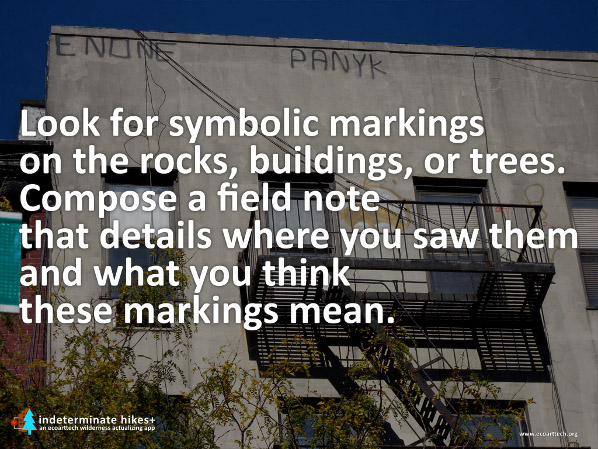
But the experience of their work is primarily an encounter with technology. Since 2005, Leila Nadir and Cary Peppermint of Ecoarttech have been engaged in an artistic exploration of environmental sustainability and convergent media. By drawing our attention to the increasing replacement or mediation of physical experiences by technology, Ecoarttech challenge the widely reproduced distinction between nature and culture. They present their work in the form of videos, digital networks, blogs, performance and installations. Their early video-based work (Wilderness Trouble and Frontier Mythology) plays out a performative and ironic encounter with the natural environment as a historically constructed concept. In the summer of 2005 Ecoarttech made A Series of Practical Performances in the Wilderness (2005) a database networked performance in QuickTime (DVD and Podcast). The short clips document what Ecoarttech ironically describe as “the experiences of two New Yorkers embarking on their first four months in the woods“. Their objectives were nothing short of
…establishing a functional home without running water, electricity, or maintained roads; developing relationships with locals; un-learning the romanticization of nature while re-learning humanity’s dependence on the environment for survival; and researching the details of the history of the land and the surrounding area.
Sophia Kosmaoglou: The confrontation with the concept of “wilderness” appears to motivate much of your work to date. How did A Series of Practical Performances in the Wilderness begin and how did you fare?
Leila Nadir and Cary Peppermint: About eight years ago, we were very fortunate to acquire a primitive cabin on 50 acres of wild, wooded land, and the experiences we had there changed us completely. Each time we drove from NYC to our “camp” as the locals called it, we were immobilized for about 3-4 days, hardly able to move our bodies as our nervous systems screeched to a halt, adjusting to the quiet. We found a freedom in the woods that we couldn’t find the city – the freedom to take up space, to play, to be quiet, slow, and still. We were also amazed by how some people in the country could seemingly live more independently from bloated global economic systems, growing their own food, chopping their own fuel, harvesting solar energy. They interacted directly with the natural environment whereas we had spent our entire lives ecologically infantilized by overdependence on the industrial grid. We began spending several months at a time at our cabin in the woods: A Series of Practical Performances in the Wilderness is a document of our environmental adventures at that time. It was our first attempt at making art in remote, wilderness spaces. It was a sort of performance of ecological/cultural collision.
SK: How did this experience inform your subsequent work?
LN & CP: As we began to study environmental theory, we realized that not only does little “true” wilderness actually exist, the myth of wilderness was used to obscure the history of indigenous people living on the North American continent. Our own land, we learned, had once been a pasture and had been logged numerous times. Coming to terms with the fact that we hadn’t really retreating to “nature” was the focus of our video Wilderness Trouble which attempts to imagine a new kind of environmental ethics that includes urban and electronic spaces and modern networked culture. However, we still believe that wilderness provides a lot of imaginative potential. Amazement at sublime landscapes can provoke an emotional response that can be politically motivating, and we have tried to take advantage of that potential in our smartphone app Indeterminate Hikes +. By importing the rhetoric of wilderness into everyday life through Google-mapped hiking trails, the app attempts to inspire a sense of ecological wonder at usually disregarded spaces, such as city sidewalks, alleyways, and apartment buildings. We wanted to see what would happen if a walk down a sidewalk were treated as a wilderness excursion. What if we consider the water dripping off an air-conditioner with the same attention that we give a spectacular waterfall in the wilderness?
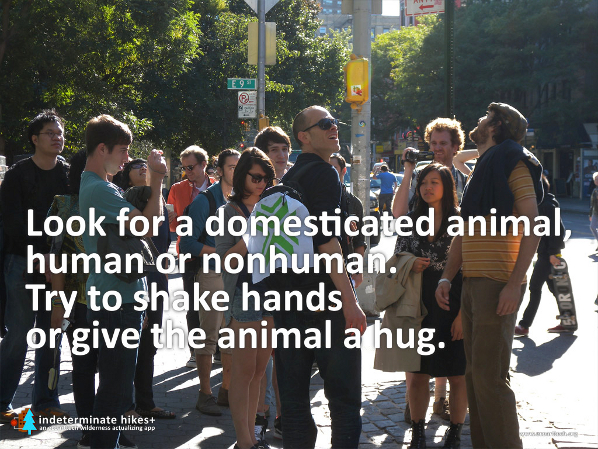
SK: There is a recurring effort in your work to question the opposition between environment and technology, which is usually accompanied by an ironic undercurrent in your narration and editing that acknowledges what you call “cultural collision”. In Google is a National Park and Nature is a Search Engine which is also part of a series of performances called Center for Wildness in the Everyday (2010), itself conceived as an ecosystem, you suggest that an “environment” is a network of relationships common to natural as well as technological systems, whether it is the ecosystem of a river estuary or Google. Do you see this as a sustainable analogy or a productive contradiction?
LN & CP: Part of what we find frustrating about a lot of environmental thought is that it either wholly rejects technology as the cause of ecological crises so our only solution is to go primitive or wholly embraces technological progress as a saviour, which often means we have to trust in corporate and scientific innovation to lead the way. We think there is another way. We see humans as essentially technical beings: human-animals literally cannot survive without technics. The U.S. military survival guide comes right out and admits that your situation is pretty hopeless if you are stranded in the wilderness without at least a knife. If technology is part of who we are – and we find Bernard Stiegler’s work helpful for thinking this through – then we have also evolved with technology. We are not the same sorts of humans as, for example, Leila’s great-grandmothers in Slovakia or Afghanistan a century ago. The question, then, is not, Yes or No to Technology, but rather, How do we engage technology sustainably and in a way that supports creativity and freedom? And if human beings are technical beings, relying on nature and culture simultaneously, is it even possible to distinguish between what’s natural and what’s not? Isn’t our sustenance dependent upon not only our biological needs (clean air, water and food) but also our cultural practices, beliefs, and imagination? This is why we find it essential to think about electronic spaces and digital technologies whenever we think about the “environment.”
The installation called Google is a National Park and Nature is a Search Engine, a work that is part of a series of performances called Center for Wildness in the Everyday commissioned by the University of North Texas. Our task for this commission was to create a networked artwork about the Trinity River Basin, the source of water for the Dallas/Fort Worth metroplex. In the image, the Trinity River looks like a space of natural refuge but the scientists we worked with there explained that the River’s flow is guaranteed only by the recycling of waste water at treatment plants. We wanted to create a work that juxtaposed this hidden constructedness of “nature” with the more obvious man-made Google – two processes or entities that we rely on everyday for our ecological sustenance: water management and online information.
SK: In 2008, you made the Environmental Risk Assessment Rover, a solar-powered module, which gathers and projects information regarding threats in the immediate environment. Although the ERAR is a sizeable aggregate of equipment that is carted around in a wagon, it seems to be the precursor to handy mobile phone apps. How does the ERAR work?
LN & CP: This project is part of our ongoing engagement with science – especially environmental science, which is also a focus of our 2009 work Eclipse. When you work at the crossroads of art and science, as we do, there is often an assumption that the role of the arts in this interdisciplinary exchange is to visualize or communicate knowledge produced by scientists. In contrast, ERAR asks what we learn when science breaks down – or when we use science to “interrupt” experience rather than to predict behaviours. The project arose out of our observations of the U.S. Department of Homeland Security’s handy yet arguably useless colour-coded terror alert system launched post 9/11 and our experiences with what risk theorist Ulrich Beck calls “science’s monopoly on truth”. Somewhere Beck writes that cows can turn blue next to a chemical plant, but unless science actually proves that the chemicals are the cause of the blue, nothing will be done about the situation. So although other forms of knowing might tell us that the plant is a public health risk, there is nothing we can do until Science “proves” a direct causal relationship. The Rover collects real-time risk data relative to its GPS coordinates, such as car or subway accidents, air pollution levels, violent crimes, proximity of superfund sites, and ground water toxicity, and then determines the aggregate local threat level through a 14-tiered alert system, ranging from “Holiday Shopping” and “Plastic Bags” to “Girls Gone Wild” and “Ask Your Doctor”. Obviously there is a bit of Dada in this work – but not Dada as simple chaos, as it is popularly invoked, but rather Dada as a shocking exposure of the limits of modern reason at the same time as it brings to the surface something that many of us have repressed from consciousness: the subliminal knowledge that there are ways of knowing the world that come from non-scientific experiences and observations. This tension between scientific expertise and everyday experience is also at play in our recent work #TrainingYRHuman.
SK: Have you considered launching it as a phone app?
LN & CP: The ERAR was our first truly mobile work, and it would probably make an interesting phone app – however, the public spectacle it creates is integral to the effectiveness of the work. Pulling around a wagon of technological parts that beams alerts onto the side of buildings is an art action and an effective conversation starter.
SK: Social networks and mobile phone app technology have rapidly become established means of communication and art galleries currently employ these technologies conventionally to replace audio guides. Your current work explores social networks and phone apps as potentially innovative platforms for art. Indeterminate Hikes + (2012) and #TrainingYRHuman (2011) can be accessed in diverse contexts and within everyday activities. They address a broad public, providing a plurality of entry points without necessarily being identified as art. How has the public responded to these projects so far and how do you hope to see them pan out in the long-term?
LN & CP: What motivates us most about working with new technologies is how they can be misused for unexpected purposes. Smartphones, generally, are deployed as devices of rapid communication and consumerism, to get you what you want and where you want as quickly as possible. Our app Indeterminate Hikes + reappropriates this mobile technology for a very different end, turning smartphones into tools of environmental imagination and meditative wonder. It transforms ubiquitous computing into an opportunity to notice the happenings occurring all around us in our local environments, to see sublimity in our backyards, alleyways, streets and neighbourhoods. Like many of our works, this is also a way to aesthetically pose an alternative to environmentalism’s frequent anti-media stance and to popular culture’s uncritical embrace of technology. We want to dream new ways of being without falling into prescribed behaviours or reactionary responses, whether with the food we eat, the technologies we interact with, or the environmental relations we imagine. Foucault’s call for the creation of “gay style” as an antidote to heteronormative culture has always resonated with us in our attempts to rethink dominant ways of being: what is the space of freedom in which one can intervene and express oneself, invent, upend? The mood after our public indeterminate hikes is often euphoric, and participant-hikers comment that they see the world anew. If enabled to be, smartphones can be a platform for chance operations, which, as Allen Kaprow explained, can create “near-miracles”: “when something goes ‘wrong,’ something far more ‘right,’ more revelatory, has many times emerged”. Our app can be used anywhere, any time, by anyone who has an Android phone or who attends our performances, so hopefully there will be many people misusing their smartphones and taking wilderness hikes in the wrong places for a long time. An iPhone version will be released this spring/summer 2012.

#TrainingYRHuman, a work-in-progress, is a participatory Twitter-based net artwork about the agency of animals who live with human-animals as well as an attempt to speak back to science’s monopoly on truth. In recent years, a burst of scientific research has illuminated animals’ behaviours, ethical attitudes, modes of cognition, and psychological awareness, yet usually when we read news of this work, we think: Were all those scientific tests really necessary to figure out that a certain animal species has feelings? Many people who work and live closely with animals already had abundant anecdotal evidence to support the fact that nonhuman animals have diverse personalities and creative problem-solving skills, that they think, feel, and are conscious. #TrainingYRHuman is a gesture toward bringing those anecdotes into the public record, toward creating a sort of oral history database of animal-agency stories that usually only circulate subliminally in our informal conversations. At the same time, it is a moment for human-Tweeters to imagine what it’s like to be a nonhuman animal, inventing unique ways to express oneself and meet one’s needs and desires in a human-dominated world.
SK: There are multiple registers and modes of address in your work and an ambiguity regarding the speaking subject. To an extent, this is because there are two of you, but you also construct voices and use various techniques to create further ambiguity around your agency. Can you elaborate on your strategies of collaboration and decision-making and how these relate to the tension and displacement that you create between the cultural and the technological, the physical and the digital, the artistic and the scientific, the collective and the individual?
LN & CP: Our primary collaborators are each other. Though we have a division of labour, we don’t have a conscious strategy of how we work conceptually, perhaps because we fell into making art together organically, out of collaborating on life. Ideas emerge for us out of an ongoing, sometimes unconscious, sometimes over-analytical, conversation that meanders through the digital/physical places we inhabit, whether we are in our studio or the kitchen. Whose idea it was to add orange juice to our hummus recipe or who came up with facilitating alter-wilderness hikes via smartphones is impossible to figure out. We are committed to an experimentality in process that involves interaction, exchange, exposure, and research that can take advantage of the energy created by blurring the lines between self and other. Proprietary works and the myth of the “genius” artist are detrimental to emerging modes of working, especially with regard to new media art production. Lately, animals have been a significant part of this process for us, shaking up our stale human behaviours and assumptions, especially the cows, sheep, and pigs we visited recently at the Farm Sanctuary in Watkins Glen, NYState, and the birds of prey we met through a local bird sanctuary called Friends with Feathers.
We can’t really say with authority whether our extended collaboration relates to the ambiguities of our artworks. However, we do try to welcome the breakdown of categories like digital, physical, human, nature, and animal as well as media, disciplinary, and environmental boundaries. What really is a “human”, and why has there been this historical obsession with somehow distinguishing humans from animals, as if we are somehow specially different from every other animate being on earth, more evolved and complex? As eco-critic Timothy Morton said recently, “According to evolution science, there are two things humans do very well, but they are a bit of an ego blow: throwing and sweating. Everything else is also done by nonhumans, including consciousness, feelings, art, tool use”. So we are simply sweaty throwers who think very highly of ourselves! It seems to us that the effort to hold tight to definitions, to reliable knowledge, or to the self blocks the more interesting conflations that happen (or are already happening) when we let categories slip away. Therefore, rather than try to determine, define, and predict in our art, we are more interested in staging fluid experiences that ask difficult questions and interrupt our sense of certainty. When assumptions fail, things fall apart, and we can’t depend on what we think we know, that is when our most creative thinking takes place. These are exciting, experimental moments.
Leila Nadir and Cary Peppermint founded Ecoarttech in 2005. They teach Video Art and Sustainability Studies at the University of Rochester in New York and they work with a range of institutions, including the Whitney Museum, Turbulence.org and the University of North Texas. They have exhibited at MIT Media Lab, Smackmellon Gallery, European Media Art Festival, Exit Art Gallery and the Neuberger Museum of Art. In June 2012, they will be artists in residence at Joya: Arte+Ecología, an off-the-grid residency program based at Cortijada Los Gázquez in Parque Natural Sierra Maria-Los Velez in Eastern Andalucía.
It’s a bizarre thing when you stumble upon the “new art movement” filtering through discursive chatter. Is it actually a movement, or is it simply a bunch of like-minded individuals telling me its a movement?
Behold The New Aesthetic then – a new art meme in visual culture whimsically constructed by James Bridle, which manifests itself in a Tumblr blog, a presentation for Web Directions South, Sydney and an original blog post. Recent attention to it has reached feverish proportions coming off the back of a SXSW panel in March and a generally positive endorsement by Bruce Sterling in Wired, plus some group responses on the creators project. More recently, the computational media scholar and philosopher Ian Bogost has posted his own thoughts for The Atlantic.
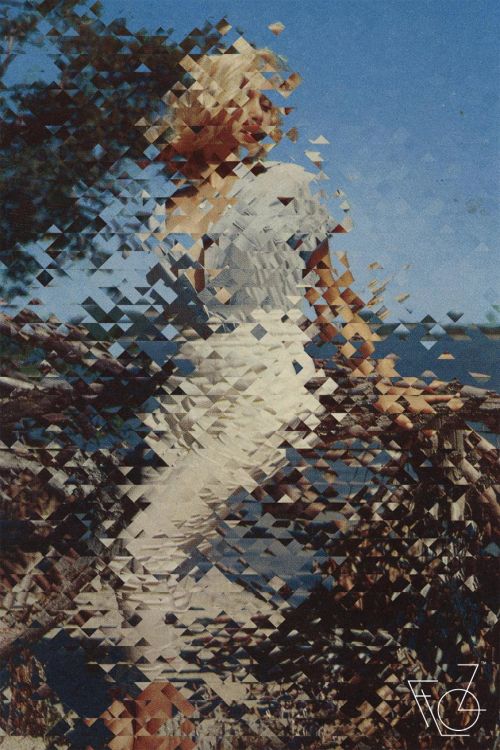
As a meme should do, “the New Aesthetic” has fulfilled its role – it has a lot of people talking about it. Like any meme which dices visual culture with some sort of research element, it has artists, writers, even media and aesthetic scholars measuring their own opinions on it in rank order without anyone knowing exactly where it’s going, what it really is or who exactly is doing it. In our noisy and crowded “I can’t believe I got 50+ retweets” over-networked epoch, this is quite an achievement even if you don’t take it that seriously.
But here’s the question: can the new aesthetic be more than a meme? More to the point, does it want to be? Is it capable of a direction? Can it be serious?
That said (and as Bridle avers) this isn’t really a prominent “movement” of ideas as such. Neither does it present material which it would deem ‘arty’. Instead, it’s an extremely broad and oblique orientation which seeks to document the subtle (and sometimes explicit) changes within our information saturated existence. It simply contextualises the contingent manifestations of computational activity, and how they are reversing and revising computational and human activities back in on themselves. Bridle’s tumblr simply presents the new aesthetic for what it is, much akin to perusing through pictures in a Facebook profile, a Reddit top ten list or clicking on Stumbleupon – simple snapshots of “stuff” which echo a blurring between the world of networks, machines and everything outside of it (with a particular emphasis on where it goes a bit wrong, hence a certain infatuation with glitchyness). Quoting Bridle’s Tumblr page;

“It is a series of artefacts of the heterogeneous network, which recognises differences, the gaps in our overlapping but distant realities.”
In another video presentation ‘We fell in love in a coded space‘ at Lift12, Bridle terms this ‘network realism’ – instances where the amalgamation of computational networked activity blurs with non-computational activity, to such an extent that it reduces any observer to nothing but a curious, passive node, gleefully whittling through instances of vaguely creative stuff. For Bridle, this occurs not just in industry but also architecture, finance, storage, fashion and now an attempt at aesthetic understanding. It’s an infatuation with the alterity of bots, algorithms, pixels and realised fictions. In this presentation however, Bridle is largely concerned with how one can respond or understand the ‘desires’ of bots, unaware that anthropomorphising the situation may not reap the rewards required. In this interpretation the new aesthetic is charged with the task of asking how we can think and orient ourselves computationally, whether it be designers, thinkers, writers, scholars or artists.
Sterling himself, mostly issues praise with a pinch of amusing impatience, as if the New Aesthetic movement should progress faster than it actually is doing, with more ideas and more focus. Kyle Chayka states that artists are already embracing it as a ‘contextual seedbed, rather than a label’. Jonathan Minard understands it as a new method of reflection concerning cultural tool-making, where the ‘dumb tools’ of machinic interface scream images back at us.

Digital Humanities scholar David Berry has blogged a similar view echoing that the new aesthetic is tapping into what he calls ‘Computationality’, a historical paradigm frame-making of sorts, which constructs specific meaning-making practices. Visualisation revolves around processes and patterns and so the list making exercise of Bridles’s Tumblr blog would seem apt in this regard, as it issues unparalleled amounts of pattern making not just as content, but as form. The archive is a jamboree of other pattern recognising events; security face recognition, retro 8bit encapsulation, satellite visuals and generally messing about with an Xbox 360 Kinect. James George mentions something similar but suggests that the new aesthetic should question the critical distance between artistic activity and technological use. It resembles a massive screen dump from a digital artist’s delicious account. Quoting Bridle again in an interview with The Design Observer Group;
“The New Aesthetic is not criticism, but an exploration; not a plea for change, rather a series of reference points to the change that is occurring. An attempt to understand not only the ways in which technology shapes the things we make, but the way we see and understand them.”
To most of the established readers here, it’s easy to criticise the “newness” of the New Aesthetic, in the same way the 90’s trope “New Media” has been quickly bundled away as if it never existed (Marius Watz makes this point). For those of you who have been studying such issues concerning hacking, play, enumeration, collecting, remixing, glitch-ing, (see Rosa Menkman in particular) in the broader realm of the computational arts, there really isn’t anything novel to gawk at: this is more of a rearrange or a rebadge. Indeed, internet discussion has been rife with such criticism, from the triteness of using Tumblr as the ‘official site’, to quick dismissals concerning the New Aesthetic’s distinct lack of any historically serious ‘substantial practice’ – not that it wanted it in the first place (Indeed it’s a pity that it has contingently replaced an identical term for a movement unrelated to Bridle’s own, coined by arts writer Michael Paraskos and realist artist Clive Head. Moreover, depending on how one looks at it, Paraskos and Head’s own movement has similar views espoused by Bridle’s version, including perhaps a direct opposition to conceptualism and foregrounding art as a material practice).
If Bridle were not so sincere about the whole affair, one would be mistaken that this was a too-cool-for-school strategy straight out of a Nathan Barley episode. But thats an easy misread. As Bogost states, Bridle is just curious about the weirdness of the network we all rely on and revel in. But there is a point where fascination with creativity turns into ADHD. The New Aesthetics tumblr site, already does just that, without any hint of standing still. “What’s going to come next? What can we do next? What are the limitations? What happens if I click that? What is that doing there?”
However both Bogost and Greg Borenstein issue a different view about the new aesthetic. They both discuss it in relation to a recent trend in philosophy called Object Oriented Ontology (OOO), a movement to which I am extremely sympathetic to. Bogost explains OOO succinctly enough;
“If ontology is the philosophical study of existence, then object-oriented ontology puts things at the center of being. We humans are elements, but not the sole elements of philosophical interest. OOO contends that nothing has special status, but that everything exists equally–plumbers, cotton, bonobos, DVD players, and sandstone, for example. OOO steers a path between scientific naturalism and social relativism, drawing attention to things at all scales and pondering their nature and relations with one another as much as ourselves.”
The link to OOO is fairly self-evident. If one of the most prominent aspects of the new aesthetic is an obsession with how a machine “sees” the world, OOO is a commitment to the seeing of things in widest possible sense. But while Borenstein generally aligns OOO to the new aesthetic with exuberant equivalence, Bogost’s view is one of general optimism, but not broad acceptance. For a start, the new aesthetics is based on a continual divide and repair between two opposing realms; the physical and the digital, each coming together and breaking apart endlessly, like throwing a box of magnets.
One of the main stipulations of being an OOO advocate is the realist eruption of what counts as a thing, and how that thing contingently relates to different types of entities. This is why Bogost decenters computation in the new aesthetic, and emphasises the multitude of things that escape the physical/digital divide. Their adventures are always-already strewn across the ontological landscape. One of the other main stipulations involves us lacking secure knowledge in fully understanding discrete units on their own terms – we can never experience their being in the same way we experience our being.
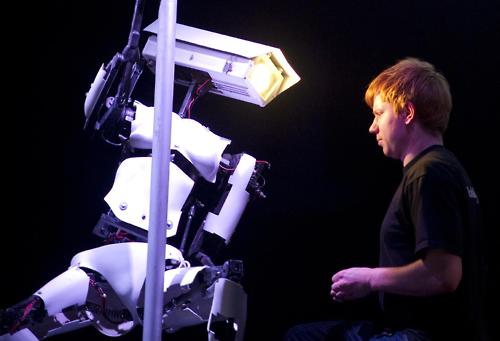
If one has read Bogost’s latest publication, Alien Phenomenology (and if you haven’t, I’d urge you to do so immediately), one would understand Bogost’s view that the new aesthetics misses out not just speculating on the hidden lives of objects other than computers and humans, but it also hovers on the inescapable problem of anthropomorphising machines and objects to within an inch of their lives. The alien aesthetics challenge is provocative.
“[T]his Alien Aesthetics would not try to satisfy our human drive for art and design, but to fashion design fictions that speculate about the aesthetic judgments of objects. If computers write manifestos, if Sun Chips make art for Doritos, if bamboo mocks the bad taste of other grasses–what do these things look like? Or for that matter, when toaster pastries convene conferences or write essays about aesthetics, what do they say, and how do they say it?”
There is an interesting discussion to be had in OOO about the usefulness of anthropomorphising the infinitesimal non-human relationships between the properties of things. Whilst others (including Bogost) see it as an inevitable factor of being one finite human entity amongst a crowd of other finite entities, I see it as a hinderance.
In particular, I’m interested in the way the new aesthetic never manages to access computation ‘just’ as it is. It only takes computation seriously when it functions as a qualitatively intelligent system, which meets or surpasses rational intelligence, or, it directly flips into “dumb tools” of (mis)communicative manipulation for the whims of human mental acts.
But I digress. Last year Bridle released a book called “Where the F**k Was I?”, which accurately sums up the mentality of the movement. The really interesting element of the new aesthetic is that it presents genuinely interesting stuff, but Bridle’s delivery strategy is set to ‘gushing disorientation’. At present, it’s the victim of the compulsive insular network it feeds off from. It presents little engagement with the works themselves instead favouring bombardment and distraction. Under these terms, aesthetics only leads to a banal drudgery, where everything melts together into a depthless disco. Any depth to the works themselves are forgotten.
Memes require instant satisfaction. Art requires depth.
The Glitch Moment(um)
Rosa Menkman
Institute Of Network Cultures, 2011
ISBN 9789081602167
Rosa Menkman’s book “The Glitch Moment(um)” is a comprehensive study of the theory, practice and social context of contemporary digital Glitch Art. Glitch Art is similar to the ironisation of the noise of old media into cultural signals seen in Trip Hop and that is the basis for the nostalgic image-making of Lomography or Instagram. But it is based on current digital technology, rather than past analogue technology.
Glitch Art is growing in popularity and critical attention, and is already being recuperated by the mass media (for example in a recent Calvin Klein perfume television advertisement). Analogue glitches have been part of art and popular culture for decades, for example in Nam June Paik’s television-based art or the titular character of the cyberpunk TV show “Max Headroom”. Digital glitches and their simulation featured in the postmodern graphic design of the early 1990s created by groups such as Designers’ Republic. But between a history of analogue media and a future of mass media recuperation there is the current Moment(um) of digital glitch aesthetics that Menkman identifies.
Menkman begins by explaining the basics of Shannon/Weaver information theory as the basis for a theory of what glitches are. In information theory, messages are sent as a signal from a transmitter to a receiver over a channel which is disrupted by a source of noise. This “noise” is the crackle on analogue telephones or on vinyl records, the static on analogue TV and radio, and the corruption that sometimes affects digital images or audio streams (nowadays notably Skype chats).
Where kinds of noise are associated with a particular we can recognise them as particular “noise artifacts”. We can also recognise compression artefacts in digital media such as those seen in over-compressed lossy image and video files (JPEG and MPEG artefacts). These noise and compression artifacts are experienced by the users of communication media as glitches. Menkman describes these phenomena in detail, providing the reader with a firm foundation in the sources and expression of Glitch phenomena.
How artists can deliberately create these phenomena is the subject of the next section of the book. Titled “A Vernacular Of File formats” it is a condensed adaptation of Menkman’s 2010 artwork of the same name. It is a thorough and accessible resource for both understanding the production of and creating visual glitch aesthetics. Each picture demonstrates a technique for modifying the data of an image file format so that a computer can still parse and render the file but it will appear corrupted to a human viewer. Starting with an uncorrupted (but unnervingly contrasty) “RAW” image, Menkman explains the production and principles of corrupted digital images in sufficient detail that the reader can recreate and build on these techniques themself, or use this knowledge as the basis for understanding and appreciating the work involved in the Glitch Art produced by others.
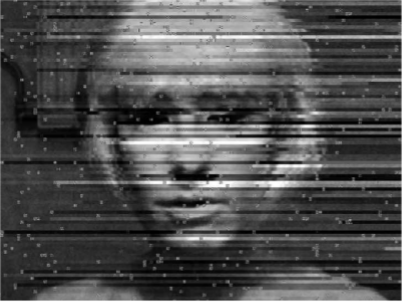
The next two chapters cover the phenomenology and philosophy of Glitch. The theories of Paul Virilio and Alan Liu are usefully deployed here to give Glitch a philosophical grounding. But there is also a recognition that Glitch is an inherently open concept that is difficult to define. Menkman rightly considers the work of Beflix (Ant Scott) as a leading Glitch Art figure. The diversity of Beflix’s work illustrates the problem with categorizing Glitch neatly, or at all. 5VOLTCORE, JODI, and others provide alternative views of what Glitch can be. This builds to Menkman defining “Glitchspeak” as the vernacular, or in possibly the creole, of Glitch Art.
In “From Artifact To Commodity”, Menkman turns to Glitch aesthetics in music, particularly the glitches created through circuitbending, and the precedent this has set for the creation of standardized tools for glitching visual media. As such tools have been created for images, Glitch aesthetics have found their way into the artistic mainstream and into music videos and other mass media. Glitch may be impossible to categorize but it is all too easy to commodify. This marks its emergence as a genre, and Menkman finishes this section by considering Glitch as a recognizable but still problematic genre that relies heavily on spectators’ technical, aesthetic and theoretic literacy.
Having given the reader a solid grounding in the theory, practice and philosophy of Glitch, Menkman finally moves on to its sociology. Using a tool that looks like Gephi but isn’t (Issuecrawler), Menkman models the social network of relationships between Glitch artists that exist on the Internet. Clustering blogs and other Internet expressions by the number of links between them allows the tools of social network analysis to be used, revealing who is central to the Glitch artworld as judged by the clicks of their peers.

Finally Menkman sums up Glitch aesthetics in a section called “The Emancipation of Dissonance Glitch”. Starting with a quote from Jackson Pollock:
“I don’t use the accident. I deny the accident. There is no accident, just as there is no beginning and no end.”
Menkman concludes that “Like the best ideas, glitch practices are dangerous because they generate awareness”. By which point the reader is perfectly placed to understand just how and what kind of awareness Glitch generates, and how they can appreciate or produce Glitch art themselves.
Glitch Art has been long overdue serious critical attention. I cannot remember the last time I read a book that so thoroughly and concisely presented the theory and practice of a contemporary art movement in as does “The Glitch Moment(um)”.
You can download a PDF or order a print copy here
The text of this review is licenced under the Creative Commons BY-SA 3.0 Licence.
How can designers and programmers work more harmoniously? How can the tools being created better meet the needs of users? There is a need for designers to have a greater role in the production of the tools that they use, aside from just reporting bugs, requesting features or designing logos for open source projects. This is where the Libre Graphics Research Unit comes in. The Libre Graphics Research Unit (LGRU) is a traveling lab where new ideas for creative tools are developed. The unit has grand aims, looking to bring aspects of open source software development to artistic practices. The programme, sponsored by many organisations in Europe, is split into four interconnected threads:
The first meeting, Networked Graphics, took place in Rotterdam from 7-10 December, 2011 and was Hosted by WORM. This second meeting, Co-Position, for which I was present, took place at venues across Brussels from 22-25 February 2012. Co-Position is described by LGRU as:
[…] an attempt to re-imagine lay-out from scratch. We will analyse the history of lay-out (from moveable type to compositing engines) in order to better understand how relations between workflow, material and media have been coded into our tools. We will look at emerging software for doing lay-out differently, but most importantly we want to sketch ideas for tools that combine elements of canvas editing, dynamic lay-out, networked lay-out, web-to-print and Print on Demand.
The meeting saw the coming together of many international artists, theorists and developers for four days of work around this subject. As some of the sessions of the meeting took place simultaneously I’m unable to give a full synopsis of the event. Instead, what is presented below are some of the key issues raised at the meeting.
The subject of copyright cannot be avoided when discussing digital art and collaborative practices. There is a definite need to foster a safe and welcoming environment for artists and designers to produce, share and remix their work. Licensing of artwork under Copyleft licences – such as Creative Commons – helps to create this environment.
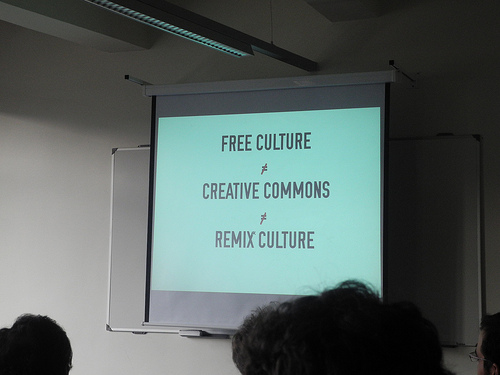
In his presentation, entitled “Libre Workflows – A Tragedy In 3 Acts”, Aymeric Mansoux was quick to point out that Creative Commons licences do not cover the source of the artwork. To put it into context, a JPG is covered by a Creative Commons licence but is the XCF/PSD file? Mansoux also considered what is actually a finished piece of artwork? In a remix culture is an artwork ever finished? Mansoux refers to this quote from Michael Szpakowski for further elaboration:
I’ve found it helpful to think of any artwork, be it literary, visual art or music as a kind of fuzzy four dimensional manifold. So the “complete” artwork is the sum of all its instances in time, and all epiphenomena. The entire artwork, seen this way, is a real and precisely enumerable sum, a concrete, not imaginary, set, which could be knowable in its entirety by something long lived and far seeing enough.
From their home town of Porto, Portugal, Ana Carvalho and Ricardo Lafuente produce Libre Graphics Magazine with ginger coons who is based in Toronto, Canada. For the production of the magazine they use Git, with their repository being hosted on Gitorious. As a tool for sharing files between collaborators Git is very useful. However, they explained that they feel they are not making effective use of all that Git has to offer. Part of this comes from the complexity of using Git. There are more than 140 commands in Git, each with their own unique function. These are usually entered via the command-line, but there are a number of programs with a Graphical User Interface (GUI) available. Programs with a GUI are usually favoured over command-line programs as they remove some of the complexity. Carvalho and Lafuente have found, however, that many of of these GUI programs simply replace commands with buttons, which doesn’t remove any of the complexity in using Git. What is needed is an easy to use specialised tool for the production of art.
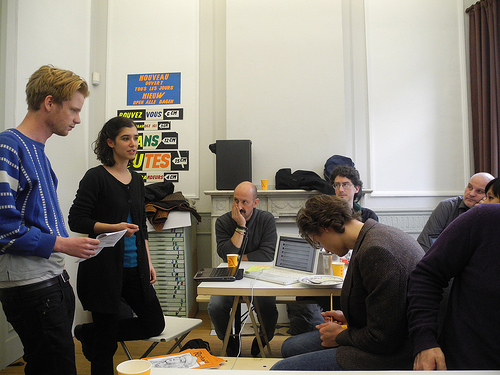
In this work session, presented by Ana Carvalho and Eric Schrijver, the work group imagined how to adapt existing version control tools to meet the needs of artists and designers. The session began by taking a look at how people currently implement version control. A common practice is to manually make backups, renaming files to differentiate between stages. This can be an effective way of making different versions, but it doesn’t address other issues such as making comparisons or merging changes. The ineffectiveness of these manual methods is soon very apparent. The work group was introduced to the Open Source Publishing (OSP) Visual Repository viewer, which begins to respond to some problems with current version control systems by providing thumbnails of files in a repository.
Using this as a basis we began to look at other functions that the OSP Visual Repository viewer should have, such as the ability to compare graphical files in different ways and to revert back to previous versions or merge versions. Although there was no time to produce working code we did seek to address the complex task of merging and comparing not only the ouput file but also the working files (svg/xcf/psd).
Every good work of software starts by scratching a developer’s personal itch.
This quote from The Cathedral and the Bazaar by Eric Steve Raymond could not be more accurate in describing the motivations behind the development of Laidout, developed by Tom Lechner, a comic artist from Portland, Oregon. Perhaps one of the most impressive software demonstrations of LGRU, Laidout is a program for laying out artwork on pages with any number of folds, which don’t even have to be rectangular.
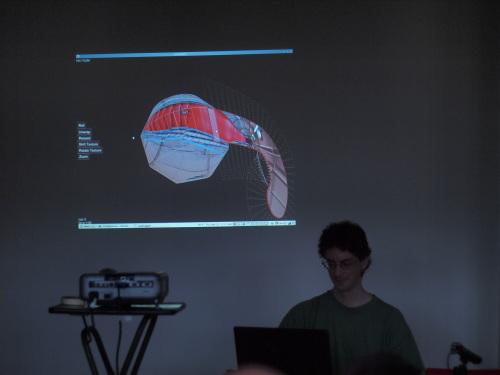
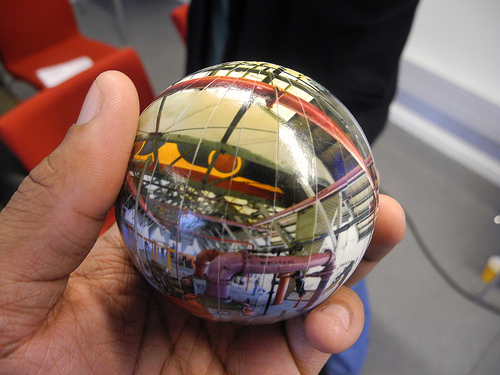
In an attempt to devise new tags that can be added to the SVG specification, Michael Murtaugh and Stephanie Villayphiou presented a work session that looked at the different ways language is interpreted by both humans and computers. To address this the work group took part in a task that saw them act as an interpreter of commands. With nothing more than a list of tags used in SVG files the work group would attempt to construct shapes.


The results varied from person to person and highlighted an important question: How can computers interpret ambiguity
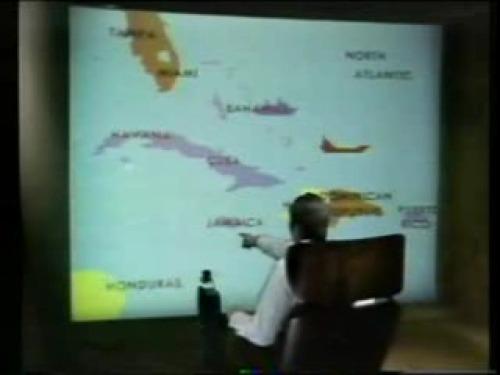
Using the Richard A Bolt “Put that there” demonstration, Murtaugh showed how human-computer interaction is still based around using very clear, unambiguous commands that can be easily interpreted by computers. In SVG only the most basic of shapes – rectangles, circles and lines – are represented. But, as the work group participants asked, could there be tags to represent more complex shapes, such as a horse?
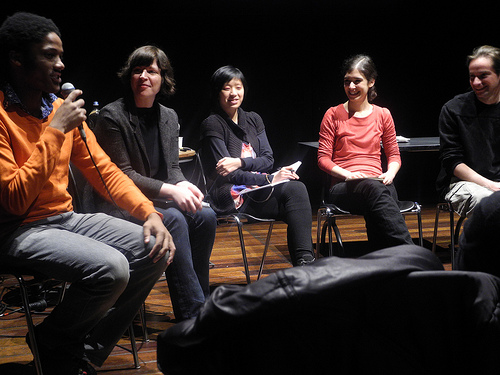
On the final day of the meeting I took part in a roundtable discussion, chaired by Angela Plohman and featuring myself, Stephanie Vilayphiou, Camille Bissuel and Ana Carvalho. The discussion first went over all that we had achieved over the four days at the meeting, and then the discussion focused on how and why we share our artwork. Expanding on the earlier quote from Szpakowski, how can we make sharing all of our artwork – including the early stages and inspirations behind it – an easier and integrated part of making artwork? In addition to sharing our final, “finished” artworks do we want to also share our processes and ideas behind the artwork? More importantly, can software easily aid this?
Other topics debated in the discussion revolved around opening up our artwork and processes to others. By opening up the development process of our artwork do we do so to invite collaborators and contributions or just observers? The Blender Open projects, for example, are highly regarded as an example of the work that can be made using open source software. The files used to make these projects are are released upon completion of the project, but the development process remains closed to the team of artists and developers. Would opening up this process to contributors add any value or could having too many ideas dilute the original vision of the project.
Although no conclusions around these topics were made, it was nonetheless important for everyone at the meeting to think critically about their practice
A concern of mine is that research is not always acted up on and exciting possibilities exist only as theory. However, I feel that the approach of Libre Graphics Research Unit, which combines research and practice, will ensure that the work undertaken at the meetings is implemented. It is actively working with developers and users to try and create solutions.
At the Co-Poistion meeting not one final product was made, but the initial vision for the future of layout was formed.
The next meeting, Piksels and Lines, takes place in Bergen, Norway and is organised by Piksel.
“It is not accidental that at a point in history when hierarchical power and manipulation have reached their most threatening proportions, the very concepts of hierarchy, power and manipulation come into question. The challenge to these concepts comes from a redsicovery of the importance of spontaneity – a rediscovery nourished by ecology, by a heightened conception of self-development, and by a new understanding of the revolutionary process in society.” Murray Bookchin. Post-scarcity and Anarchism (1968).
The rise of neo-liberalism as a hegemonic mode of discourse, infiltrates every aspect of our social lives. Its exponential growth has been helped by gate-keepers of top-down orientated alliances; holding key positions of power and considerable wealth and influence. Educational, collective and social institutions have been dismantled, especially community groups and organisations sharing values associated with social needs in the public realm. [1] Bourdieu.
In this networked society, there are controversies and battles taking place all of the time. Battles between corporations, nation states and those who wish to preserve and expand their individual and collective freedoms. Hacktivist Artists work with technology to explore how to develop their critical and imaginative practice in ways that exist beyond traditional frameworks of art establishment and its traditions. This article highlights a small selection of artists and collaborative groups, whose work is linked by an imaginative use of technology in order to critique and intervene into the opressive effects of political and social borders.
In June 2000, Richard Stallman [2] when visiting Korea, illustrated the meaning of the word ‘Hacker’ in a fun way. When at lunch with some GNU [3] fans a waitress placed 6 chopsticks in front of him. Of course he knew they were meant for three people but he found it amusing to find another way to use them. Stallman managed to use three in his right hand and then successfully pick up a piece of food placing it into in his mouth.
“It didn’t become easy—for practical purposes, using two chopsticks is completely superior. But precisely because using three in one hand is hard and ordinarily never thought of, it has “hack value”, as my lunch companions immediately recognized. Playfully doing something difficult, whether useful or not, that is hacking.” [4] Stallman
The word ‘hacker’ has been loosely appropriated and compressed for the sound-bite language of film, tv and newspapers. These commercial outlets hungry for sensational stories have misrepresented hacker culture creating mythic heroes and anti-heroes in order to amaze and shock an unaware, mediated public. Yet, at the same time hackers or ‘crackers’ have exploited this mythology to get their own agendas across. Before these more confusing times, hacking was considered a less dramatic activity. In the 60s and 70s the hacker realm was dominated by computer nerds, professional programmers and hobbyists.
In contrast to what was considered as negative stereotypes of hackers in the media. Steven Levy [5], in 1984 published Hackers: Heroes of the Computer Revolution [6]. In three parts, he writes about the canonical AI hackers of MIT, the hardware hackers who invented the personal computer industry in Silicon Valley, and the third-generation game hackers in the early 1980s. Yet, in this publication, what has had the most impact on hacker culture and is still used widely as a guideline by many is the ‘hacker ethic’. He identified this Hacker Ethic to be a code of practice consisting of key points such as that “all information is free”, and that this information should be used to “change life for the better”.
1. Access to computers—and anything which might teach you something about the way the world works—should be unlimited and total. Always yield to the Hands-on Imperative!
2. All information should be free.
3. Mistrust authority—promote decentralization.
4. Hackers should be judged by their hacking, not bogus criteria such as degrees, age, race or position.
5. You can create art and beauty on a computer.
6. Computers can change your life for the better.
Levy’s hacker ethic promotes the idea of performing a duty for the common good, an analogy to a modern day ‘Robin Hood'[ibid]. Proposing the concept that hackers are self-reliant whilst embracing a ‘healthy’ anti-authoritarian stance, combined with free and critical thinking. Proposing that hackers should be judged by their ability to hack, and presenting hacking as an art-form. Levy also says that the Free and open source software (FOSS) movement is the descendant of the hacker ethic. However, Levy’s hacker ethic has often been quoted out of context and misunderstood as to refer to hacking as ‘breaking’ into computers. This specifically prescribed role, denies the wider and creative context of what hacking is and could be. It does not have to be just about computer security.
This leads us to ‘crackers’. All crackers hack and all hackers hack. But, crackers are seen as second rate wannabe hackers by the older generation of hackers. The Black Hat Hacker or cracker designs and releases malicious code, gathers dangerous information and brings down sensative systems. The White Hat Hacker hunts down and destroys malicious code, and the casual hacker who hacks in order to learn information for his or her own curiosity; both generally dislike ‘Black Hats’ and ‘Crackers’, and tend to view them as computer criminals and dysfunctional juveniles. Lately, crackers have also been labeled as ‘script kiddies’. As a kind of snobbish insult, it refers to those who are not capable of building or programming their own tools, but tend to use scripts and programs written by others to perform their intrusions. To add to the confusion we also have the term ‘Grey hat’. Which refers to a hacker acting between black hat and white hat. Indeed, this could demonstrate where art hacktivists reside, challenging the trappings of the traditional concept of goody and baddy.
“There is another group of people who loudly call themselves hackers, but aren’t. These are people (mainly adolescent males) who get a kick out of breaking into computers and phreaking the phone system. Real hackers call these people ‘crackers’ and want nothing to do with them.” [7] Raymond.
“The basic difference is this: hackers build things, crackers break them.” [ibid] Raymond.
But before we judge,
let’s view a snippet of the \/\The Conscience of a Hacker/\/ by +++The Mentor+++
Written on January 8, 1986.[8]
“This is our world now… the world of the electron and the switch, the
beauty of the baud. We make use of a service already existing without paying
for what could be dirt-cheap if it wasn’t run by profiteering gluttons, and
you call us criminals. We explore… and you call us criminals. We seek
after knowledge… and you call us criminals. We exist without skin color,
without nationality, without religious bias… and you call us criminals.
You build atomic bombs, you wage wars, you murder, cheat, and lie to us
and try to make us believe it’s for our own good, yet we’re the criminals.”
The term ‘Hacktivism’ was officially coined by techno-culture writer Jason Sack in a piece about media artist Shu Lea Cheang published in InfoNation in 1995. Yet, the Cult of the Dead Cow [9] are also acknowledged as defining the term. The Cult of the Dead Cow are a group of hackers and artists. They say the Hacktivism phrase was originally intended to refer to the development and use of technology to foster human rights and the open exchange of information.
Hacktivism techniques include DoS attacks, website defacement, information theft, and virtual sabotage. Famous examples of hacktivism include the recent knocking out of the PlayStation Network, various assistances to countries participating in the Arab Spring, such as attacks on Tunisian and Egyptian government websites, and attacks on Mastercard and Visa after they ceased to process payments to WikiLeaks.
Hacktivism: a policy of hacking, phreaking or creating technology to achieve a political or social goal.
“Hacktivism is a continually evolving and open process; its tactics and methodology are not static. In this sense no one owns hacktivism – it has no prophet, no gospel and no canonized literature. Hacktivism is a rhizomic, open-source phenomenon.” [10] metac0m.
The practice or behaviour of Hacktivism is at least as old as Oct 89 when DOE, HEPNET and SPAN (NASA) connected to (virtual) networked machines world wide. They were penetrated by the anti-nuclear group WANK worm.
WANK penetrated these machines and had their login screens altered to…
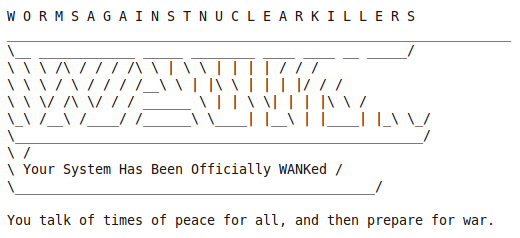
HACKING BORDERS: Examples of Art Hacktivism & Cultural Hacking…
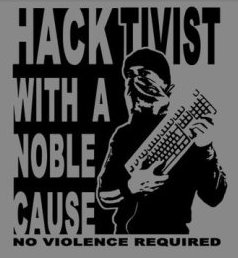
“Radical groups are discovering what hackers have always known: Traditional social institutions are more vulnerable in cyberspace than they are in the physical world. And some members of the famously sophomoric hacker underground are becoming motivated by causes other than ego gratification.” [11] Harmon.
Hacktivism, exploits technology and the Internet, experimenting with the immediacy of distributable networks as a playful medium for independent, creative and free expression. There has been a gradual and natural shift from net art (and net.art) into Hacktivism. Net Art in spirit, has never really been just about art being viewed on a web browser alone. Some of the very same artists whose artwork involved being shown in browsers and making code behind the browser as part of the art, have also expanded their practice outside of the browser. One such artist is Danja Vasiliev, “Fifteen years ago WWW was something very new in Russia and besides the new dial-up aesthetics and world-wide means it brought a complete new layer of existence – “netosphere”, which made my youth.” Vasiliev very soon moved on from playing with browsers into a whole new territory. [12]
Danja co-founded media-lab moddr_ in 2007, a joint project at Piet Zwart Institute alumni and WORM Foundation. Based in Rotterdam moddr_ is a place for artists and hackers, engaging with critical forms of media-art practice. He collaborated with Gordan Savicic and Walter Langelaar from the moddr.net lab on the project Web 2.0 Suicide Machine, which lets you delete your social networking profiles and kill your virtual friends, and it also deletes your own profile leaving your profile image replaced by a noose.”The idea of the “Web 2.0 Suicide Machine” is to abandon your virtual life — so you can get your actual life back, Gordan Savicic tells NPR’s Mary Louise Kelly. Savicic is the CEO — which he says stands for “chief euthanasia officer” — of SuicideMachine.org.” [13]
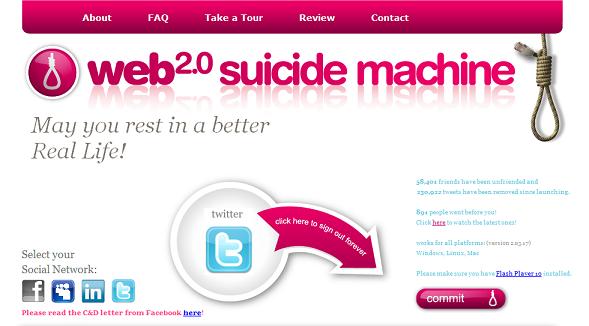
Just like another project called ‘Face to facebook’ that stole 1 million facebook profiles and re-contextualized them on a custom made dating website (lovely-faces.com), set up by Italian artists Paolo Cirio and Alessandro Ludovico, whom also just so happens to be editor in chief of Neural magazine. Web 2.0 Suicide Machine, had to close its connections down regarding its Facebook activities after receiving a cease and decease letter from Facebook. [14]
Julian Oliver and Danja Vasiliev teamed up and formed the mysterious group Men in Grey. The Men In Grey explore our online vulnerabilities by tapping into, intervening into wireless network traffic. Observing, tracing and copying what we do. This hack then redisplays our activities back to us, showing the data of our online interactions.
At first no one (except myself & a few others) knew who they were. When they first arrived on the scene I started an interview with them and then suddenly, I was asked to hold back due to their antics on the Internet and interventions in public environments receiving much coverage. They were not sure how it would pan out for them. Partly due to the anonymous nature of their project, and also because of the sudden impact of the larger hacktivist group Anonymous getting much press in commercial media themselves.
“Men In Grey emerge as a manifestation of Network Anxiety, a fearful apparition in a time of government wiretaps, Facebook spies, Google caches, Internet filters and mandatory ISP logging.” M.I.G
“Spooks are listening into calls, just like they always have,” said Eric King of London’s Privacy International, in an e-mail. “With A5/1 being broken—you can decrypt and listen into 60 calls at once with a box smaller than a laptop.” [15]
Later they won the Golden Nica (1st prize) Interactive Arts category, Prix Ars Electronica in 2011. In a show called Project Space — M.I.G. — Display of unknown, quarantined equipment hosted at the Aksioma Project Space Komenskega, Ljubljana 2011. The statement read:
“The particularly threatening quality of the Men In Grey equipment is its apparently invasive nature; it seems able to penetrate – and even hack into – virtually any electronic device in its reach. While we are all aware of the wire-tapping and data retention done by the government (along with the spying carried out by corporations like Facebook and Google), Men In Grey seem to operate with a range of tools and techniques well beyond those that are currently known to be in use.”
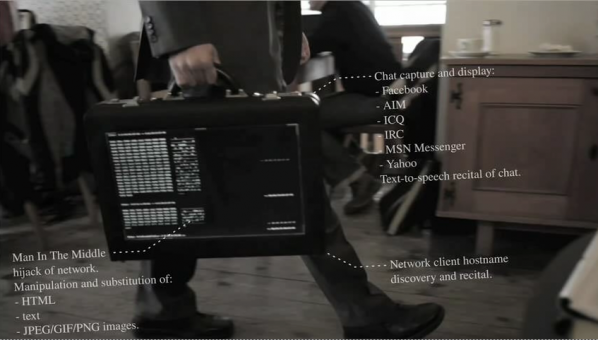
Hacktivism involves many different levels of social intervention and engagement. Whether it is to do with direct action, self-referential geekiness, obscure networked antics, crtical gaming, or peer 2 peer and collective change. Hacktivists challenge defaults put in place by other people, usually the systems imposed upon them and the rest of us by authority. Even though the subjects themselves may be concerning serious matters, humour and playfulness are both essential ingredients.
“A promising tactic for the early Situationists was the unpredictable yet forceful potential of play — what anthropologist Victor Turner termed the “liminoid,” or the freeing and transformational, moments of play when the normal roles and rules of a community or society are relaxed.” [16] Dovey & Kennedy.
One group crossing over from the digital into physical and social realms, is Tiltfactor. [17] Their form of intervention is not necessarily about causing political controversy, but is engaged in reaching people through games of play. Experimenting with social everyday contexts, making games that tackle less traditional topics, such as public health, layoffs, GMO crops. One of the many games creating awareness on these subjects, is POX “Our game actually helps a player understand how a disease can spread from one place to another and how an outbreak might happen” says Mary Flanagan. [18]
A local public health group called Mascoma Valley Health in the New Hampshire region of the US approached Tiltfactor with the problem of the lack of immunization. “At first, a game about getting people immunized seemed like one of the most “un-fun” concepts imaginable. But that sinking feeling of impossibility almost always leads to good ideas later.” [19] Flanagan.
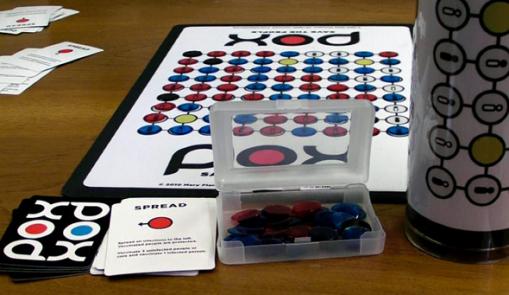
“Geopolitical space has always been a conflicted and fragile topic. Borders and frontiers are changing so fast, that sometimes it seems that our sociopolitical status can change from “citizen” to “immigrant” from one moment to another, or simply live under the “immigrant” status all your life. We’re getting used to words like refugees, enclaves, war, borders, limits –and the list has no end.” Ethel Baraona Pohl & César Reyes
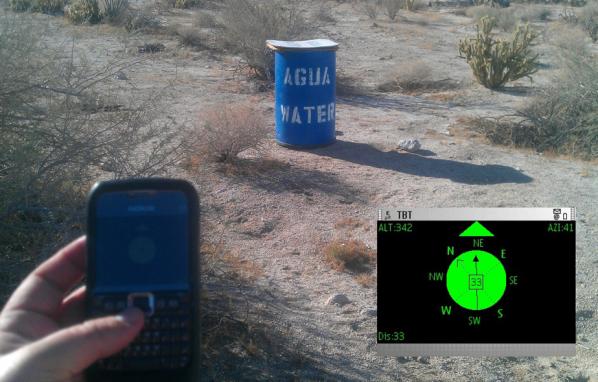
Ricardo Dominguez collaborated with Brett Stalbaum, Micha Cardenas, Amy Sara Carroll & Elle Mehrmand, on (TBT) (and others), on a hand-held mobile phone device that aids crossers of the Mexico-US border. An inexpensive tool to support the finding of water caches left in the Southern California desert by NGO’s for those crossing the border.
“The entire group of artists who are part of Electronic Disturbance Theater 2.0/b.a.n.g. lab working on the Transborder Immigrant Tool (TBT) was being investigated by UCSD and 3 Republican Congressmen starting on January 11, 2010. Then I came under investigation for the virtual sit-in performance (which joined communities statewide against the rising students fees in the UC system and the dismantling of educational support for K–12 across California) against the UC Office of the President (UCOP) on March 4, 2010. This was then followed by an investigation by the FBI Office of Cybercrimes.” [20] Ricardo Dominguez.
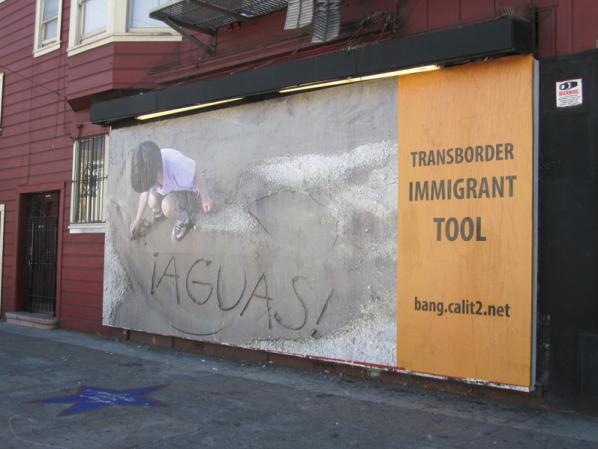
In an interview with Lawrence Bird Dominguez discusses that the TBT is still developing as a gps tool, but infers that it is not just a tool but also ‘border disturbance art’, consisting of different nuances existing as part of a whole with other factors at play. Such as a hybrid mix of things, objects and expressions “artivism, tactical poetries, hacktivism(s), new media theater, border disturbance art/technologies, augmented realities, speculative cartographies, queer technologies, transnational feminisms and code, digital Zapatismo, dislocative gps, intergalactic performances, [add your own______].” [ibid]
“Borders are there to be crossed. Their significance becomes obvious only when they are violated – and it says quite a lot about a society’s political and social climate when one sees what kind of border crossing a government tries to prevent.” [21] Florian Schneider
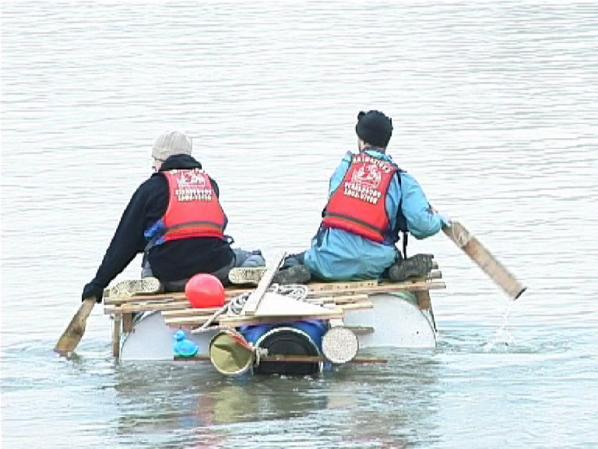
National borders are front-lines of political and social friction. The exerience of asylum-seekers and political migrants reflect some of the most significant issues of our time. Immigration is a toxic issue and unpopular with voters. Bunting’s BorderXing Guide, plays on the fear of invisible alien hordes of people crossing our borders illegally.
The context of this work fits well with issues about borders, whether it is about creating borders online or physical environments. Only those needing to cross a border are allowed access to the site, it is limited to ‘social clients’ who have a static IP (Internet Protocol) address and who, most notably, have gained the artist’s confidence. Such as peer activists and immigrants using libraries, colleges, cultural centres. The site allows those who would other wise end up crossing borders in harmful ways, such as in containers, on the backs of (and underneath) lorries and planes.
Heath Bunting’s BorderXing Guide website primarily consists of documentation of walks that traverse national boundaries, without interruption from customs, immigration, or border police. The work comments on the way in which movement between borders is restricted by governments and associated bureaucracies. It is a manual written not at distance like a google map, but by foot. A physical investigation, involving actually going to these places; trying these discovered routes out and then sharing them with others. A carefully calculated politics of public relations.
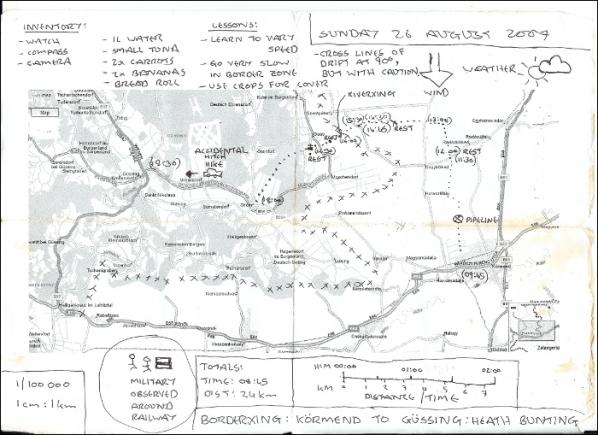
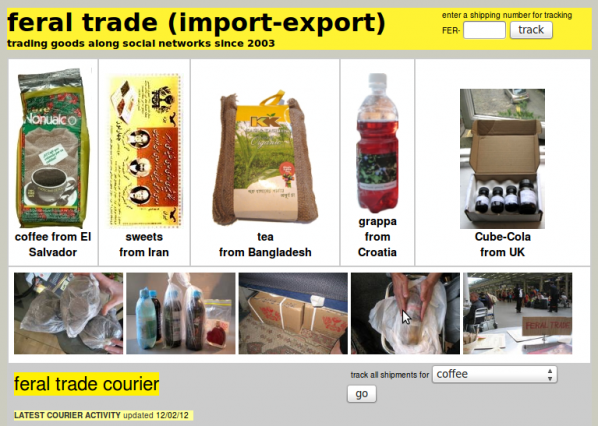
“The Feral Trade Café is more than just an art space that’s a working café, it’s about provoking people to question the way big food corporations operate by looking at the journey of the food we end up scraping into our pampered bins.” [22] Gastrogeek
Feral Trade uses social and cultural hand baggage to transport food based items between cities, often using other artists and curators as mules. Feral Trade products (2003-present), alongside ingredient route maps, bespoke food packaging, video and other artefacts from the Feral Trade network. The goods rangefrom coffee from El Salvador, hot chocolate from Mexico and sweets from Montenegro, as well as locally sourced bread, vegetables and herbs.
Kate Rich uses the word ‘feral’ as a process refering to being deliberately wild, as in pigeon, as opposed to romantic nature wild as the wolf. It is an unruly wild, shitting everywhere, disruption and annoyance in contrast to ‘official’ human structures and connected infrastructures. Feral Trade freight operates largely outside commercial channels, using the surplus potential of social, cultural and data networks for the distribution of goods. Working with co-operatives, small growers and food producers.
The Feral Trade Courier is a live shipping database for a freight network running outside commercial systems. The database offers dedicated tracking of feral trade products in circulation, archives every shipment and generates freight documents on the fly.
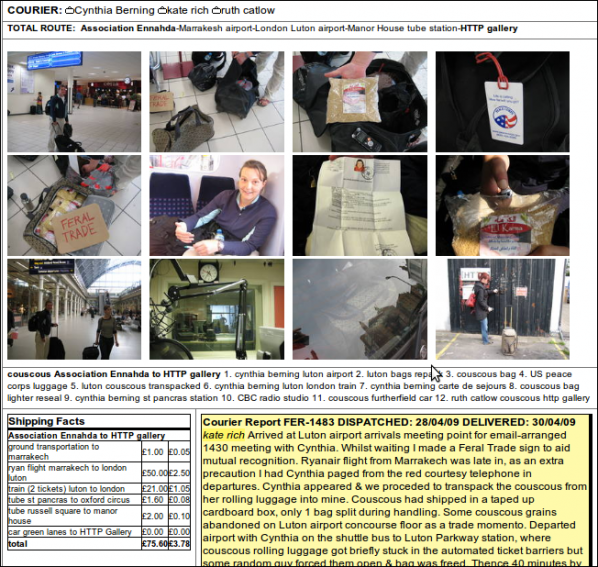
Every shipment is different and has its own story of how and where it was delivered from. Also included is information on who the carriers are with details about producers and their local culture as contextual information. The product packaging itself is also a carrier of information about social, political context and discussions with producers and carriers.
![Feral Trade at Furtherfield's Gallery (2009) [23] Link to exhibition](http://www.furtherfield.org/wp-content/uploads/2012/03/3657297700_42b1c26014_b.jpg)
Since the rise of the Internet individual and collective actions are symbiotically connected to the every day. In a world transformed, common people have access to tools that can change ‘our’ cultures independently; sharing information, motivating actions and changing situations. We know of the Arab Spring, the Occupy movement, Anonymous and Wikileaks and how successful they have been in exploiting technology and social networks. Technology just like any other medium is a flexible material. By tweaking, breaking and remaking ‘something’ you can re-root it’s function, change its purpose.
The links between these mass social movements and the artists here are not just relating to technology’s use but, a shared critique at the same enemy, neo-liberalism.
“”Neo-liberalism” is a set of economic policies that have become widespread during the last 25 years or so. Although the word is rarely heard in the United States, you can clearly see the effects of neo-liberalism here as the rich grow richer and the poor grow poorer.” [24] Martinez & Garcia.
At the same time as highlighting the continual privatization of human society. This form of art practice shows us the cracks of where a social divide of gate-keeping has maintained power within the Western World’s, traditional art structures. We now realize that the art canons we have been taught to rely on as reference are more based around privelage, centralization and market dominance rather than democratic representation or even just pure talent. Hacktivist artists adapt and recontextualize with a critical approach, towards a larger and more inclusive context beyond their own immediate selves. Demonstrating a respect and use of autonomy, and an awareness of social contexts and political nuances, freeing up dialogue for new discussions which include a recognition of social contexts, as a vital ingredient and valued resource in art. Re-aligning, reconfiguring the defaults of what art is today.
Featured image: ‘Angry Women’ by Annie Abrahams, 2011. (From photograph by Michael Szpakowski)
Opening Event: Saturday 25 February 2012, 1-4pm
Open Thu – Sat 12 noon – 3pm
contact: info@furtherfield.org
See images from the exhibition here
Read reviews of Being Social on Wired magazine and Enfield Independent
Being Social is the opening exhibition at Furtherfield Gallery in Finsbury Park in North London. Furtherfield has established an international reputation as London’s first gallery for networked media art since 2004. With this exciting move to a more public space Furtherfield invites artists and techies – amateurs, professionals, celebrated stars and private enthusiasts – to engage with local and global, everyday and epic themes in a process of imaginative exchange.

This exhibition brings together artworks by emerging and internationally acclaimed artists: Annie Abrahams, Karen Blissett, Ele Carpenter, Emilie Giles, moddr_ , Liz Sterry and Thomson and Craighead.
Since the mid-90s computers have changed our way of being together. First the Internet then mobile networks have grown as cultural spaces for interaction – wild and banal, bureaucratic and controlling – producing new ways of ‘being social’. Visitors are invited to view art installations, software art, networked performances and to get involved with creative activities to explore how our lives – personal and political – are being shaped by digital technologies.
Free activities for all ages (booking advisable) Saturday 10-1pm
Embroidered Digital Commons with Ele Carpenter and Emilie Giles
Furtherfield invites all gallery visitors to take part in one or more of our Saturday morning embroidery sessions and come together to stitch a term from the Raqs Media Collective’s text ‘A Concise Lexicon of/for the Digital Commons’ (2003), chosen in relation to the specific theme of the Being Social exhibition at Furtherfield Gallery. Throughout March and April 2012.
To book a place please contact Alessandra Scapin ale@furtherfield.org +44 (0) 2088022827

Annie Abrahams
Annie Abrahams has a doctorate in biology from the University of Utrecht and a degree from the Academy of Fine Arts of Arnhem. In her work, using video, performance as well as the internet, she questions the possibilities and the limits of communication in general and more specifically investigates its modes under networked conditions. She is an internationally regarded pioneer of networked performance art. She has performed and shown work extensively in France, including at the Pompidou Centre, Paris, and in many international galleries including, among others, Espai d’Art Contemporani de Castelló, Spain; the Museum of Contemporary Art, Tokyo; and the Armenian Center for Contemporary Experimental Art, Yerevan; festivals such as the Moscow Film Festival and the International Film Festival of Rotterdam, and on online platforms such as Rhizome.org and Turbulence.
Karen Blissett
Karen Blissett was born on the 3rd of May 1991, on the same day that the first successful double head-heart transplant was being carried out in a hospital in London. Her parents are the neoist artists Karen Eliot and Luther Blissett. They are only interested in art and politics, not in how Karen spends her days on the Internet.
Ele Carpenter
Ele Carpenter is a curator based in London. Her creative and curatorial practice investigates specific socio-political cultural contexts in collaboration with artists, makers, amateurs and experts. She is a lecturer in Curating at Goldsmiths College, University of London.
Since 2005 Ele has facilitated the Open Source Embroidery project using embroidery and code as a tool to investigate the language and ethics of participatory production and distribution. The Open Source Embroidery exhibition (Furtherfield, 2008; BildMuseet Umeå Sweden, 2009; Museum of Craft and Folk Art, San Francisco, 2010) presented work by over 30 artists, including the finished Html Patchwork now on display at the National Museum of Computing at Bletchley Park. Ele is currently facilitating the ‘Embroidered Digital Commons’ a distributed embroidery exploring collective work and ownership 2008 – 2013.
Emilie Giles
Emilie Giles is an alumnus of MA Interactive Media: Critical Theory and Practice at Goldsmiths College. Since graduating in 2010 her time has been spent co-organising MzTEK, a women’s technology and arts collective, as well as completing an internship with arts group Blast Theory and working for social video distributors Unruly. She is currently involved with TESTIMONIES, a project which explores oral history in relation to the 2012 Olympic and Paralympic Games largely through social media.
Emilie’s own practice revolves around notions of pervasive gaming, married with urban exploration and psychogeography. Her most recent focus lies in taking fundamental gaming principles from Geocaching and exploring the consequences of adding an emotional dimension.
moddr_
moddr_ is a Rotterdam-based media/hacker/co-working space and DIY/FOSS/OSHW fablab for artgeeks, part of the venue WORM: Institute for Avantgardistic Recreation. Since being founded in 2007 by alumni of the Piet Zwart Institute (department of “Networked Media“) they host and promote young local and international talent with a focus on the artistic modification (’modding‘) of contemporary and emerging technology. moddr_ represents a critical attitude in our ‘new’-medialandscape through spawning and development of artistic projects, workshop series, lectures, exhibitions and of course good parties.
Liz Sterry
Liz Sterry is an Essex based artist currently completing a Digital Art and Design degree at Writtle College. Liz works using different mediums including performance photography, video and installations. Communication has now become a key theme in her work. She aspires to make art that invites people to question what they think they already know.
Thomson and Craighead
Jon Thomson and Alison Craighead are artists living and working in London. They make artworks and installations which are shown in galleries, online and sometimes outdoors. Much of their recent work looks at live networks like the web and how they are changing the way we all understand the world around us. Their work has been shown in major international exhibitions and is part of public collections at Harris Museum and British Council Collection. They are shortlisted artists for the Samsung Art Prize 2012. Recent awards include Current (2011) and Vital Spark (2005). Having both studied at Duncan of Jordanstone College of Art in Dundee, Jon now lectures part time at The Slade School of Fine Art, University College London, while Alison is a senior researcher at University of Westminster and lectures in Fine Art at Goldsmiths University.
Four spaces – the Park, the Gallery, the Common Room, the www
Furtherfield’s new gallery at McKenzie Pavilion is located in a highly animated area of Finsbury Park next to a boating pond and adventure playground, near to the café and athletics track. The richly connected diversity of people, creatures, plants, activities, enthusiasms alive in the park provides the context and the inspiration for Furtherfield. The pavilion has two rooms.
The Gallery, which will display evocative and provocative exhibitions of selected contemporary artwork that address technology and social change drawing on Furtherfield’s international network of artists.
The Common Room, which will display work contributed by open call in response to exhibition themes, curated with local people. It will also act as the base for a series of free activities for local schools and visitors to the park.
Finally the www connects local users to an international network of enthusiasts, experts and audiences. It provides a place for people to share their artworks, proposals, ideas and commentaries. It will also provide access to further information about exhibitions, including downloadable catalogues and essays, information about programmes of free events and activities, and a living archive of all past work.
Furtherfield will exhibit the best of contemporary work in art, technology and social change in a truly ‘public’ space, developed with and for local residents and users of the park, and wider participants and audiences. Ultimately, we are looking for ways for local people and visitors to the park and from further afield to use this art space imaginatively together, and to connect with our international community of artists, designers, thinkers and technologists.
Furtherfield Gallery
McKenzie Pavilion, Finsbury Park
London N4 2NQ
T: +44 (0)20 8802 2827
E: info@furtherfield.org
Furtherfield Gallery is supported by Haringey Council and Arts Council England
Since the turn of the millennium, there have been shifts toward new forms of sociopolitical dissent. These include strategies such as cellular forms or resistance including asymmetrical warfare like global insurgencies, the use of social media. Examples would be Twitter and Facebook in their ability to lens dissent for actions in Syria, Egypt and Tunisia, Wikileaks and its ability to mirror, and politics that use anarchistic forms of collective action such as the Occupy Movement. Although my focus is more concerned with the Occupy Movement, what is evident is what I call an amorphous politics of dissent. Amorphous is defined as “without shape”, and can be applied to most of the mise en scenes listed above.
The dissonance of power in regards to conventional politics can be seen in its structure. For example, the nation-state has a tiered, hierarchical structure of power relations. There is a President or Prime Minister, a legislative organ of MPs or Representatives, Parliaments, Houses, and the like, a Judicial organ, and a Military organ that includes any number of militia and police. Although I am referring mostly Western forms of government, we can also argue for the hierarchical form in terms of the Corporation, with its CEO, Board, Shareholders, Managers, and Workers. This can be expanded historically to Feudal lords with their retinue of Vassals, Nobles and Warlords with their coteries of Warriors and support personnel. The point is that conventional power typically operates in a pyramidal command and control hierarchy with a centralized Leader at the “capstone”. One can argue that the pyramid may have different shapes, or angles of distribution of power, but in the end, there is usually a terminal figure of authority. To put it in terms of stereotypical Science Fiction terminology, when the alien comes to Earth, the standard story is that it pops out of the spacecraft and says, “Take me to your leader.” This signifies the hegemonic paradigm of Leadership as the central gestalt of First world power. Leadership, then, is the conventional paradigm of power in Western culture, and dominates the industrialized world.
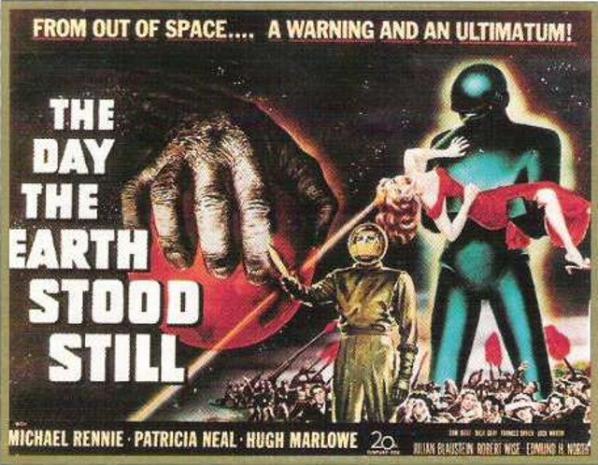
Territorialization refers to the exertion of power along perimeters, or borders. Functionaries expressing the constriction of territory include customs agents, and border patrols; but are terminally expressed by the military wing of the nation state. This military is also generally pyramidally constructed in terms of Generals, Colonels, and other officers leading Battalions, Regiments and Divisions, which are organized as defenders of a nation’s sovereignty. These military organs are conversely best optimized to exert their power against either parallel or subordinate structures. Parallel structures include the armies of other nations, their Officers, et al, and their troops and ordnance that possess a similar organization. Conversely, subordinate structures over which military powers can exert power over are domestic masses that can be overrun with overwhelming power, although these forces are more specialized (such as National Guards or Gendarmeries). In the conventional sense, power is expressed orthogonally, whether it is against equal or subordinate forces.
Another aspect of this conversation relates to the expression of power/force through conflict and violence, but has its inconsistencies The examples I will use from American pop culture I will use in this missive to explain amorphous action may be violent in nature, but the violent nature of these examples do not relate to the paradigmatic jamming of conventional power. Their citation is related more to the fact of conventional power’s orthogony, or parallelism of exertion of power to similar structures or dominance of the subordinate, and the panic state it experiences when confronted with non-conventional difference or passive resistance. We could express the power relationships between amorphous politics and conventional power in terms of a tetrad in terms of examples of violent and peaceful exertion of amorphous dissent as well as orthogonal conflict. We could cite the Occupy movement as a site of passive, and the Tunisian uprising as violent exemplars of amorphous conflict or dissent. Conversely, the Gandhi/King is a non-violent model of as orthogonal/hierarchical/led action, and World War Two as conventional orthogonal conflict. What is important here is the inability of the conventional politics and power to cope with leaderless, non-hierarchical, non-orthogonal discourse that refuses to talk in like terms such as centralization, leadership and conventional negotiations that include concepts such as “demands”. This is where the site of cognitive dissonance erupts, often resulting in a panic state or in the “figureheading” of dispersed networks of power.
The need for the traditional power structure to focus identity on the antagonist in terms of figureheads is evident in the Middle East and Eurasia in the personification of terrorist and insurgent networks, but is more simply illustrated in the films Alien and Aliens, and Star Trek: The Next Generation. Both of these feature their respective antagonists, the “alien” as archetypal Other, and the Borg, symbol of autonomous, collective community. In Alien, the crew of the Nostromo encounters an alien derelict ship that has been mysteriously disabled to find a hive of eggs of alien creatures whose sole role is the creation of egg factories for further reproduction. At the onset of the franchise, pilot Ellen Ripley is positioned as the “everywoman” placed in the center of cataclysmic events. In the Alan Dean Foster book adaptation, and an extended edit of the Scott film, Ripley finds during her escape from the ship that Captain Dallas has been captured and organically transformed into a half-human egg-layer whom she immolates with a flamethrower. However, in the Aliens sequel, the amorphous society of the self-replicating aliens has been replaced by a centralized hive, dominated by a gigantic Queen that threatens to impregnate the daughter-surrogate Newt. This transformation from a faceless to centralized threat creates a figurehead for the threat and establishes a clear protagonist/antagonist relationship, and establishes traditional orthogony.
This simplification of dialectic of asymmetrical politics is also evidenced in Star Trek: The Next Generation by the coming of the Borg, a collective race of cybernetic individuals. Although representations of the Borg vary as to fictional timeline, in televised media they began as a faceless hive-mind, which abducted Captain Jean-Luc Picard as a mouthpiece, not as a leader. It was inferred that if one sliced off or destroyed a percentage of a Borg ship, you did not disable it; you merely had the percentage left coming at you just as fast. However, by the movie First Contact, the Borg now possesses a hierarchical command structure to their network and, more importantly, a queen. With the assimilated and reclaimed android Lieutenant Data, the crew of the Enterprise infiltrates higher level functions of the Borg Collective, effectively shutting down the subordinate elements of the Hive. In addition, the Queen/Leader is defeated, assuring traditional figurehead/hierarchy power relations rather than having to deal with the problems of the amorphous, autonomous mass. There are other “amorphous” metaphors in cinema that address the issue of amorphousness. These include the 1958 movie, The Blob, in which a giant amoeba attacks a small town and grows as it engulfs everything. Another is The Thing, about a parasitic alien that doppelgangs its victims, creating another form of faceless threat. Lastly, we have the classic Invasion of the Body Snatchers where alien plant “pods” would bear fruit of duplicates of living people, giving a metaphor for the Communist threat of the Red Scare originating during the Cold War. Perhaps these are historical references to mediated expressions of anxiety in regard to autonomy’s threats to regimented/striated hegemony, stating that this sort of anxiety and terror are not new.
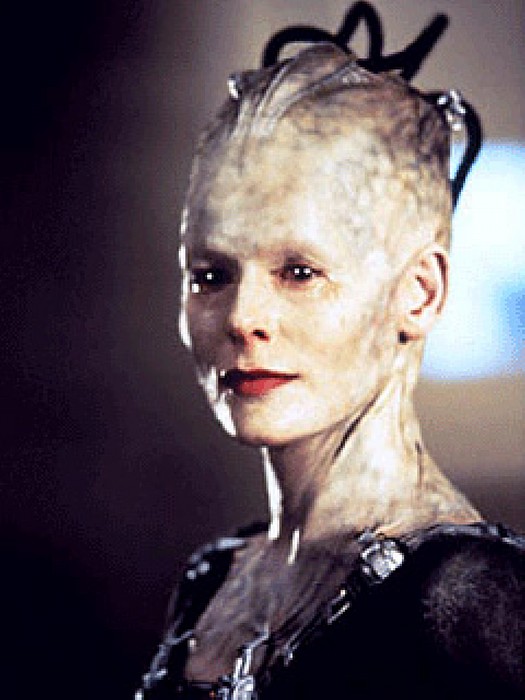
One of the most asymmetric cultural Western interventions in relation to constructs of traditional power is the involvement of Anonymous as part of the Occupy Movement. Anonymous, which has been called a “hacker group” in the mass media, is a taxonomy created on the online image sharing community 4chan.org, arising from the practice of posting “anonymously” unless one wants to use a name, or handle. Although the idea of Anonymous is at best an ad hoc grouping, the use of the “group” name has been ascribed to various factions. According to The State News, “Anonymous has no leader or controlling party and relies on the collective power of its individual participants acting in such a way that the net effect benefits the group.“ The idea of Anonymous fits with the “faceless collectives” mentioned above, and certainly presents an asymmetric, if not non-orthogonal, exercise of power. Anonymous first rose as a voice of dissent that emerged against the Church of Scientology (see Project Chanology), where flash mobs of individuals in Guy Fawkes masks and suits arrived to protest at sites around the world, with boom boxes playing “The Fresh Prince of BelAir”, a popular agitational or “trolling” anthem. It has engaged in other activities, including hacking credit card infrastructures opposed to handling donations to Wikileaks and creating media around Occupy Wall Street. However, without a clear infrastructure and only transient figureheads, Anonymous functions as an organizing frame for a cloud of individuals interested in various collective actions, and represents an indefinite politics based on networked culture. In an expected exercise of force, during the actions against elements opposed to Wikileaks, conventional power struck back wherever it could against members of Anonymous, by arresting over 21, some violently, in July during the actions against credit providers boycotting Wikileaks. This exercise of power was repeated in September, with admonitions about the arrests appearing on YouTube thereafter. Anonymous has also posted videos in support of the Occupy movement. Such a response is not surprising, but is the exact response to non-orthogonal dissent under our model. The problem is that in arresting any number of Anonymous members, traditional power is confronted with the first, distributed model of the Borg that merely exists minus two or twenty members.
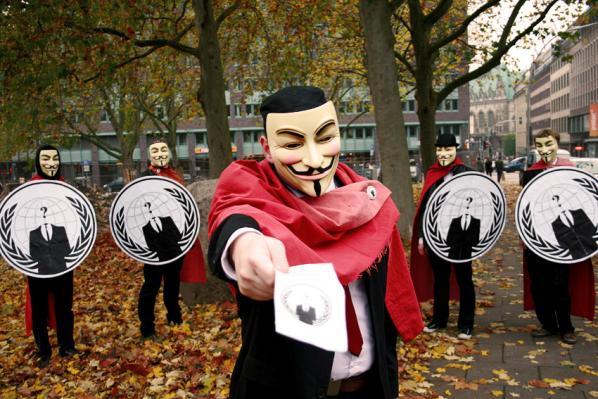
Another dissonance between the Occupy Movement and conventional politics is the perceived lack of agenda. This is due to its dispersion of discourse in giving its constituents collective importance in voice. What is the agenda of the disempowered 99% of Americans, or world citizens marginalized by global concentration of wealth? Simply put, the agenda is for the disempowered to be heard. What does that mean? It means anything from forgiveness of student loans to jobs to redistribution of wealth to affordable health care, and so on. It isn’t a list; it is a call to systemic change of the means of production, distribution of wealth and empowerment in political discourse. It isn’t as simple as “We want a 5% cut in taxes for those making under $30,000.” It’s more akin to “We’re tired that there are so many sick, hungry, poor and uneducated, and we want it to end. Let’s figure it out.” It is the invitation to the beginning of a conversation that has no simple answers other than the very alteration of a paradigm of disparity that has arisen over the past 40 years through American capitalism.
The last challenge to the traditional power discourse is that of passive resistance. This is not a new strategy, especially under the aegis of Gandhi and King’s movements. However, it is traditional power’s mere tolerance of nonviolent resistance that does not result in violence. As we can see from the UC Davis assaults and the dispersions after the second month anniversary, conventional power exerts its force against, as Brian Holmes put it, “anomalies” so that the system can be restored and the commodifiable classes are reintegrated into the system to reproduce its agendas. As long as resistance does not present undue inconvenience for the circulation of power and capital, it is allowed. Once it loses its patience with non-orthogonal forces, or if materially sacralized spaces, like Wall Street are threatened, the hegemonic order is reified. The irony of the technical loophole of Zucotti Park being privately owned and having few rules allowed the Occupy movement also highlights the tenuousness of public discourse in Millennial America. However, even with this oddity, on the two-month anniversary of Occupy Wall Street, force has begun to be used against the occupiers as traditional power’s patience grows thin with amorphous politics. In the streets, the marches are split up, and rules about occupation begin to be enforced with cupidity. As said before, hegemonic patience has worn thin, with assaults/dispersions taking place in Oakland, Davis, Philadelphia, and New York, among others. However, the movement moves forward for the moment.
Amorphous politics is based on plurality, collectivism, dispersion and ideas. The hierarchical nation-state has no idea what to do with the amorphous blob as it grows except to try to contain it, but as with Anonymous, it is a whack-a-mole game. If one smacks down one protest, two pop up across town, or five websites pop up on the Net. Shut down Wikileaks, and a thousand mirror sites show up. People in the streets swarm New York and other cities throughout the US, and the world, and conflict arises. Asymmetry and amorphousness are dissonances to traditional power. Ideas in themselves are not hierarchical.
Desires sometimes have no agendas.
Sometimes people want what is right, and all of it.
On 28th October 2011, I travelled to Sète in the South of France to see and review Annie Abrahams’ show Training for a Better World.
The first of two reviews (the second will be somewhat longer and in an academic journal later this year) is now available on DVblog.
What was particularly pleasing about going to the press view and then staying on for the opening proper was the opportunity to engage with the work over quite a long period – some four hours.
About halfway through the evening, I started both photographing and sketching as aides-memoire for my reviews, but I soon began to enjoy the feeling of responding to the work for its own sake, and I began to think about presenting the drawings and photographs (plus some drawings made from the photos two days later, as well as a couple of manipulated photos) as a kind of photo-essay/derivative work.
The Transborder Immigrant Tool (TBT) is a project created by the University of California at San Diego’s Electronic Disturbance Theater (EDT) 2.0/b.a.n.g. lab, and still evolving today. Here Ricardo Dominguez, co-founder of EDT (with Brett Stalbaum), Principal Investigator of b.a.n.g. lab, and Associate Professor in the Visual Arts Department at UCSD, discusses the project with Lawrence Bird. The interview includes input from other members of the collective: Brett Stalbaum, Micha Cardenas, Amy Sara Carroll and Elle Mehrmand.
Lawrence Bird: Simply put, the Transborder Immigrant Tool is a hand-held device to aid crossers of the Mexico-US border. As far as the cultural and political implications of this device, it’s loaded. But as a starting point, could you tell us a little bit about the technical side of the device?
Ricardo Dominguez: We began with the basic question: what ubiquitous technology would allow us to create an inexpensive tool to support the finding of water caches left in the Southern California desert by NGO’s? Our answer was that the sub-$20 iMotorola phone series could be made useful for emergency navigation. The early generation of the platform we targeted can be made reasonably useful in a better-than-nothing scenario. Meanwhile, later phone generations (that don’t yet cross our price barrier but are getting closer everyday) are already fully useful as practical aids without even a SIM card installed or an available network service. With proper use, the GPS performance of newer phones equals any GPS designed for desert navigation, and their used prices are falling. Moreover, GPS itself does not require service and has free global coverage, courtesy of the United States government. In an emergency scenario, we trust these later mobiles to direct a lost person to a nearby safety site. The TBT’s code is also available on-line to download at walkingtools.net, sans water cache locations, for any individual or community to use for their GPS investigations.

Lawrence Bird: It’s an interesting instance of technology intersecting with geography. You have referred to Donna Haraway’s work in your own comments on the intersection between “border crossing” and other forms of “trans”-being. Would it be accurate to see the TBT as a cyborg component; and if so, what does this mean for the relationship between technology, politics and poetics?
Ricardo Dominguez: Part of the TBT project is to call into question the northern cone’s imaginary about who has priority and control of who can become a cyborg or “trans” human – and immigrants are always presented as less-than-human and certainly not part of a community which is establishing and inventing new forms of life. When in fact these flowing in-between immigrant communities are a deep part of the current condition that Haraway’s research has been pointing towards – for us it is a queer turn in its emergence, both as unexpected and as desire. The investigation of queer technology and what this queering effect has been or might be is an important part of our conversations – especially via Micha Cardenas’ research. This gesture dislocates the techno-political effect with aesthetic affects that become something other than code: a performative matrix that fractalizes and reverses the disorder of things with excessive transbodies acting from the inside-out of those enforced borderless borders. These affects assemble new empirico-tran(s)cendental forms of multi-presence(s) incommensurable with the capitalist socius of the so called “immaterial” Empire. As the Zapatistas say, “we do not move at the speed of technology, but at the speed of dreams” – the heart of the trans-border-borg.
Lawrence Bird: As you say, that –borg is spatial. Do you do any work with professionals of space design – for example, you have mentioned elsewhere the architect Teddy Cruz, who’s done design projects and spatial analyses focused on the Mexico-US border, especially urban borders?
Ricardo Dominguez: We have not worked directly with any urban space designers, such as Teddy Cruz, who teaches here at the Visual Arts Department at UCSD as well – but we have learned a great deal about the nature of the border-as-design and auto-assemblage – especially from the Political Equator gatherings that he has been at the forefront in creating. But recently we were invited to create a gesture for Political Equator 3 that we really enjoyed and offered a poetic materialization of bringing TBT into Mexico: at 12:30 p.m on June 4th, 2011 the Transborder Immigrant Tool was walked into Tijuana, Mexico via an aquaduct from the U.S. side of the border by artist Marlène Ramírez-Cancio (a video of this event is embedded above).
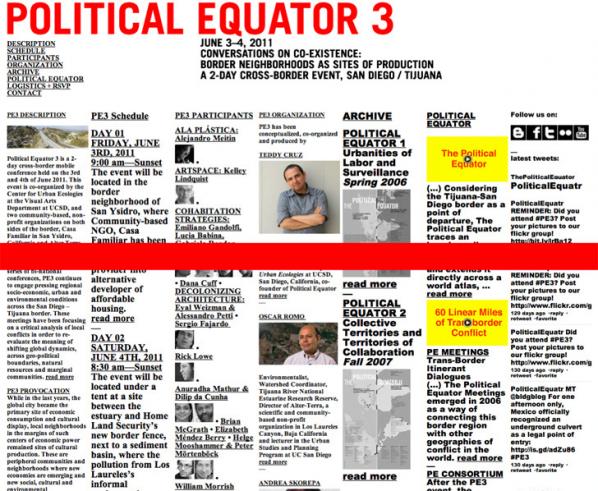
Lawrence Bird: Does any of this work intersect with American fear over border permeability to terrorism? The criticisms of TBT seem to focus on economic migration but the reaction bleeds into fears over security.
Ricardo Dominguez: TBT does crisscross a number of these types of affective conditions that have been floating around the border since 9/11; or one might push it back to early formations of the Mexico/U.S. border. And yes, it intersects with the growing state of fear in the U.S. (and around the world) about immigrants dismantling the U.S. economy – which has always struck me as extremely ironic – since as we have encountered in these past couple of decades, neo-liberal economics on a global scale have done much more to dissolve the romance of the nation via a series of self-made economic bombs than any immigrant “invasion.”
Lawrence Bird: In fact your development of this tool has come at a significant personal cost. You’ve been accused of supporting illegal activity and misuse of public funds. You’ve been called a traitor. Your position at UCSD was threatened. Could you talk about that and where this situation stands today?
Ricardo Dominguez: The entire group of artists who are part of Electronic Disturbance Theater 2.0/b.a.n.g. lab working on the Transborder Immigrant Tool (TBT) was being investigated by UCSD and 3 Republican Congressmen starting on January 11, 2010. Then I came under investigation for the virtual sit-in performance (which joined communities statewide against the rising students fees in the UC system and the dismantling of educational support for K–12 across California) against the UC Office of the President (UCOP) on March 4, 2010. This was then followed by an investigation by the FBI Office of Cybercrimes. So, it was three investigations in total— and they were all seeking to find a way to stop TBT and threaten to de-tenure me for doing the very work I was hired to do and then tenured for. In the end all the investigations were dropped. I did agree not to do another virtual sit-in performance on the UCOP for four years, but the day I signed the agreement, a number of supporters across the nation did a virtual sit-in on UCOP again. One strange element about the agreement that they wanted me to sign without even giving me or my legal team time to look it over was that I would never speak or write about what had happened, create any artwork that might disturb anyone and refrain from an artivist performances. Of course I agreed to none of it.
Lawrence Bird: The vitriol in the attacks on you is remarkable, and disturbing: you received a great deal of hate mail and a number of death threats because of this project. You mention in your play Sustenance (published in Artists & Activists 12) that these messages “constellate into remarkable patterns”, form a chart as it were of the agitated contemporary discourse over immigration, security, and national purity vs. liberty. It’s significant that you’ve built a play around this. Do you see the political and popular response to your project (you refer to it as “viral reportage”) as part of the TBT’s performative aspect?
Ricardo Dominguez: Part of the history of the Electronic Disturbance Theater 1.0/2.0 and b.a.n.g. lab (stands for bits, atoms, neurons and genes) at CALIT2/UCSD has been to develop works that can create a performative matrix that activate and take a measure of the current conditions and intensities of power/s, communities and their anxieties or resistances. So, for us the U.S. Department of Defense launching “info-weapons” at us for a virtual sit-in on September 9th, 1998 or the current confluence of “viral reportage” and the affective contagion of hate about the project that followed are all part of the performance – of course we would much rather the hate-mail never occurred – dominant media is bad enough to deal with. The aesthetics of working in the zones of post-contemporary artivist gestures cannot really escape these types of encounters; it is part and parcel of the patina of our work. But, we also feel that the hate mail or the general fear of losing national purity is co-equal in importance with the poetry that they were attacking. In fact Glenn Beck, an extreme right wing pundit on the Fox News Channel, attacked not only TBT’s use of poetry, but that the poetry itself had the power to “dissolve” the nation. The performative matrix of TBT allows viral reportage, hate-mail, GPS, poetry, the Mexico/U.S. border, immigrants, to encounter one another in a state of frisson – a frisson that seeks to ask what is sustenance under the sign of globalization-is-borderization.

Lawrence Bird: Can you tell us a little more about the poetry that accompanies the guidance system? How was this chosen, what does it concern? How do you envision the poetry developing as the project continues?
Ricardo Dominguez: Electronic Disturbance Theater 1.0/2.0 has always been invested in experimental poetry as part of its gestures – from the found poetry of the “404 file not found” of our ECD performances in 90’s to the border hack actions with the Zapatista Tribal Port Scan in 2000 on U.S. Border Patrol servers, where we would scan and upload Zapatista poems that we had written into their servers. When we started to develop TBT it became important once again to have a core impulse of the gesture. In 2008 I asked my partner, Amy Sara Carroll, who is an experimental poet and scholar, at University of Michigan, Ann Arbor – one of the areas of her research is on art and Mexican/U.S. border. She thought that TBT becoming a geo-poetic-system (gps) could expand the frame of experimental poetry and artivism. She then began to work with us and established two geo-poetic tracks – one conceptual and the other an echoing of desert survival manuals in multiple languages, which speaks to the multiple borders that are crisscrossing the planet and the multiple languages that are crossing Mexican/U.S. border via immigrants. Here is Amy speaking about TBT:
“…my collaboration with Electronic Disturbance Theatre (EDT) on the Transborder Immigrant Tool…(is) imagined as a global project under development, my own involvement in that ongoing process is linked to the question of what constitutes sustenance in the quotidian of the conceptual, on the varied musical scales of the micro- and macro-. For, often—rightly enough—conversations about crossing the Mexico-U.S. border refer to disorientation, sun exposure, lack of water. The Transborder Immigrant Tool attempts to address those vicissitudes, but also to remember that the aesthetic—freighted with the unbearable weight of ‘love’—too, sustains. A poetic gesture from its inception, the Transborder Immigrant Tool functions, via the aspirations of such a dislocative medium, as dislocative media, seeking to realize the possibilities of G.P.S. as both a ‘global positioning system’ and, what, in another context, Laura Borràs Castanyer and Juan B. Gutiérrez have termed, a ‘global poetic system.’ The Transborder Immigrant Tool includes poems for psychic consultation, spoken words of encouragement and welcome, which I am writing and co-designing in the mindset of Audre Lorde’s pronouncement that ‘poetry is not a luxury.’ … speaks to the Transborder Immigrant Tool’s overarching commitment to global citizenship. For, the excerpt, itself infused with the ‘transversal logic’ of the poetic, acts as one of the Transborder Immigrant Tool’s internal compasses, clarifying the ways and means by which I and my collaborators approach this project as ethically inflected, as transcending the local of (bi-)national politics, of borders and their policing.” http://bang.calit2.net/xborderblog/?tag=poetry
Here is a poem that made Glenn Beck extremely angry:
TRANSITION
(song of my cells)
Gloria Anzaldúa writes, “We have a tradition of migration, a tradition of long walks. Today we are witnessing la migración de los pueblos mexicanos, the return odyssey to the historical/mythological Aztlán” (1999 [1987]: 33). The historical? The mythological? Aztlán? It’s difficult to follow the soundings of that song. Today’s borders and circuits speak at “lower frequencies,” are “shot through with chips of Messianic time.” Might (O chondria!): imagine the chips’ transliteralization and you have “arrived” at the engines of a global positioning system—the transitivity of the Transborder Immigrant Tool. Too: when you outgrow that definition, look for the “trans-” of transcendental -isms, imperfect as overwound pocketwatches, “off”-beat as subliminalities (alternate forms of energy which exceed Reason’s predetermined star maps). Pointedly past Walden-pondering, el otro lado de flâneur-floundering—draw a circle, now “irse por la tangente”—neither gray nor grey (nor black-and-white). Arco-iris: flight, a fight. Of fancy. This Bridge Called my Back, my heart, my head, my cock, my cunt, my tunnel. Vision: You. Are. Crossing. Into. Me.
Here is a beautiful video version that Micha Cardenas and Elle Mehrmand did of the poem: http://bang.calit2.net/xborderblog/?p=49
In the strongest possible sense poetic practice has emerged in TBT that is co-equal with Brett Stalbaum’s idea of a “last mile” tool and his development of the code necessary to have it work. In fact we also think of the code-as-poetry as well – an expansion of codeswitching – literally.
Here is one of the desert survival poems:
En última instancia, muchos dirán que
la naturaleza establece el estándar de
la neutralidad. A diferencia de los seres
humanos, la naturaleza no hace lazos
de lealtad con la nación, la familia, los
negocios o la religión. Usted sabe bien
que el mayor peligro que enfrentará en el
desierto puede no ser el clima o el terreno.
Habrá quienes no tengan en consideración
su bienestar. Los rescatistas tienen el
compromiso de ayudar a quien lo necesite;
exíjales cumplir esa promesa. No confíe su
vida a nadie más, a ningún extraño.
All them are available in multiple languages to the user on TBT.

Lawrence Bird: How do you navigate the legal issues? Did you have a strategy in place ahead of time for dealing with these, or have you had to deal with them ad-hoc? Does your strategy/defense link up at any level with that of apprehended border-crossers?
Ricardo Dominguez: We are not attempting to navigate “legal” (national or international) issues – but we are trying to establish a reconfiguration of the border and immigration in terms of what we are calling transborder justice – the question of a “higher law” doctrine that David Henry Thoreau established in On Civil Disobedience. Also, in a more speculative manner as artists we see TBT as still in the process of becoming – it is still shape shifting and performing itself into potential spaces of use and poetics. TBT is border disturbance art that constitutes a visible geo-aesthetic/geo-ethics gesture against the boundaries and borderless borders that are crisscrossing every single body on the planet – we call for a geo-aesthetics that starts at the nanoscale and reaches to the GPS (Global Position System) grid system that floats around the planet, we call for a geo-aesthetics that connects both the human and the inhuman, geography and ethics, we call for a geo-aesthetics that crosses into and dislocates the smooth space of geo-spatial mobility with ethical objects for multiple forms of sustenance. We live in a world where only goods and services have rights to cross borders – a world that is a chaosmosis of markets that demand global exchange and aggressive state social filters. We need a geo-aesthetics that can construct ethical and performative complexities for the new earths to come, that can touch new geographies for new bodies – transbodies with transborder rights – artwork that can function as a geo-philosophy for bodies that are flowing as transborder bodies across all the borders the world – a flowing-trans-nation the planet cannot survive without.
Lawrence Bird: Have you considered applications of the TBT more globally, in Europe for example, or the Canada/US border, which has its own tensions relating to indigenous sovereignty? Or would this take it out of the specific politics you want to focus on?
Ricardo Dominguez: We imagine TBT’s code and gesture as open to use on multiple borders and that it is not bound to just the Mexico/U.S. border. One way that we have attempted to promote this possibility is by making the code available to anyone or any group at walkingtools.net.
Lawrence Bird: How extensively has your system been used on the Mexico/U.S. border? Or is it primarily rhetorical so far (it’s certainly been successful that way). How is it coordinated with others’ humanitarian efforts for border-crossers?
Ricardo Dominguez: On a very practical level our work with NGO’s has been focused on working with groups in Southern California who have established networks of water caches for immigrants crossing that area of the border – specifically Water Stations Inc. and Border Angels. Water Stations Inc., the longest running NGO working on this issue, has been very open to helping us test TBT and has also offered us extremely important insights into what the real conditions on the ground and what problems immigrants are facing. We recommend that if folks have funds to donate to these groups – please do. They were very wary of us at first – but they have now become much more supportive – especially because of the work that Brett Stalbaum and his partner, artist Paula Poole, have done in with them beyond TBT.
On the rhetorical end of the gesture much of the work that we do at b.a.n.g. lab is to start our research as a politics of rehearsal, a rehearsal of politics, as part of our art practice – to create an aesthetic of minor-signals and lower-frequencies…”like physics, aesthetics is a science whose primary object is signals, the physical materiality of signs….”– to quote from a recent tweet by Jussi Parikka. To manifest a type of science of the oppressed or engineering of the oppressed that imagines creating speculations that automatically, conceptually, begin to disturb not only the lines of thinking that criss-cross not only our bodies, but the ecologies of the Americas, and certainly the globe. And, so it becomes necessary to create these speculative disturbances that can allow one to think about another possibility, another impossibility, that these systems both manifest and, at the same time, call for an “anti-anti-utopian” potentiality, so that the engineering of the oppressed, the science of the oppressed, is about rehearsing the fictions that will then become realities. Our work in one sense is simply a gesture of “plagiarism”—a cutting and pasting of what is already an assemblage or a system that exists because immigrants are crossing multiple spaces around the world and GPS is everywhere in our cloudy global Empire. And so TBT itself is an attempt to create the multiple layers that manifest the social frictions, the speculative fictions, the rehearsal of politics, and of a counter-machine aesthetics—a machine of difference that can only really be performed by more than the multitude, if you will, to interrupt what Mary Pat Brady calls the U.S/Mexico border, “a state-sponsored aesthetic project.” We can see how these speculative gestures do create social responses on a global scale.
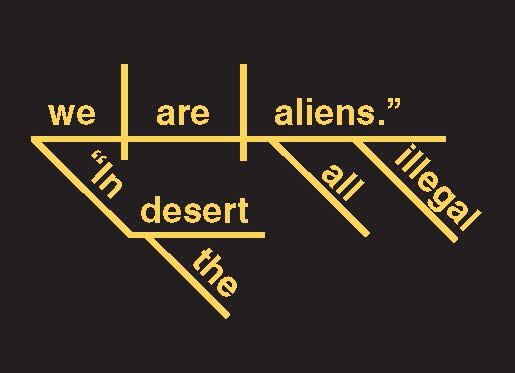
Lawrence Bird: TBT doesn’t just provide a map and way of locating oneself, it offers directions to various support services – where to find water, medical help. How are such safe sites managed and their position made public without making them vulnerable to border patrols? Are there any ethical issues involved here?
Ricardo Dominguez: The water cache sites are already well known by the U.S. Border Patrol, Homeland Security and anyone else who cares to take a trip along the Anza-Borrego desert in Southern California – in fact they have large flags signaling their locations. So TBT at this point is only doing one thing – offering the location of these known and established water caches – as a last-mile safety tool and nothing more. The cell phones we are using are not robust enough for anything else – now as more cheap high-end phones come on the market TBT will be able to offer more on multiple levels. So the ethical questions about TBT on the U.S. side of the border are not as complicated as those on the Mexico side of the border: these are questions about how TBT would interact with the coyote networks, would it be just one more material burden to those crossing, how does the extreme violence of the narco-war shut down the abilities of NGO’s etc., to work on distributing TBT with us – these questions seem much more important in terms of the ethics of the project – would it do more harm than good? Or is it a gesture that would offer a way out for some immigrants from the violence of these dangerous networks that they have to deal with in order to cross? At this point due to all last year’s issues we have not been able to formally present TBT to the immigrant communities preparing to cross to have a dialogue about these questions – but we are hoping to move forward with these encounters – sans any further investigations.
Lawrence Bird: And how has TBT been taken on the Mexican side – what is it’s perception on the part of Mexican citizens, politicians, media? I’m curious how their reaction compares to the response on the American side, which approached violence.
Ricardo Dominguez: It is difficult for us to access Mexico’s response to TBT in relation to coyote economies or the narco-war on the border – these are zones that we have not attempted to have conversations with or have correspondences with. But EDT 2.0 is concerned about how TBT might function within or alongside these violent enclosures that immigrants have to deal with on multiple levels. We do not want TBT to become an attractor for immigrants who are already targets for these groups. But what we can say is that Mexico’s dominant media and alter-media networks, from Tijuana to Chiapas, have been very responsive and supportive of TBT. One of the first awards TBT received was in 2007 from the new media arts festival Transito_MX, who awarded TBT the “trans-communities award,” and the award was handed to us by a representative of the U.S. Embassy in Mexico. So at this time the response to TBT is both unknown and known. Another concern that we have and that we hope to be able to have a better sense of by the end of the year is how the design works for immigrants, and to what degree do they consider it useful as an art work and “last mile” safety tool – this will be done via workshops with potential immigrants in Tijuana, Mexico. Also one of the core questions we will have, based on all the materials that immigrants leave in the desert while crossing – the heat and difficulty of crossing call for dropping as much away from the body as possible, from money, to telephone numbers, to pictures of loved ones, etc. – is one more thing to weigh one down really necessary? These are EDT 2.0’s concerns at this time in relation to the border on the Mexican side.
Lawrence Bird: You mention that what drives border crossers is a hope that amounts to a “hope for the unknown”? Could you elaborate on this? At any level do you see a contradiction between this and the technologies of transparency, like GPS?
Ricardo Dominguez: The radical gesture of transparency was extremely important to EDT 1.0 in relation to Electronic Civil Disobedience as theory and practice and it still is in relation to the general distribution of TBT – who were are, where we are, and why we are doing it. But we are also very interested in the notion of translucency as an aesthetic possibility for TBT that functions to dislocate the readability of GPS (Global Positioning System) and gps (a geo-poetic system) – a minor form of the technology that is no longer bound to the total vision of GPS that is now embedded in almost everything. This translucency functions as a single-bounce GPS that initiates the database of TBT and then shuts off – thus making triangulation impossible – unless the user decided to turn the function on during the crossing. TBT’s gps creates an aesthetic disturbance that dislocates GPS as a transparent device and instead offers a navigational translucency of the “last mile” with hope-as-sustenance as its guiding wave-point.
Lawrence Bird: In Sustenance you refer in passing to Baudrillard’s “desert of the Real”. It’s a compelling way of looking at the border desert where migrants are abandoned in their pursuit of the American fantasy. But adopting a perhaps more humanist attitude, would it be remiss to recall Saint-Exupéry’s words that “Ce qui embellit le desert…c’est qu’il cache un puits quelque part.” / “What makes a desert beautiful is that, somewhere, it hides a well.” Perhaps based on that juxtaposition, how would you place your project in relation to the tension between poetry, activist politics, and humanitarianism?
Ricardo Dominguez: TBT is still in a (gps) process of becoming – it is still shape-shifting and performing itself into potential spaces of use for activists and expanding the frame of dislocative poetics. TBT is border disturbance art that constitutes a waterwitching tool that indeed crosses the desert of the Real, the hard simulations of the border which seek to target and kill. It offers another possibility – with the anti-anti-utopian offer of the desert’s “beauty” that you are keying into the conversation. We imagine that this gesture echoes practices that fractalize the desert’s geo-aesthetics as: artivism, tactical poetries, hacktivism(s), new media theater, border disturbance art/technologies, augmented realities, speculative cartographies, queer technologies, transnational feminisms and code, digital Zapatismo, dislocative gps, intergalactic performances, [add your own______].
